October 31, 2010
The Marriage of Figaro, Theatre Royal, Glasgow
By Kate Molleson [Guardian, 31 October 2010]
Those three stars are a midway compromise: Scottish Opera's new Figaro is great on stage, shoddy in the pit. Maybe the dichotomy's apt for an opera about the foibles of above/below stairs relations - certainly conductor Francesco Corti seemed happy for singers and orchestra to have little to do with each other.
Song for the shoppers
By Peter Dobrin [Philadelphia Inquirer, 31 October 2010]
A flash mob hit Macy's in Center City Saturday - 650 vocalists who, unbeknownst to shoppers, had arranged to burst into song at noon.
October 30, 2010
Lyric Opera tackles tragic ‘Norma’
By Patrick Neas [KansasCity.com, 30 October 2010]
Dame Joan Sutherland, who died recently at 83, helped revive bel canto, that deliriously virtuosic brand of opera that flourished at the beginning of the 19th century.
October 29, 2010
A Quiet Place, New York City Opera, New York
By Martin Bernheimer [Financial Times, 29 October 2010]
Poor Leonard Bernstein. He wanted so much to be another Gustav Mahler. He ended up being another Leonard Bernstein.
Wagner: Wesendonck-Lieder, Preludes and Overtures
Cover art design in those days was an integral part of excitement and appeal of purchasing classical music recordings. No more. Orchestras make exponentially fewer recordings than they once did, and when one is produced, the cover is likely to be similar to the one Deutsche Grammophon provides for a recent CD of Franz-Welser Möst conducting the Cleveland Orchestra in Wagner preludes and overtures, with Marsha Brueggersoman as soloist in the Wesendock-Lieder. The cover photograph has the boyish conductor holding aloft the smiling singer’s hand before standing members of the orchestra. This is also Deutsche Grammophon’s only clear cover notice that the performance was recorded live. Unfortunately, the perfunctory nature of the packaging is all too indicative of the musical performance within.
Welser-Möst’s conducting tends to veer from abrupt interventionism (highlighting an odd orchestral detail or opting for an unexpected tempo adjustment) to passages of skilled but staid professionalism. The disc opens with the Rienzi overture. The clear, crisp recorded sound allows the listener to share in Welser-Möst’s sudden interest in this wind figure here, or the string accompaniment there. Ultimately, the key to a great performance of this overture should be the ability for the nobility of the main tune to sweep away the listener into vaguely tragic-heroic reveries. That quality Welser-Möst cannot produce.
The Tristan und Isolde selections lack sensuality, and though the Lohengrin preludes are immaculately performed, they are cold in effect. Even the closing Ride of the Valkyries evokes technical admiration without getting the blood racing.
Vocal enthusiasts may opt for the disc solely for the roughly 20 minutes of Marsha Brueggergosman’s elegant performance of the Wesendonck-Lieder. Her tone is rich but never hooty, and she has complete security throughout her range.
An original and imaginative cover couldn’t make the overall impact of this CD any greater. Those with deep collections might break out their Wagner overture and prelude sets conducted by Dorati, or Tennstedt, or Klemperer, or...
Chris Mullins
image=http://www.operatoday.com/DG4778773.gif
image_description=Richard Wagner: Wesendonck-Lieder, Preludes and Overtures
product=yes
product_title=Richard Wagner: Wesendonck-Lieder, Preludes and Overtures
product_by=Measha Brueggergosman, mezzo-soprano. The Cleveland Orchestra. Franz Welser-Möst, conducting.
product_id=Deutsche Grammophon 000289 477 8773 0 [CD]
price=$16.49
product_url=http://www.arkivmusic.com/classical/album.jsp?ordertag=Perfrecom139270-474514&album_id=482160
New York Festival of Song
He was talking from the stage about the day mezzo Sasha Cooke walked into his office fresh off the boat from Texas and the day tenor Paul Appleby waltzed in from Indiana. And another hundred people just got off of the train…. If they are terrific singers, I hope they turned to the New York Festival of Song (NYFOS). I can’t imagine why they wouldn’t.
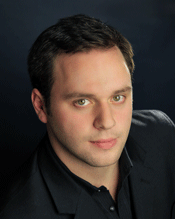 Paul Appleby [Photo by Ken Howard]
Paul Appleby [Photo by Ken Howard]
The first concert of this year’s series was devoted to youth, and
specialized accordingly in songs not merely about youth but often those
composed by very young composers, composers who went on to bigger things. But
those of us who love early Verdi operas and early Rodgers & Hart musicals
and the Grateful Dead before they were everywhere appreciated the
connoisseurship of reveling in very young Fauré and Schumann and Rorem and
Busoni and Grieg and Ives and Sondheim—and slightly older Gershwin and
Dylan. What themes inspire young composers to give a hint of how worthwhile
they will become? Is it all lindenbäumen and young love’s first
blight? Or is it … anticipation?
I first noticed Sasha Cooke when she sang the Sandman in the Met’s otherwise vocally undistinguished new Hänsel und Gretel, a moment of childlike magical glee, just right for Humperdinck. In a tiny hall like Merkin with its very live acoustic (when a small chorus sings there, you can hear each individual voice), she sounds quite different: Her voice is enormous, plush, lustrous, easily so, and perfectly supported. For most of a song recital, of course, she scales it back to merely very pretty, but whenever she reached an appropriate climax, restraint falls away like a superfluous shawl, and the results are resplendent—intimate, but hugely intimate. As an interpreter, she had the most fun becoming a small child for Ned Rorem’s “A Journey,” the bashful maiden boasting of her first conquest in Grieg’s “Verschwiegene Nachtigall,” where she slipped flawless little ornamental turns into the nightingale’s insinuating “Tandaradei,” the rather more sophisticated maiden of Hugo Wolf’s “Begegnung,” the aching hopefulness of Sondheim’s “Take Me to the World,” and—in duet with Appleby—the breathless expectant wonder and the contrasting, consummated coda of Charles Ives’s delicious “Memories” (“We’re sitting in the opera house”). She is a singing actress to anticipate and a voice to hear one of these days in a place where she can let it fly.
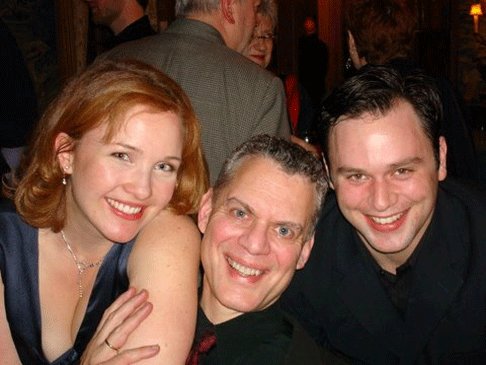 Sasha Cooke, Steven Blier and Paul Appleby
Sasha Cooke, Steven Blier and Paul Appleby
I haven’t heard Paul Appleby on the opera stage and, frankly, his voice seems (like Cooke’s) too delicious, too full-sized, too able to only be a concert singer, first rate as he is at that subtle skill. He has a smooth, supple delivery and inhabits his narrators: reveling in Schubert’s matchless invention in “Geheimnis” (Schubert was 19 at this point, almost an old master: the song is already D.491) and Vaughan Williams’s “Silent Noon.” Then, in moves and accent and exultant manner, he became with entire believability a Midwestern youth come to take the city by storm in Christopher Berg’s rollercoaster setting of Frank O’Hara’s “I’m Going to New York,” then cocky with adolescent sexual discovery in William Bolcom’s setting of Theodore Roethke’s “I Knew A Woman” and bitter with youthful disillusion in Marc Blitzstein’s “In the Clear.” His voice has power, but he holds it in reserve when portraying character; it comes out in songs like Paul Moravec’s setting of Wordsworth, “My Heart Leaps Up.”
Later concerts this season will be devoted to Songs of Gay Life and Songs of the Iberian Peninsula. Spain has been a NYFOS destination before, but we are unlikely to run low on little-known Iberian song literature anytime soon.
John Yohalem
image=http://www.operatoday.com/Sasha-Cooke-2---photo-credi.gif image_description=Sasha Cooke [Photo by Nick Granito] product=yes product_title=New York Festival of Song product_by=Sasha Cooke, mezzo-soprano; Paul Appleby, tenor. Steven Blier and Michael Barrett, pianos. Merkin Concert Hall at Kaufman Center, New York. Performance of October 19. product_id=Above: Sasha Cooke [Photo by Nick Granito]October 28, 2010
The Met’s Boris Godunov: René Pape sizzles, Mussorgsky’s scoring fizzles
By David Abrams [cnycafemomus.com, 28 October 2010]
Listening to mostly male voices (and basses at that) delivering recitatives and monologues in Russian for four and a half hours can be enough to, well, foment a revolution. Perhaps that’s why master-orchestrator Rimsky-Korsakov twice revised Mussorgsky’s bland musical score to Boris Godunov, injecting color and fizz in an attempt to sustain musical interest throughout the lengthy epic drama.
Kafka at the Opera: Bartlett Sher’s Production of Hoffmann at the Met
But, considering the number of people involved — hundreds of artists and craftsmen onstage and off as well as thousands in the audience at each performance — it is impossible for a production in a large house to fulfill all of the expectations that rise up inside of us the Metropolitan Opera’s signature chandeliers. What is the mark of a good production, especially in a large house? On the one hand, opera involves the energies and resources of many people and, therefore, the hope is that this investment of talent and money will pay off over the course of many seasons despite both rotating casts and changing tastes. However, the thrill of any live performance is its singularity. Part of the allure and, indeed, the satisfaction of seeing an opera (even now in the era of the simulcast) is the ability to stand witness and say “I was there when...” Good directors recognize the challenge of building a show that can stand the test of time but also showcase the particular talents at any given performance.
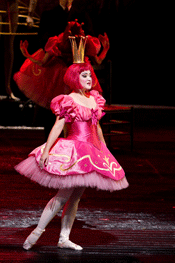 Anna Christy as Olympia
Anna Christy as Olympia
In the instance of the Metropolitan Opera’s recent production of
Offenbach’s Les Contes d’Hoffmann (seen here on October
12, 2010), directed by Bartlett Sher, the premiere performances in the winter
of 2009 were disappointing compared to Sher’s invigorated Il Barbiere
di Siviglia (also for the Met) and his stunning Lincoln Center production
of South Pacific. With a few exceptions, the cast seemed to be square
pegs in Sher’s Kafka-shaped holes. Typically compelling performers seemed
unmoored among the shows many disparate cultural allusions. Joseph Calleja, who
stepped into the title role on relatively short notice, and Anna Netrebko (as
both Stella and Antonia) seemed most at sea. Without a surer sense of the
opera’s protagonist and the framing device of his love for the diva
Stella, the opera quickly descended towards pastiche.
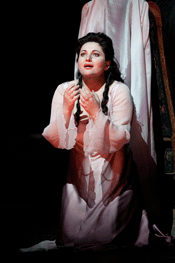 Hibla Gerzmava as Antonia
Hibla Gerzmava as Antonia
A second viewing this season, however, showed Sher’s adaptation in a
much more flattering light. Moments that previously fell flat sparkled and,
while the Kafka parallel still seems arbitrary at times, the interpretive
choices gave a challenging work some new pizzazz. Given the constants of the
production, it is reasonable to conclude that the new energy in his
Hoffmann came from the evening’s individual performances. In the
title role, Giuseppe Filianoti was both sympathetic and impish, showing
heartache through humor in the tradition of Charlie Chaplin. During the tavern
scene at Luther’s, the tenor carried himself with the energy of a man
itching for a fight — even if happens to be with his best friend. The
role is vocally demanding as well as a dramatic challenge and Filianoti sang
with definite style, if not always ease, throughout the entire evening. He and
Hibla Gerzmava made thrilling sounds together and were as appealing visually as
they were aurally. Gerzmava lacked some of the character definition desired for
Stella, but definitely rose to the occasion as Antonia. Thanks in large part to
her gracious singing and acting, Act II could have been performed as a
satisfying dramatic event on its own.
As in the premiere performances, Kate Lindsey epitomized mystique in the dual role of the Muse and Nicklausse. She sings and moves with an energy appropriate for a large house while maintaining a sense of realism in her acting that feels intimate. Occasionally overpowered by the orchestra, Lindsey is a singer with great dramatic and musical finesse. As an actress, the role suits her perfectly and, with the exception of a few vocal distractions, it is easy to slip into believing she is the Muse.
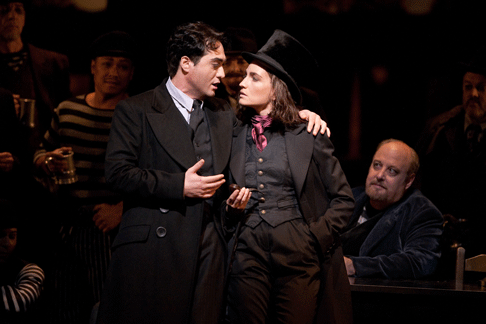 Giuseppe Filianoti in the title role and Kate Lindsey as Nicklausse
Giuseppe Filianoti in the title role and Kate Lindsey as Nicklausse
Both Elena Mosuc and Enkelejda Shkosa, who sang Olympia and Giulietta, are Met debutantes this season. Of the two, Shkosa made the stronger first impression. As the luscious but avaricious courtesan, she exhibited a wealth of vocal riches as well as a real sense of comedy. Her voice has substance as well as style and her aria was rich and creamy enough to pass as the evening’s dessert. In contrast, Mosuc’s turn as Olympia fell flat. As hard as it must be to play an amusing and engaging automaton, both Kathleen Kim and Rachele Gilmore proved in their performances of this production last year that it can indeed be done.
Ildar Abdrazakov relished the wickedness of the four villains and his performance included several impressive evil laughs. Joel Sorenson performed all four servants with aplomb but his Frantz was particularly notable for being both musically satisfying and genuinely funny.
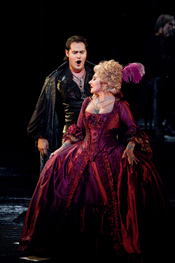 Ildar Abdrazakov as Dapertutto and Enkelejda Shkosa as Giuletta
Ildar Abdrazakov as Dapertutto and Enkelejda Shkosa as Giuletta
Of the evening’s debuts, perhaps the most significant was that of
conductor Patrick Fournillier. With only a few exceptions, his tempi moved
briskly enough to keep the action going without becoming frenetic. The chorus
was well-prepared musically by Donald Palumbo, but they were disappointingly
generic for a large group dressed up as circus freaks and students, especially
when compared to the remarkably specific performances Sher evinced from his
actors in South Pacific.
The sets by Michael Yeargan effectively represented a sort of theatre of the mind. Costumes by Catherine Zuber included a few especially titillating supernumeraries and dancers, but also included an awkward ensemble for Antonia’s mother (more than capably sung by Wendy White). Duane Schuler’s lighting did much to evoke mood and smooth over transitions, but it would have been interesting to see both the lighting and minimal projections used to further the reference to Federico Fellini that Sher mentions in his director’s notes. In fact, with his idiosyncratic, fantastic style and his penchant for both autobiographic material and female muses, the Italian director seems a more direct parallel to the character Hoffmann than does the enigmatic outsider Franz Kafka. Even with the newly energized performances, this production of Hoffmann may grow old quickly, especially for those with the ability to see beauty as Kafka described it.
Alison Moritz
image=http://www.operatoday.com/HOFFMANN_Filianoti.gif image_description=Giuseppe Filianoti as Hoffmann [Photo by Marty Sohl courtesy of Metropolitan Opera] product=yes product_title=Jacques Offenbach: Tales of Hoffmann product_by=Hoffmann: Giuseppe Filianoti; The Muse of Poety/Nickausse: Kate Lindsey; The Four Villains: Ildar Abrazakov; Olympia: Elena Mosuc; Antonia/Stella: Hibla Gerzmava; Giulietta: Enkelejda Shkosa; The Four Servants: Joel Sorenson; Luther/Crespel: Dean Peterson; Hermann/Schlemil: Jeff Mattsey; Nathanael/Spalanzani: David Cangelosi; Antonia's Mother: Wendy White. Conductor: Patrick Fournillier; Director: Bartlett Sher. product_id=Above: Giuseppe Filianoti as HoffmannAll photos by Marty Sohl courtesy of Metropolitan Opera
Ladies first: Muhly's "Dark Sisters" precedes "Two Boys" as US opera debut
By Anne Midgette [Washington Post, 28 October 2010]
Back in June, when I wrote about small-scale opera productions and the future of contemporary opera, the powers-that-be were not yet ready to announce a new project that epitomizes what I was writing about.
October 27, 2010
Piotr Beczala: Roméo et Juliette, Royal Opera
Hence the reputation of this opera has rested on its showpiece arias, and on good performances. Piotr Beczala defined this production at the Royal Opera House, London with an excellent Roméo, well shaped vocally and expressively full of character.
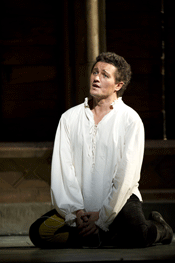 Piotr Beczala as Roméo
Piotr Beczala as Roméo
Beczala is relatively new to Roméo, having created it at Salzburg in 2008,
and again in August 2010. Nino Machaidze sang Juliette at Salzburg this year
too, at later stages of the run, which started with Anna Netrebko and Beczala.
Pairing Beczala and Machaidze for the London production was an inspired choice.
Although the productions in Salzburg and London are completely different,
Beczala and Machaidze carried over what they’d built previously.
The London production is Stephen Barlow’s revival of Nicholas Joel’s production, revived only for the second time since 1994.The sets are like picture postcards, and the pace of movement staid, almost unnatural. It’s worrying when the most vivid scenes are choreographed by the Fight Director, Philip Stafford. Admittedly, Gounod’s treatment of Roméo et Juliette doesn’t lend itself to intellectual depth, but fortunately Beczala amd Machaidze injected enthusiasm into the production.
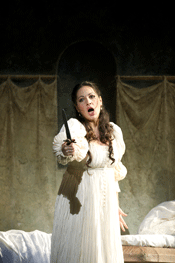 Nino Machaidze as Juliette
Nino Machaidze as Juliette
Beczala’s Roméo defined the performance. Excellent pitch control,
luscious timbre. A wonderful and deeply expressive “L’ amour, oui,
son ardeur a troublé tout mon être!”. The love duets were beautiful, even
if Beczala overshadowed Machaidze’s Juliette. Still, that’s not
surprising, as he’s just more experienced. With Netrebko he must have
been superb. In the last act, Beczala’s “Salut, tombeau sombre et
silencieux!,” was well modulated, emotionally profound. marred very
slightly when he had to turn backwards, projecting sound awry. I loved
Beczala’s Shepherd in Szymanowski’s Król Roger and enjoyed
hearing him develop over the years. Romantic Heroes are now his forte, but he
has the depth, I think, to eventually tackle Heldentenor territory.
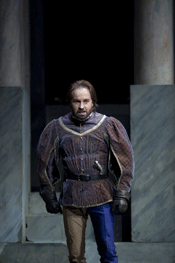 Alfie Boe as Tybalt
Alfie Boe as Tybalt
Machaidze looks like Olivia Hussey in Franco Zeffirelli’s 1968 film of Romeo and Juliet, which adds piquancy to her portrayal. Her voice is light and agile, the brightness of her timbre expressing Juliette’s youthful innocence, her firm lower register expressing the wilder parts of Juliette’s character. Like many 14 year olds, Juliette does extremes, as Shakespeare observed. Machaidze may not have the polish of many much more famous and experienced singers but she’s convincing
enough. When she sings of waking too soon, holding Tybalt’s bloodstained hand, she sings with such fervour that you realize that this Juliette knows what risks she’s taking. Sweet as she is, Machaidze’s Juliette has a brain.
Good performance standards all round. Darren Jeffrey as Capulet towers physically over the other players, which is as well, for Gounod develops the part well. Vitalij Kowaljow’s Frère Laurent was also notable and Stéphane Degout as Mercutio.
Ketevan Kemoklidze’s Stéphano, Roméo’s Page, makes a delightful impression in the song about doves and vultures, but artistically the vignette adds little.
Alfie Boe as Tybalt received prolonged applause which he acknowledged as if he were a principal. He has a huge following because he does popular song but that adulation might be his undoing. Not long ago a fan complained when he was unwell and couldn’t adequately be replaced. That kind of audience isn’t into opera as such, but in chasing celebrity.
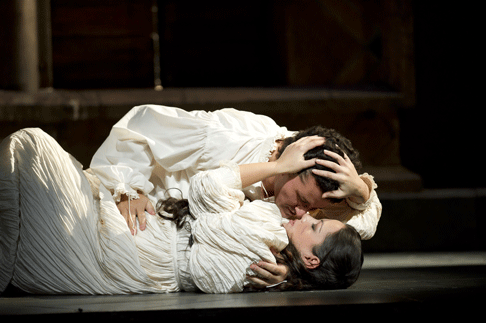 Piotr Beczala as Roméo and Nino Machaidze as Juliette
Piotr Beczala as Roméo and Nino Machaidze as Juliette
Gounod’s choruses are justly celebrated and the Royal Opera House chorus responded well. Here they were directed to maximum advantage, and as usual, their performance was well executed.
For more information, please see the Royal Opera House website.
Anne Ozorio
image=http://www.operatoday.com/R%26J---BC20101023530.gif image_description=Piotr Beczala as Roméo and Nino Machaidze as Juliette [Photo by Bill Cooper courtesy of The Royal Opera] product=yes product_title=Charles François Gounod : Roméo et Juliette product_by=Roméo: Piotr Beczala; Juliette: Nino Machaidze; Capulet: Darren Jeffrey; Gertrude: Diana Montague; Frère Laurent: Vitalij Kowaljow; Tybalt: Alfie Boe; Mercutio: Stéphane Degout; Stéphano: Ketevan Kemoklidze; Gregorio: James Cleverton; Duke of Verona: Simon Neal; Paris: Zhengzhong Zhou. Chorus and Orchestra of the Royal Opera House. Chorusmaster: Renato Balsadonna. Conductor: Daniel Oren. Revival Director: Stephen Barlow. Set designer: Carlo Tommasi. Lighting: Bruno Boyer. Fight Director: Philip Stafford. Royal Opera House, London. 26 October 2010. product_id=Above: Piotr Beczala as Roméo and Nino Machaidze as JulietteAll photos by Bill Cooper courtesy of The Royal Opera
October 26, 2010
With a Double Bill, a Return to Rarities
By Steve Smith [NY Times, 26 October 2010]
The stars were out in force at Carnegie Hall as the Opera Orchestra of New York opened its 40th-anniversary season with a gala double bill on Monday night. Not so long ago, the chances that this landmark might be reached seemed slim indeed. Facing financial difficulties in 2008, the orchestra suspended its long-running tradition of presenting operatic rarities in full concert performances. Since then, it has maintained a slighter profile with recitals.
October 24, 2010
Boris Godunov, Metropolitan Opera
There were standing ovations for both Pape and Chorus. Both deserved it. So did most of the rest of the singers, the orchestra, and Maestro Gergiev. It was a night of glorious music-making, a glorious score brilliantly done by, and in the original orchestration to boot. (But the original orchestration has been in use at the Met since 1974.)
And yet—I cannot call it an entirely successful presentation of this opera.
Mussorgsky’s sprawling tragedy has two protagonists: The haunted tsar is one— he only appears in three or four scenes (depending which version is used) but he stamps his personality on the grand opera canvas. The other? the Russian people, who hail Boris as a symbol of hope, then revile him as the “Tsar Herod” whose crimes have brought the anger of heaven down on Russia. Boris ultimately goes mad and dies, but much worse is in store for Russia in the eight years that will follow the final curtain: plagues, famines, massacres, wars, usurpers: three of the opera’s many lesser characters will ascend the throne and come to bad ends, two foreign invasions and occupations of Moscow—and only then, when they’ve given up all hope, the Romanovs will take over. (You can find out all about this in Dvorak’s Dmitri and Glinka’s A Life for the Tsar. I don’t think anyone’s ever composed an opera about slimy Prince Shuisky, who became Vassili IV.)
Boris has been called the Russian Macbeth. He’s an ambitious man, full of excellent intentions, who commits a serious crime in order to take power in his troubled country—only to be haunted to madness by the horror of his deed. No one knows if the real Boris slew the heir to his brother-in-law’s throne, and in Pushkin’s play, the source of the opera’s libretto, Boris himself isn’t sure. But of his ambition, of his scheming route to the coronation in the opera’s prologue, we are left in no doubt. This makes his uneasiness at the appearance of a pretender to the dead boy’s identity, his gradual descent into madness torn between insecurity and hope for heavenly forgiveness (if the boy was not slain), the tragic foreground of a plot that ranges across seven years of disaster and a great geographic space as well. Boris’s death in the penultimate scene (which Chaliapin and others placed at the opera’s conclusion for reasons of drama and egomania) is his personal tragedy; Mussorgsky’s final scene shows the rebellious peasants welcoming the pretender as they avenge their brutal circumstances on anyone available.
That finale has never been staged so graphically: captured boyars have their throats slit, Catholic priests are lynched, women taunt and spit in the faces of spies and bullies, and the Polish forces move slowly, inexorably on Moscow. Singing magnificently, the Met Chorus works its dramatic chops in a tableau of barbarism.
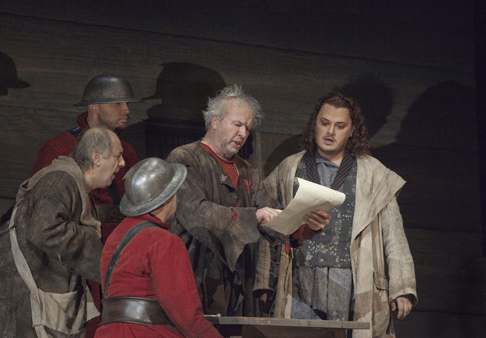 Vladimir Ognovenko as Varlaam and Aleksandrs Antonenko as Grigory
Vladimir Ognovenko as Varlaam and Aleksandrs Antonenko as Grigory
The new production was straightforward and inoffensive—but makes one sigh for the glitter of Ming Cho Lee’s onion domes and marble fountains in the last Met Boris. In certain important points Stephen Wadsworth’s direction seemed not so much spare as actively wrongheaded. Symbolic of the whole puzzling occasion was the row of enormous church bells that descends from the roof of the stage at the end of the Coronation Scene, just as the sound of those pealing bells with their rejoicing that we already suspect is ill omened, explodes from the orchestra—but the visible bells do not move. Bells that do not move make no sound. Why show them? Why contradict the music so blatantly? Why give us scenery and ignore it? Couldn’t they have been made to move, even if they did not sound? Or, to save money, couldn’t they have not appeared at all, only sounded?
Wadsworth had a mere five weeks to put an interpretation together after Peter Stein withdrew, but though he boasts of forty years acquaintance with the opera, he seems to have misunderstood it on a basic level. This Boris is not the titanic figure we have come to expect, the vehicle who made Chaliapin and George London and Martti Talvela into stage legends. This Boris is nervous, wishy-washy, thrust into power he has not sought—which gives us a hollow place at the center of the drama. During the pious speech at the coronation, when most Borises utter hollow protestations to God while grasping the crown, Pape seems actively uncomfortable to be handling it at all. Then why does he have it? Why did he have the police badger the peasants to demand he take it? Plenty of other boyars would like it. Too, he enters with his young children, who appear and sing (in play and opera) only in the contrasting domestic scene in the Kremlin. As a result of their appearance here (which I attribute in part to Wadsworth running out of ideas and a stage space that can only be called claustrophobic—and it’s supposed to be Red Square, for God’s sake!), since we never see the children grow any older, the story’s duration is necessarily telescoped from seven years to a few weeks, which hardly seems time enough for the Russians to be starved into rebellion. The story Pape and Wadsworth give us is not a tragedy, or a legend on monumental scale—it is a minor domestic matter.
This makes a mockery, too, of the enormous Book of History (I’m guessing; some of its pages also bear music notation) that occupies an enormous place on the floor of the stage, so that Pimen can write in it, Gregory/Dmitri look over his shoulder, Marina can sneer at it, the Holy Fool try to warm himself in it as if among parchment blankets, and all the Russian masses trample over it uncaring. Feodor Godunov’s map, too, is scattered about the floor. (This is one of Pushkin’s nods to historical trivia: the first map ever made of Russia was drawn by the 15-year-old tsarevich. In Ming Cho Lee’s Kremlin, it was reproduced on the wall.) The focus here is on human beings just like us—but they aren’t much like Pushkin’s human beings, and Mussorgsky was composing for those.
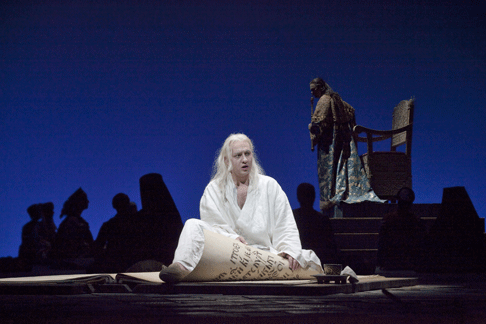 Mikhail Petrenko as Pimen and René Pape (background) as Boris
Mikhail Petrenko as Pimen and René Pape (background) as Boris
Despite this wrongheaded straitjacket of an interpretation, Pape holds our ears and eyes throughout the evening. He is a superb actor and singer whose Russian was impressively idiomatic, but who moves in this production only from depressed to severely depressed, not from grandeur and triumph to dust, ashes and madness. I’d love to see Pape in a more plausible interpretation of the character.
Chaliapin’s vision of ghostly Dmitri used to terrify everyone who saw it, but I remember a shudder ran through the audience when the Holy Fool called Martti Talvela “Tsar Herod” and he responded with a galvanic shock. In this production, though Andrey Popov’s singing and acting are all one could desire in a Fool, the arrangement of the stage, with all action shoved to the front by featureless walls, does not permit the proper effect to be made. This is Boris Godunov intimate—and ignores the fact that this is a grand opera, demanding all the flourishes and scenic spectacles of the nineteenth century’s mightiest form.
There is no ballet to speak of in the Polish scenes in this production, either. The Polish scenes are set musically as well as dramatically in another world from Muscovy: Western, Roman Catholic, enlightened, unRussian, all the things Mussorgsky (and the Russian in the street) were raised to loathe. The Polish-Lithuanian republic was the largest state in Europe in 1605, and they made use of Dmitri to bring Muscovy into the Polish and Roman orbit. Neither Dmitri nor the Poles have ever been forgiven for their perfidy— to this day, Grishka Otrepev (Dmitri) is solemnly cursed in the Anathema liturgy of the Russian Orthodox Church.
In this production we know the Poles are in a different world from the Russians because the Russians wear costumes in color, roughly of the proper period (c.1600), but the Poles are dressed c. 1800, and all of them wear white except Marina and Father Rangoni, who wear black, the latter with sinister purple gloves: the Jesuit as vampire. To stress that he is evil, as if Mussorgsky had not made that quite clear enough with his snaky music, sturdy Evgeny Nikitin also has his slimy hands all over Marina’s body. (For the first thirty years the opera was performed in New York—which has a huge Catholic population, after all—the role of Rangoni was simply omitted so as not to give offense.) The operagoer in the street, the Met seems to assume, has forgotten the Jesuit’s legendary gift for intrigue, so they have replaced it with the new popular myth of the Catholic priest as constant lecher. (I’m not criticizing; I think it’s interesting to track the evolution of legend.)
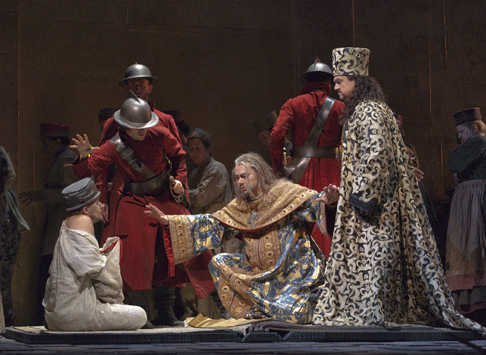 Andrey Popov as the Holy Fool, René Pape as Boris and Oleg Balashov as Shuisky
Andrey Popov as the Holy Fool, René Pape as Boris and Oleg Balashov as Shuisky
Among the enormous and memorable cast, I especially enjoyed Mikhail Petrenko’s Pimen during his appearance before the tsar, Vladimir Ognovenko’s mellifluously blustering Varlaam, Jennifer Zetlan and Jonathan Makepeace as the tsar’s children (though I’d have liked them better had they only appeared in scenes where Mussorgsky calls for them), Valerian Ruminski’s effective Nikitich and Ekaterina Semenchuk’s Marina. Semenchuk, in particular, the superb Olga of the Met’s last Onegin, has a very beautiful and very Slavic lower register and makes a striking figure (in black against the Polish white). Aleksandrs Antonenko has a “Russian bleat” to his tenor that is not attractive as sheer sound but which he uses effectively to indicate the torture of conflicting passions (revenge, ambition, lust): an exciting if not a moving performance. Oleg Balashov, who plays Prince Shuisky, a great character role, has a pretty voice but sings without projecting the plot or the personality; I wish he and Andrey Popov’s sublime Holy Fool could have switched roles, but what’s a Boris without an excellent Fool?
All the production’s visible miscues can be ignored when a cast like this, a chorus like this, an orchestra like this are led by a conductor who can calculate Mussorgsky’s defiantly barbaric nuances as stunningly as this. It’s a great show, and while Gergiev is conducting it, and a singing actor like Pape, however oddly directed, holding the Kremlin against all comers, Boris is not to be missed.
John Yohalem
image=http://www.operatoday.com/BORIS_Pape_as_title_role_02.gif image_description=René Pape as Boris Godunov [Photo by Ken Howard courtesy of The Metropolitan Opera] product=yes product_title=Modest Petrovich Musorgsky: Boris Godunov product_by=Boris: René Pape; Marina: Ekaterina Semenchuk; Xenia: Jennifer Zetlan; Innkeeper: Olga Savova; Feodor: Jonathan Makepeace; Grigory/Dmitri: Aleksandrs Antonenko; Holy Fool: Andrey Popov; Nikitich: Valerian Ruminski; Prince Shuisky: Oleg Balashov; Pimen: Mikhail Petrenko; Varlaam: Vladimir Ognovenko; Rangoni: Evgeny Nikitin. Production by Stephen Wadsworth. Chorus and orchestra of the Metropolitan Opera, conducted by Valery Gergiev. Performance of October 18. product_id=Above: René Pape as Boris GodunovAll photos by Ken Howard courtesy of The Metropolitan Opera
Gilbert and Sullivan opens Arizona Opera
Although the work had been seen once in Britain for copyright purposes, it was officially premiered on New Year’s Eve of 1879 at New York City’s ‘Fifth Avenue Theatre,’ which was actually located at 28th street and Broadway. Reviews were extremely favorable even though some critics noted that Gilbert had used some story elements from his one act piece, Our Island Home, and Sullivan took the music for the chorus, ‘Climbing over Rocky Mountain,’ from his earlier composition, Thespis. In December 1879, Sullivan wrote: ‘I think it will be a great success, for it is exquisitely funny, and the music is strikingly tuneful and catching.’ He may not have been all that modest, but over a century later the statement is still true.
Since, at that time there was no copyright protection in the United States, having the official premiere there allowed Gilbert and Sullivan to keep American theatrical companies from assembling their own productions and stealing the creators’ profits. Of course, American companies did eventually tour with the operetta, but at least the first production’s profits went to the work’s librettist and composer. The Pirates of Penzance opened at the Opera Comique in London on 3 April 1880 and ran for an entire year.
David Ira Goldstein, who has headed The Arizona Theater Company for the past nineteen years, directed Arizona Opera’s presentation. In this, his first stint with an opera company, he told the story in a manner that put a great deal of emphasis on visual values and there were times when he had his singers executing complicated moves while singing. For example, Sarah Jane McMahon who sang Mabel turned cartwheels during an aria. She has a fine voice, however, and her parody of Lucia di Lammermoor made one wonder what she could do with a serious rendition of that role. Brian Anderson has a rich, clear tenor voice and he was a good-looking Frederic who did not perform any acrobatics but proved to be a skilled swordsman. The best dancer of the cast was Curt Olds as the Pirate King who also sang with excellent diction and a secure line.
The real revelation of the evening was hearing veteran mezzo Korby Myrick, who often sings comprimario parts, in the major role of Ruth. Her smooth chocolate tones enveloped the audience in a wonderful elixir while she made use of her precise comic timing to put her zany character across. Hers was definitely the biggest voice on that stage. Baritone Steven Condy, well known for his ability with ‘patter’ songs and his portrayal of buffo characters was a stentorian Major General Stanley who sang the final stanza of his aria at incredible speed. With a bright red jacket covering a well-upholstered figure, he was the picture of a military man who directs his soldiers from afar. Bass baritone Craig Phillips made an impressive debut as the Police Sergeant. In a role that demanded excellence in both dancing and singing, he proved to be the master of both.
With their strong performances in this show, Arizona Opera’s Pullin Studio artists: Rebecca Sjöwall, soprano, as Edith, Stephanie Foley-Davis, mezzo-soprano, as Kate and Kevin Wetzel, tenor, as Sam proved that they are worthy heirs of the operetta stage. We can look forward to hearing Sjöwall as Frasquita in next month’s Carmen. Foley-Davis will be Mercedes in Carmen and Emilia in the March performances of Otello. One of the true joys of this performance was the outstanding choreography by Melissa Lowe, a professor at the University of Arizona School of Dance. The movements she designed melded perfectly with both story and accompaniment. Joel Revzen led twenty-six instrumentalists of the Arizona Opera Orchestra in a virtuoso rendition of Sullivan’s score. Although the players had less rehearsal than usual, they played with admirable precision and brought out the many romantic colors of this venerable work.
Maria Nockin
image=http://www.operatoday.com/Curt-Olds---Pirate-King.gif image_description=Brian Anderson as Frederic, Curt Olds as Pirate King and Korby Myrick as Ruth [Photo by Tim Fuller / Arizona Opera] product=yes product_title=Gilbert and Sullivan: The Pirates of Penzance product_by=Mabel: Sarah Jane McMahon; Frederic: Brian Anderson; Pirate King: Curt Olds; Major General: Stephen Condy; Police Sergeant: Craig Phillips; Ruth: Korby Myrick; Sam: Kevin Wetzel; Edith: Rebecca Sjöwall; Kate: Stephanie Foley. Conductor: Joel Revzen. Director: David Ira Goldstein. product_id=Above: Brian Anderson as Frederic, Curt Olds as Pirate King and Korby Myrick as Ruth [Photo by Tim Fuller / Arizona Opera]Divas and Divos Concert, Manitoba
With your production just days away, one of your scheduled singers becomes ill. You scramble around to find a replacement. Lo and behold, you find a wonderfully reliable and willing fill-in. All is well.
But it doesn’t end there! At the very last moment, another singer falls ill. This time there isn’t time to put another artist in her place. But the show must go on — so you tinker with the program, adapt and adjust as best you can.
That’s the saga of Manitoba Opera Association’s (MOA) season opening presentation, Divas and Divos Concert on Saturday, October 16 at the Centennial Concert Hall in Winnipeg. Tenor David Pomeroy and soprano Mariateresa Magisano were both forced to bow out due to illness. From the reaction of the healthy-sized audience during the performance, however, you’d never suspect there had been a single glitch.
The show was accurately billed as “an evening of opera hits and favourites performed by six gifted singers,” (well, there were five). Add to this the 60-member Manitoba Opera Chorus and the Winnipeg Symphony Orchestra (WSO) under the direction of Tadeusz Biernacki and you have yourself an event.
Hosted by the affable and surprisingly humorous general director and CEO of MOA, Larry Desrochers, the evening moved along smoothly, with the varied repertoire and solid performances capturing our attention and emotions.
Canadian soprano Joni Henson was first up with “Ebben! Ne andrò lontan” from Catalani’s La Wally. Henson displayed superb control and a fully refined tone that made for a dramatic and very poised delivery. No lack of power here, as she took the aria from subtle to intense, building gradually to a vivid conclusion.
Later in the evening, Henson transformed herself into Rusalka from Dvořák’s opera of the same name in the beautiful “Song to the Moon.” She was spot on with the requisite delicacy, balanced with just the right dose of authority. Best of all — she sang with a true sense of joy.
Baritone Pierre-Étienne Bergeron was less successful as Don Giovanni in his duet “Là ci darem la mano” with Zerlina, sung by mezzo-soprano Lauren Segal. His light voice didn’t carry well and only served to emphasize the richness of Segal’s tone and delightfully crisp, clear delivery. The two blended nicely in the tutti sections, although Bergeron tended to reach for his upper register.
In the famous Champagne Aria, “Fin ch’han dal vino,” he opted for a subtle approach, when it really needed swagger and a bit of bluster. Lacking the power to penetrate the hall, he was drowned out by the WSO — a shame, as what we could hear of Bergeron sounded pleasant. It would be good to hear him again with a few more productions under his belt.
Segal showed her impressive range in “O mio Fernando” from La Favorita by Donizetti. Finely crafted lines and convincing acting made us feel her sorrow. The beautiful harp and French horn solos added to the bittersweet ambiance of this aria.
Filling in for the ailing Pomeroy was American tenor Jeffrey Springer, who almost brought the house down. He had us riveted to our seats in his spine-tingling rendition of “E lucevan le stelle” from Puccini’s Tosca. With expression to spare, he exuded passion and longing. In “O soave fanciulla” from La Boheme, you’d have sworn he was on a full set instead of a sparse concert stage the way he brought the story to life. The only artist to move around the stage (much appreciated by audience members stage left), his expansive voice and expressive execution thrilled listeners. His final note dripped with sweetness.
The opera chorus emerged between soloists with familiar choruses that had audience members swaying from side to side and smiling. “Va, pensiero” from Verdi’s Nabucco was truly uplifting, with the WSO bouncing along in an Alberti bass line. Nicely phrased, this had a rousing glow that was entirely refreshing. Biernacki’s energy never wavered, his ease with the score a result of years of experience.
Veteran bass-baritone David Watson made a few brief appearances, most notably given the honour of performing the final aria of the night. As the villainous police chief Baron Scarpia from Tosca, he brought his reliably resonant voice to “Va Tosca (Te Deum).” Watson sang with great dramatic conviction and, with the eerie church bells chiming, strains from the organ and the big bass drum tolling, this was a masterful finale.
Gwenda Nemerofsky
image=http://www.operatoday.com/divasanddivos_tall.gif image_description=Divas and Divos Concert product=yes product_title=Divas and Divos Concert product_by=Manitoba Opera Association, Winnipeg, ManitobaJerry Springer, The Opera in San Francisco
but just right for SF’s Ray of Light Theatre!
This charming piece was once famous for its shock and disgust value. These days these values are little more than innocent subject matter for a shock and disgust theater genre. How riled up can you get when the little biscuit that is the symbolic body of Christ is thrown onto the floor, or Jesus is told to put his f***ing clothes back on, or for that matter witnessing God beg Jerry for his guidance? Plus the ca ca doo doo pee pee factor is non-stop as is every sexual proclivity you can imagine and then some, not to forget the swell of awe one felt when Jerry threw the Gettysburg Address into the general blasphemy.
All this is old hat, and was old hat even before Jerry Springer, The Opera took London by storm back in 2003, and entered the British cultural mainstream in 2006 through a kingdom-wide BBC telecast. Jerry Springer, The Opera is very British, our chic British cousins finding no one more appropriate for making fun of than us Americans. It is true, we are open and we let it all hang out (well, we don’t have a queen to look up to as an example of discretion).
It is very well made theater, operatic in theme — infidelity and forgiveness with a big dose of revenge. It is operatic in structure with an earthy exposition (see above) that thrusts the wounded Jerry (he was shot) into a hospital purgatory. It culminates in heaven (which serves also as hell) where Jerry’s death is truly operatic, i.e. too long and utterly implausible that anyone so close to death has so much breath. [N.B. the real Jerry Springer is still on the air.]
It is well made music, its structures and harmonies complex in the extensive choruses. The huge ensembles were crowned by above-the-staff voices, the duets were bona fide Baroque contests, the extensive vocal ornamentation was dramatically motivated, and the crooning was silken.
Not yet a repertory piece (only now does it have this U.S. west coast premiere) and it may never attain such status, such is the fate of the shock and disgust genre. It is however pointedly deserving of this status as it offers challenging roles for performers, from the spoken-only role of Jerry, the crooning of his nemesis, the Valkyrie voice of his conscience, the devotion of his goons, to the comic and quite complicated and delightfully wrecked humans beings whom only a Jerry can understand. Roles that could be developed in infinite levels of vocal and histrionic sophistication.
So how did Ray of Light Theatre fare with such material? Pretty f***ing well based on the resources of San Francisco’s equivalent of Off-Broadway. Patrick Michael Dukeman was a convincing, even moving Jerry Springer (though I confess I have never laid eyes on the real thing for comparison). The ensemble roles were thoughtfully cast and when finesse was lacking (often) it was compensated by volume. The twenty-six choristers executed their music with aplomb and infused a joie de vivre appropriate to responsive voyeurs.
The slick production was directed by M. Graham Smith and was moved along adroitly by music director Ben Prince. These gentlemen kept us on the edge of our seats for nearly three hours (though the program booklet warned us there would be an overly long intermission as an overflow of folks (300 plus) would need to piss [sic] in but two stalls).
Michael Milenski
image=http://www.operatoday.com/Springer_Shawntel.gif
image_description=Jessica Coker as Shawntel [Photo by Ben Krantz Studio]
product=yes
product_title=Richard Thomas: Jerry Springer, The Opera
product_by=Jerry: Patrick Michael Dukeman; Steve: Wilkos Keith Haddock; Security: Bill Tankovich, Tom Farris, Tracy Camp; Baby Jane: Rebecca Pingree; Shawntel/Eve: Jessica Coker; Zandra/Irene Mary: Jordan Best; Andrea/Archangel: Mia Fryvecind; Jonathan/Satan: Jonathan Reisfeld; Dwight/God: Steve Hess; Montel/Jesus: Manuel Caneri; Tremont: Timitio Artusio; Valkyrie: J. Conrad Frank. Stage Director: M. Graham Smith. Music Director: Ben Prince. Choreogroapher: Chris Black. Scenic Desigh: Maya Linke. Costume Design: Margaret Shitaker. Lighting Design: Dustin Snyder. Sound Design: Sound Productions.
product_id=Above: Jessica Coker as Shawntel [Photo by Ben Krantz Studio]
The Metropolitan Opera Gala 1991
Recorded in 1991, and spread out over two discs (for no apparent reason, except the higher price a two-disc set can carry), this Gala at least avoids the ubiquitous gala routine of an orchestral overture or two followed by a slow parade of singers laboriously trotting on stage, singing their number, enjoying their inflated gala ovations, and then trotting off again.
Instead, here we have two acts from two different Verdi operas, presented in their entirety on the Met’s then current sets, and then an abbreviated second act from Strauss’ Die Fledermaus, the act where a party scene often turns into a sort of gala. And so it does here, at much extended length. At least all the guests are on stage, and the Prince Orlofsky, Anne Sofie Von Otter, introduces each one in character (which brings its own tedium before long, unfortunately).
1991 Metropolitan Opera casting tends toward tenor superstars and sopranos of some contemporary stature, if not exactly star quality. The exception to that latter statement comes in the middle of the evening, when Placido Domingo brings his potent Otello to the stage, with the more than worthy partner of Mirella Freni as Desdemona, and a handsome but somewhat pallid Justino Diaz as Iago. This is act three, not the act four one might expect. The Met chorus gets a larger role, but only Domingo gets a real solo moment. Freni, however, makes the most of her character’s torment at the cruelty of her suddenly insanely jealous husband, and the Zefferelli sets and costumes make for an impressive show.
That act certainly has more dramatic edge than the opening one, the final act from Rigoletto. In Otto Schenk’s atmospheric but dark, dreary set, Luciano Pavarotti is not able to resort to his accustomed charm, and the high notes of his big solo number are very carefully approached. Leo Nucci is now established as a leading Rigoletto; in 1991 he is solid but unremarkable. Perhaps Cheryl Studer could have been called a true opera star in 1991; she certainly made enough recordings and garnered many high-profile assignments. Undoubtedly she still has her fans, but her Gilda here strikes your reviewer as typical of her signing - a pleasant but forgettable tone, lacking in individual touches or color, emanating from an uninspired stage persona. The scene does boast a nice turn from Nicolai Ghiaurov as Sparafucile, but Birgitta Svenden does not impress as Maddalena, and the quartet doesn’t take flight as it should.
The finest baritone of the evening dances out in Der Fledermaus - Hermann Prey. Act two doesn’t give him much to do, but his charm is irrepressible. In the gala sequence that soon follows, he chooses to sing an unchallenging Papageno aria. Von Otter’s Orlofsky is amusing enough, bearing a curiously strong resemblance to mid-1980s David Bowie. Barbara Daniels as Rosalinde displays an attractive physical presence and a vocal instrument of such bright, laser-like focus that it quickly becomes tiring to the ears.
The gala sequence strikes few sparks. Frederica Von Stade charms her way through a lightweight Offenbach piece. Described by Von Otter/Orlofsky as a “rising star,” Thomas Hampson all but shouts his way through “Largo al factotum.” After June Anderson’s piercing rendition of “Je suis Titania” from Ambroise Thomas’s Mignon (points for relative obscurity!), Sherill Milnes is introduced as the era’s reigning baritone. His reign is clearly in its last days, as Milnes struggles to keep pitch and line in Bernstein and Sondheim’s “Maria.“ Aprile Millo is in good voice for “La Momma Morta,” and Ferrucio Furlanetto does a fun turn with Don Giovanni’s catalog aria. Singing a Donizetti piece, Kathleen Battle displays her star power and none of the idiosyncracies that would eventually end her Met career. Samuel Ramey follows Milnes to Broadway with “The Impossible Dream,” in a ludicrously string-heavy arrangement that conductor James Levine beats to death. After Mirella Freni’s elegant aria from Adriana Lecouvreur, the gala finally earns the name with Luciano Pavorotti and Placido Domingo camping it up in the act three Boheme tenor/baritone duet. Domingo, of course, takes the Marcello line, and he has to push a bit in the lower range, but the performance is charming and enjoyable.
For any opera fans for whom the late 1980s and early 1990s were prime years may well treasure this document. For many others, it will be a telling reminder all times are indeed not golden.
Chris Mullins
image=http://www.operatoday.com/DG_0734582.gif
image_description=The Metropolitan Opera Gala 1991
product=yes
product_title=The Metropolitan Opera Gala 1991
product_by=Click here for contents
product_id=Deutsche Grammophon 000440 073 4582 5 [2DVDs]
price=$34.99
product_url=http://www.arkivmusic.com/classical/album.jsp?album_id=390841
Il Postino at Los Angeles Opera
Such wonderfully polyglot origins promise a more original and creative opera that Daniel Catán’s Il Postino turns out to be (Catán chose to keep the original Italian title). However, with Placido Domingo’s starpower and an endearing portrayal of the title character by Charles Castronovo, the Los Angeles Opera audience on the second night of the opera’s premiere run found much to applaud.
Catán is best known for Florencia en el Amazonas, his 1996 work that has enjoyed a fair number of performances since its debut, although a house as prestigious as the Metropolitan Opera, for example, seems to have no interest. Reviews of Catán’s music for his latest work still rely on comparisons to more famous composers for reference. The strongest element of Il Postino’s score is rhythmic; Catán often employs unusual meters and phrasing that give a sort of stutter-step feel to some of the music. His orchestration is colorful, if somewhat reliant on string outpourings at moment of dramatic and romantic effusion. Somehow he manages the trick of writing music with a melodic tinge without actually creating any strong melodic ideas. An impassioned rising motif that slowly resolves to the tonic pops up fairly frequently in the score, especially in the music for Mario Ruoppolo, the title character. Unfortunately, this one bit really does sound like Puccini - specifically, like a phrase from the score for La Rondine. Other than that, it’s wrong to call Catán’s music Puccini-esque - Catán has neither the melodic facility or grasp of using music to push the drama forward, rather than merely underscore it. If comparisons must be made, your reviewer heard a fair amount of Copland-like dance rhythms and sparse but attractive harmonies.
But his music is stronger than his libretto. The first two acts were given without intermission, and Catán chose to follow a screenplay’s quick changing scene formulation. So first we meet Mario at his humble home, and then from backstage a simple set rolls out depicting Neruda’s home in exile. This happened over and over, while a rather banal love story for Mario and a superfluous subplot about a corrupt politician and the island’s water supply interrupt the growing bond between the famous poet and his naive but charming postman. The last act’s storytelling really gets crude, with Vladimir Chernov’s Giorgio running on every couple minutes with some news about Neruda’s travels away from the island, and even a couple of awkward news-reel interpolations.
Still, by the time of the final scene, some emotional weight has been earned, and when the regretful Neruda is joined on stage by Mario (even though the character has died off stage at this point), most any viewer will be moved. Catán’s music is also at its best here - he stops trying to force a climax and lets the gentle story end with some lovely soft singing from the two male leads.
Domingo was excellent in the role of Neruda, although the lower part of his voice was surprisingly weak, given his recent forays into baritone territory. Catán gives all the main characters aria-like moments, and Domingo’s Neruda starts off with a hymn to his wife’s naked body. In fact, Neruda in the opera comes off as more than a bit self-involved and self-pleased, making Mario’s affection for the famous older man seem just a bit odd and obsessive. Nonetheless, Charles Castronovo, light-voiced though he may be, made his simple, love-besotted postman a real figure. The original casting had set Rolando Villazon for the role, who might well have covered the character's pathos with on-stage hi-jinks. As Mario’s love interest Beatrice, Amanda Squitieri sang out, sometimes covering her tenor co-star. Her opening aria, a self-introduction, is one of Catán’s weaker moments - dramatically inept and unmemorable musically. Cristina Gallardo-Domas has little to do as Neruda’s wife, and Nancy Fabiola-Herrera, as Beatrice’s gun-toting mama, got a few laughs.
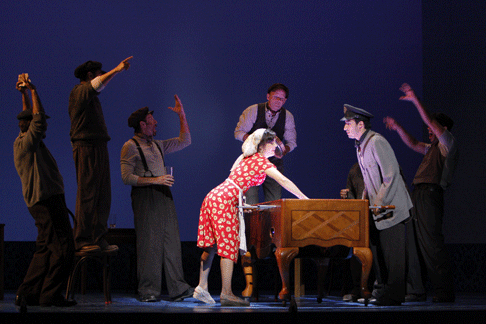 Amanda Squitieri as Beatrice and Charles Castronovo as Mario Ruoppolo
Amanda Squitieri as Beatrice and Charles Castronovo as Mario Ruoppolo
Conductor Grant Gershon managed the trickier rhythms of the score well. Director Ron Daniels couldn’t do much to ameliorate the wearing effect of the frequent scene changes, but he did elicit strong acting performances from the singers. Riccardo Hernandez created some nice costumes, but Los Angeles Opera’s budget restraints didn’t give him much to work with. In act three the budget seems to have run out altogether; other than a ridiculous set of pipes for the promised water system, the act mostly plays out on a bare stage, with some unimpressive projections and newsreel footage (designed by Philip Bussmann).
If Domingo chooses to, he can take Il Postino around the world to some of the more prestigious opera houses. It’s certainly a pleasant show, even a crowd-pleaser. But the opera’s long-term prospects don’t seem any more promising than those, say, of the U.S. Postal Service.
Chris Mullins
image=http://www.operatoday.com/pstn5325.gif
image_description=Placido Domingo as Pablo Neruda and Cristina Gallardo-Domas as Matilde Neruda [Photo by Robert Millard courtesy of Los Angeles Opera]
product=yes
product_title=Daniel Catán: Il Postino
product_by=Pablo Neruda: Plácido Domingo; Mario Ruoppolo: Charles Castronovo; Beatrice Russo: Amanda Squitieri; Matilde Neruda: Cristina Gallardo-Domas; Donna Rosa: Nancy Fabiola Herrera; Giorgio: Vladimir Chernov. Conductor: Grant Gershon. Director: Ron Daniels. Scenery and Costumes Designer: Riccardo Hernandez. Los Angeles Opera.
product_id=Above: Placido Domingo as Pablo Neruda and Cristina Gallardo-Domas as Matilde Neruda
All photos by Robert Millard courtesy of Los Angeles Opera
La Bohème, ENO
Premièred just over a year ago and here receiving its first ‘revival’, the management are surely justified in their faith that it will match the enduring successes of his perennial Mikado (which will make yet another appearance in spring 2010) and Rigoletto: this Bohème is an apt tale of poverty and paucity to fill the coffers in austere times. For, while Miller’s vision certainly doesn’t indulge in sentimentalism — his bohemians are a pretty solipsistic bunch — he and his ingenious designer, Isabella Bywater, present us with an ocular feast. Updating the action to 1930s Paris, they have drawn copiously on the visual records of the period — the sepia-tinted photographs of Cartier-Brassaï and Kertész, the cinematography of film noir — to powerfully recreate the zeitgeist of a Depression-era Europe hedonistically living for today in the face of an uncertain or bleak future.
Bywater’s inspired designs are superbly detailed and naturalistic. Within the monochrome greys of city life, contrasts and counter-currents are pointed: the lofty atelier, with assorted clutter, perches above an empty café; Mimi’s humble rooms lie to the right of twisting staircase; the glimpsed warmth of a café interior poignantly emphasises the literal and figurative chill of the wintry square where Mimi and Rodolfo play out their tragedy. The Act 1 set splits and spins artfully, revealing first a street scene and then twisting back to display the exterior and pavement tables of Café Momus — a scene of sparkling yet superficial vivacity, splashes of colour briefly dismissingly the steely grey. Later, another rotation reveals an employment office, a reminder of reality; a further revolution takes us back to the garret room. The cinematic continuity is effortlessly achieved — a neat realisation of Puccini’s verismo (one is reminded that the first production was screened by Sky Arts, different Sky channels simultaneously relaying the events on stage and the backstage action … a TV first for ENO).
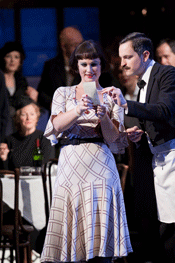 Mairead Buicke as Musetta
Mairead Buicke as Musetta
Miller uses the spaces well: in the early acts, many a riposte is shouted from the Bohemians’ bathroom, warnings cry out from the stair-well, a marching band sweeps across the stage at the Act 2 curtain call, creating a sense of space and air which contrasts with the claustrophobic death room of the final scene. Jean Kalman’s lighting is subtle and thoughtful, no more so than when reflections from lowered windows of the garret add fragile glitter and light to the somewhat desperate Christmas festivities of the Café Momus revellers.
Miller is ever alert to the impact of small gestures and details: shutters are quietly closed as someone leaves the room, a lovers’ argument is glimpsed through an upstairs window. But, despite this attention to detail — aided perhaps by the sympathetic spontaneity of the performers themselves — this is not an overly fussy production. Miller’s chief concern seems to be to tell a simple story in a straightforward way, and he succeeds … but this very simplicity does give rise to some difficulties.
Part of the problem is that the staging often raises the characters aloft, or pitches them afar. Thus, it’s difficult to establish who they really are — what they feel, if anything. A seemingly heartless bunch, they behave foolishly and suffer for their follies, but do we care? The first meeting of Rodolfo and Mimi is mutually contrived, and because their faces are essentially hidden from view, it’s hard to believe in their passion, or to be convinced that it would last more than one night! The orchestra may speak to us of romance, but our eyes witness a mercantile exchange, especially as Mimi begs continually for new gloves, a necklace … The result is a drama with fewer tragic pulses than the average TV soap — there should be scarcely a dry eye in the house at the close, but any tears were surely the product of the superlatively tender violin accompaniment to Mimi’s demise rather than regret for her passing?
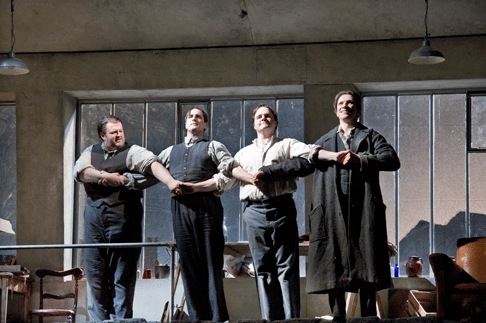 Gwyn Hughes Jones as Rodolfo, George von Bergen as Schaunard, Roland Wood as Marcello and Pauls Putninš as Colline
Gwyn Hughes Jones as Rodolfo, George von Bergen as Schaunard, Roland Wood as Marcello and Pauls Putninš as Colline
That’s not to say that the cast don’t put on a good show. Not least, we are introduced to Elizabeth Llewellyn, making her company debut as Mimi. A graduate of ENO Opera Works — a training opportunity for talented pre-professional singers who demonstrate potential, and designed specifically for those who come to the profession via unconventional routes — her warm, generous voice easily reached the rafters of the Coliseum, and was much appreciated by the audience. However, while this is an opera which always requires the audience to suspend their disbelief, it was hard to be persuaded that one of such remarkable vocal power was on the verge of consumption-afflicted demise … a little more balance between affecting power and vulnerability would have been welcome.
Perhaps the problem is Miller’s conception of the role, for this Mimi is a consumerist flirt who at times seems to have less integrity than Mairead Buicke’s Musetta. Buicke, sporting a neat bob and modish apparel, has great stage presence and relished the theatricality of the role; she had no problem with the virtuosic demands of the part, although she does occasionally sound piercing or shrill. Gywn Hughes-Jones’ Rodolfo is a rather self-pitying sniveller, afraid of his emotions, insecure in his relationships. Challenged, as were the entire cast, to project above an enthusiastic orchestral fabric, often from the far reaches of the stage, Hughes-Jones was strong-toned and confident, but had a tendency to bellow and to come at notes from the side or below.
The Bohemians’ banter and bickering was humorously directed, with four of the first cast returning to their original roles. Roland Wood’s Marcello is vocally a little light-weight, but his diction was clear and his delivery elegant; the spitefulness of his repartee with Musetta added a surprising and effective frisson. George von Bergen and Paul Putninš were charming enough but made little dramatic impact. More arresting was Simon Butteris, whose amusingly lecherous Benoit is a perfectly conceived caricature. Both he and Richard Angas delivered their lines clearly and directly.
Stephen Lord encouraged the ENO orchestra to produce a rich palette of swelling Puccinian rhetoric, injecting some passion into this rather cold-hearted concept. But, this is ‘easy-listening’ and ‘comfort-viewing’ — indeed, in style and substance, there’s not much to choose between these Bohemians and another set of ‘miserables’ elsewhere in the West End. Direct, unpretentious and unsentimental, Jonathan Miller has given ENO another sure-fire winner.
Claire Seymour
image=http://www.operatoday.com/Boheme_ENO_2010_01.gif
image_description=Elizabeth Llewellyn as Mimi and Gwyn Hughes-Jones as Rodolfo [Photo by Robert Workman courtesy of English National Opera]
product=yes
product_title=Giacomo Puccini: La Bohème
product_by=Mimi: Elizabeth Llewellyn; Rodolfo: Gwyn Hughes-Jones; Marcello: Roland Wood; Musetta: Mairead Buicke; Colline: Pauls Putninš; Schaunard: George von Bergen; Benoit: Simon Butteriss; Alcindoro: Richard Angas; Parpignol: Philip Daggett; Customs Sergeant: Christopher Ross; Customs Official: Andrew Tinkler. Conductor: Stephen Lord. Director: Jonathan Miller. Set Designer: Isabella Bywater. Lighting Designer: Jean Kalman. English National Opera. Monday 18th October 2010.
product_id=Above: Elizabeth Llewellyn as Mimi and Gwyn Hughes-Jones as Rodolfo
All photos by Robert Workman courtesy of English National Opera
Madama Butterfly in San Francisco
He is trying to sell twelve performances of Puccini’s masterpiece presumably to the unwashed hordes who flocked to to see Aida simulcast from the opera house onto the scoreboard of the local baseball stadium. The problem is once you have got them inside the War Memorial what do they see?
No doubt Hal Prince is a brilliant Broadway director. Soon after his opera exploits (Willie Stark in 1981 [more a Broadway musical than an opera], Madama Butterfly in 1982 and Turandot in 1983) he went on to direct Phantom of the Opera (1986), the longest running musical in history.
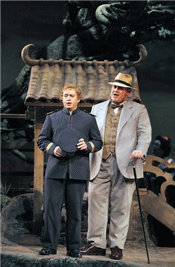 Stefano Secco as Lt. B.F. Pinkerton) and Quinn Kelsey as Sharpless
Stefano Secco as Lt. B.F. Pinkerton) and Quinn Kelsey as Sharpless
Yes, this is the Madama Butterfly he staged for Lyric Opera of Chicago. It caused a lot of excitement back in 1982, after all those theatrically savvy Broadway folks know how to put on a show. There was a national telecast so the production is well known, but back then the lighting seemed far darker so it was harder to see the Kabuki theater knock-off Koken spin the set, and it is harder yet to recall the staging itself after these 28 years.
In San Francisco just now those ninja-like Koken (lithe figures in black body stockings) convincingly simulated the massive efforts needed to turn the huge, fairytale, Las Vegas worthy love nest of Pinkerton and Butterfly. They were quite apparent, forcing the same question that arose back then — what does hyper-stylized Kabuki theater have to do with verismo (realistic) opera?
The answer is about as much as Broadway has to do with verismo opera. The play Madame Butterfly on which Puccini based his opera is by San Francisco’s own David Belasco. It is the American equivalent of théâtre guignol or French horror theater, a frequent Puccini muse. In Belasco’s Butterfly Cho-Cho-San’s horrific suicide is carefully prepared within grubby circumstances. It is reality best experienced, if you must, from a seat in a theater.
Broadway is typically fast and easy. There is lots of stimulation created by frequent scenic movement and lots of color. The story is direct and emotions are obvious. Thus in the Prince Butterfly the set is spun and spun, the colors are seductive and glittery. Butterfly boldly sheds her kimono in favor of American apparel. But the bright gold of her bustled Victorian dress belied three years of wear and the condition of extreme poverty required by the story. It did have requisite Broadway flash.
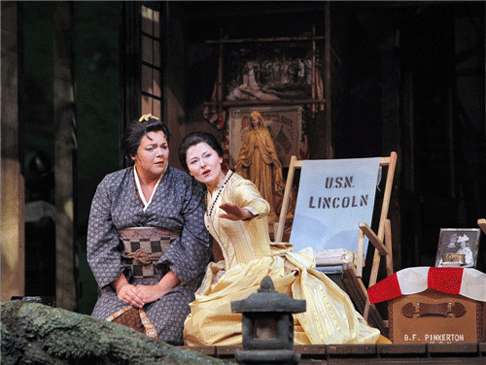 Daveda Karanas as Suzuki and Svetla Vassileva as Cio-Cio-San
Daveda Karanas as Suzuki and Svetla Vassileva as Cio-Cio-San
The Butterfly was the diminutive Svetla Vassileva, a veteran of the world’s big stages to be sure but also an artist of considerable depth, and one who is game for interesting contemporary productions. Her Butterfly is intrinsically Belasco’s geisha, physically and emotionally clumsy (after all she is fifteen years old), simple and very honest. She is not a geisha who makes it to Broadway.
Nevertheless the misplaced glitz of the production faded in her presence, leaving Mme. Vassileva alone on stage to carry Butterfly’s tragic burden, and that she did, to a degree. She is in fine voice — a young and healthy one — well schooled in verismo technique. She tirelessly delivered all the great scenes. The production betrayed her in its absence of reality, her lover seemed a confused kid who found himself in an opera production because he sings well. The balance of the casting showed blatant disregard for the needs of both Belasco and Broadway, and Puccini too wants heavier, Italianate voices. Even the genius of San Francisco Opera’s quixotic conductor Nicola Luisotti could not save the day, though he tried with a breathtaking coda.
But don’t just take my word for it. Check out the video excerpt on the San Francisco Opera website.
Michael Milenski
image=http://www.operatoday.com/Vas2email.gif
image_description=Svetla Vassileva as Cio-Cio-San [Photo by Cory Weaver courtesy of San Francisco Opera]
product=yes
product_title=Giacomo Puccini: Madama Butterfly
product_by=Cio-Cio-San: Svetla Vassileva; Lt. B. F. Pinkerton: Stefano Secco; Suzuki: Daveda Karanas; Goro: Thomas Glenn; Sharpless: Quinn Kelsey; Prince Yamadori: Austin Kness; The Bonze: Christian Van Horn; Kate Pinkerton: Sara Gartland; Aunt: Ann Flandreau Hughes; Mother: Rachelle Perry; Cousin: Carole Schaffer; Uncle Yakuside: Christopher Jackson; Official Registrar: Jere Torkelsen; Imperial Commissioner: Bojan Knezevic; Trouble: Rebecca Chen. Conductor: Nicola Luisotti. Production: Harold Prince. Director: Jose Maria Condemi. Set Designer: Clarke Dunham. Costume Designer: Florence Klotz. Original Lighting Designer: Ken Billington. Lighting Designer: Christine Binder.
product_id=Above: Svetla Vassileva as Cio-Cio-San
All photos by Cory Weaver courtesy of San Francisco Opera
Paris: La Saison a Commencé
Maurizio Benini brought admirable control to the musical proceedings, to be sure, and the orchestra responded well once past a rather characterless overture. Allessandro di Stefano’s male choristers were certainly well-tutored, singing cleanly and correctly even in the face of busy staging. Hmmm. Perhaps a smidge too cleanly and correctly. I might have rejoiced in a little spontaneity infused into the proceedings. That said, harpsichordist Denis Dubois was a highly responsive collaborator, and he partnered the soloists in the recitatives quite inventively all night long. It isn´t often that the dialogue imparts more pleasure than the arias. Hmmmm again. What’s up with that exactly?
Well, Viveca Genaux tried her considerable best in this, her first Paris Opera appearance, and that is indeed considerable. Several times in Act I, though, the voice seemed to not want to ‘speak’ and I wondered if she might be indisposed. And her vocal presence seemed curiously --what’s the word? — muted. My question was answered when, before Act Two’s curtain rise, our diva was indeed announced as under the weather. And that is a pity, since you could tell Ms. Genaux likely had more to offer than was on display. Having enjoyed her in Semele at NY City Opera and in I Capuletti in St. Paul, I find her voice just a bit on the dry side for Italian opera, but a terrific match for Handel. Lacking the ballsy baritonal richness of a Horne, or the quirky abandon of a Bartoli, Viveca relies on evenly produced, well-connected phrases; and technically accurate, assured melismas. Alas, it sounds a little better on paper than it came off in the house. What cannot be disputed is that the lady brought a sultry and spunky physicality to the role, with an easy and pliable sexuality that was hard to resist (and arguably the best gams in the business). Given that she inhabited the character so completely, and given that she was perhaps operating on half steam vocally, I will defer final judgment of her Isabella to another occasion.
Lawrence Brownlee was a sweet-voiced Lindoro and his stage comportment is boyishly appealing. But looking cherubic is perhaps not quite enough to lift the hero to an equal footing with the heroine. It just seemed there was not enough at stake challenging their relationship, and we weren’t rooting for them. We did get to bask in Mr. Brownlee’s high-flying, arching phrases, and admire his well-grounded technique. Although light, his pretty tenor was well-deployed and a good match in timbre with his mezzo. He does a little trick of covering the very top notes, but the result is that they are wondrously steady. Marco Vinco was a generally successful Mustafa, if a bit anonymous. There wasn’t anything about his portrayal that seemed highly personal, and in fact could have been interchanged with several other Rossinian buffo roles with no noticeable difference. His orotund voice was enjoyable and secure, although a bit diffuse, occasionally lacking the bite that might have scored more comic points. Jael Azzaretti’s Elvira was on the opposite side of the fence, offering clean, incisive tone but unable to vary it, thereby suffering from a rather ‘one-note’ vocal portrayal.
Alessandro Corbelli was a seasoned Taddeo, and may have even been memorable in more remarkable company and in a better production. His singing was spot-on, varied, and highly engaging. And he has one of the more splendid baritone instruments currently assessing this Fach. Cornelia Oncioiu brought plummy tone to the small part of Zulma and made solid contributions to the ensembles. Vocal honors of the night to my taste went to baritone Riccardo Novaro for his buzzy, ringing take on Haly. His solid, slightly burnished tone rang out well in the house and his acting was pleasingly poised.
In promotional materials hyping this revival of Andrei Serban’s production, one pulled review declared it ‘hilarious.’ An old New Yorker cartoon came to mind depicting a couple in the stoic audience at an SRO performance, in which the wife hissed to her husband: “I imagine it is far more hilarious with a theatre full of laughing people.” The manic hi-jinks in Mr. Serban’s fussy mounting just didn’t land. Oh, there was a guffaw here, a sustained titter there. But the lack of chemistry between the characters sorely handicapped the hilarity, and the frantic antics didn’t compensate.
Worse, they distracted. I cannot recall one aria that was not accompanied by shuffling feet, semaphoring hands, skittering set pieces, or undulating slave girls performing choreography that looked to have been devised by St. Vitus. (In fact the fidgety dances were created by Niky Wolcz). Marina Draghici’s settings were wonderfully colorful and mostly very functional, but her costumes were less successful, especially the male chorus got up as bulbously fat, naked, turbaned eunuchs. The Act Two curtain rise which revealed the men bent over mooning the audience drew a few well-deserved boos.
Okay, to be fair, there were a few good goofs, like the sinking of the massive cut out of a luxury liner upstage, a veritable comic book Lusitania. And having Mustafa mount stairs to a platform to sit and eat the spaghetti, and then to have the platform pulled away leaving him obliviously dangling and chomping away in mid-air was good fun. But alas, with mis-fired timing, lack of inner comic fire, and highly competent vocalism that never quite achieved the required bravura, this Rossini was decidedly a rather tame affair at the Palais Garnier.
Not so the thrilling “Il Trittico” that inhabited the Bastille house, with a career-capping tour de force (and tour de farce) from veteran Juan Pons. At sixty-four, Mr. Pons is at the culmination of a distinguished career that has taken him to virtually all of the world’s stages. On this occasion he was operating at the top of his game. His Michele in Il Tabarro was easily the finest of my experience, characterized by richly grainy, rolling tone in all registers. If the high G’s did not ‘quite’ have all the spin and ping of yore, they were solid, steady, and they filled the house as powerful statements. His acting is unaffected yet supremely affecting, and he scored every dramatic point. As Gianni Schicchi, Juan flat out nailed all the comedy, too, and I found myself laughing aloud at thrice familiar material I thought could never tickle me again. This was Operatic Royalty at work and we willingly worshipped at the throne.
In the tricky role of Giorgietta, Sylvie Valayre was in good enough form, but it has to be said that her lower middle voice does not have quite the oomph to make the most of the part, such as the low-lying duet with Michele. Give her a high passage, though, and Ms. Valayre is your gal, as she can pour out zinging top notes with effortless abandon. Marco Berti as Luigi reveled in his high notes, too, pushing them out into the auditorium with a vibrant squillo that was a real crowd pleaser. I feel there is a bit more to the role than volume, though, and while he modulated his voice conscientiously, there is no doubt that riding the full orchestra with exciting results is his forte (as it were).
Tinca and Talpa are often comprimario turns but not so here as Eric Huchet and Mario Luperi fleshed them out with expertly sung impersonations. Both did similarly fine work in the last third of the night as Gherardo and Simone, respectively. Marta Moretto was an admirable Frugola and a deliciously bitchy Zita. She knows her way around the stage, turning in inspired comic performances without a hint of shtick yet missing nary an opportunity to get a laugh. She husbanded her substantial mezzo resources well although the tone was a bit rough around the edges at times, especially at the break to chest voice. Small matter, since she is a consummate professional and made nary a false move all night. Even the smallest roles were cast from strength: Hyung-Jong Roh’s shining tenor as the Song Seller could persuade anyone to make a purchase; and the Two Lovers were the loverly, honey-toned Anne-Sophie Ducret and Gregorz Staskiewicz.
I have always found Suor Angelica to be all about sublime atmospheric establishment and one terrific aria (okay, okay and a short mid-opera bitch fight). The piece was well-served indeed by an unsurpassable ensemble of female soloists. All from the front ranks, I could single out Marie-Thérèse Keller for her secure, silvery soprano and her beautifully voiced Mistress of the Novices. Ms. Keller also switched gears later to contribute a seething La Ciesca. Barbara Morihien’s creamy instrument also did excellently by La Badessa, and no less so as Schicchi’s more acerbic Nella. If Fiorenza Cossotto passed her mantle to anyone it just may have come to rest on the imperious Luciana D’Intino (La Zia Principessa). But then Ms. D’Intino is no one’s ‘copy.’ Hers is a personal, sizzling, sizable instrument with just a touch of metal in the middle and top, but with the whole Mother Lode in the chest voice. She is a masterful technician, knitting her registers together with near seamless artistry. She has that elusive ‘star quality’ in spades and dominated her short scene as she must. This was a powerhouse of a performance.
But Angelica is nothing if not about creating sympathy for its hapless heroine, and really the whole show rests on her. Happily, Paris Opera enlisted the services of the gifted Tamar Iveri for the title role. It fits her like a second skin, and Ms. Tamari succeeds in creating a well-rounded personality and distinctive character in spite of the handicap of looking just like (about) everyone else on stage. She is possessed of a handsome spinto which is securely deployed, and uncommonly vibrant in the lower range. She also commands a gleaming top and admirably floats the end of the aria, which has brought many a soprano to grief. I am not sure Tamar is widely known outside of Europe but she should be. This is a major Puccinian.
Of the large, superb ensemble in Gianni Schicchi not already mentioned, Ekaterina Syurina made a laudable role debut as Lauretta. If there is a more famous aria than O Mio Babbino Caro I am not sure what it is (a Callas excerpt is in an advert on CNN about every five minutes right now). Ms. Syurina not only makes the piece her own, voicing it lovingly with her pure lyric soprano, but she also soars joyously in the duet passages. Saimir Pirgu was a memorable Rinuccio, equal parts secure, ringing lyric tenor; and dramatic persona slightly ‘prosciutto crudo.’ When he semaphorically addresses the audience directly, which he does on most solo passages, he seems a Pavarotti wannabe who has lost his white hankie. But he is good-looking, charismatic, and sings with stylistic security, so what the heck, just give him the hankie and be done with it. Alain Vernhes was in fine voice as Betto, and Roberto Accurso made the most out of Marco. Yuri Kissin was bit of luxury casting as Maestro Spinelloccio, and young Christian Helmer used his pleasing baritone to good ends as Amantio di Nicolao.
The production was stylized, and somewhat eccentric but grounded in truthful imagery. Tabarro’s ship was tilted a bit cockeyed, almost like an ice breaker with its bow lifted up during heavy going. But it served the story’s purpose well and additional playing spaces were created by a gangplank going up to a quay, and a gate in the railing opening to the stage apron. The textured grays of the color palette conveyed the workaday repetition and entrapment inherent in Giorgietta’s environment. The back wall had an Arp-inspired opening in it that framed the upstage action on the platform. Lighting effects and rear screen projections were well-judged by designer Gianni Mantovanini. There were some abrupt light changes such as the sudden dimming just in time for Luigi’s fatal entrance at the end of Tabarro, or the white-hot spot on Angelica as she departs this life that might have been modulated differently. But Mr. Mantovanini’s overall work was beautifully evocative and contributed greatly to the overall impression.
Suor Angelica was the most non-representational setting of the night, with a massive Virgin Mary (a replica of the statue in the shadow box on the landing) lying face down (dead?) on the stage floor. All the action was brilliantly played out atop and around this defeated religious icon. What volumes this imagery spoke about our poor heroine’s crisis of faith. The choice to use the Principessa confrontation as the only portion played out on the apron was highly effective. Just when we thought we had seen every possible trap door, stair, and entrance used, Angelica’s little son scrambled out from under the Virgin’s splayed arm, and scurried excitedly to join his mother above just as she threatened to rend the giant statue’s veil in torment. A perfectly judged effect.
Gianni Schicchi plays out in a milieu of skewed platforms, all draped in devilish red fabric that is artfully and weightily swagged up right, accenting the over-sized bed-as-bier. The rear platform this time had a mini-elevator that allowed Schicchi a star entrance of sorts as he descended into the scene. While a projection of the Duomo eventually appeared, and while our lovers ended on this platform as a stand-in for the specified rooftop, the first projection looked suitable for Dante’s Inferno, providing a perfect visual subtext for the ‘grieving’ relatives. The benches and raked playing spaces afforded director Luca Ronconi ample opportunity for varied groupings, and the visual environment encouraged meaningful characterization and story-telling. In collaboration with Assistant Director Ugo Tessitore, the staging did not miss a trick.
Indeed, the artistic leadership not only read and understood Puccini’s specific intentions, but — *gasp* — they embraced them! Zut alors! Numbered among the huge payoffs was the chilling finale to Tabarro which followed the stage directions to the letter and trusted that three highly skilled singers could wring every bit of melodrama out of the thundering closing measures. The audience roared approval ( Eurotrash directors please take note). There was a delightful piece of business in Schicchi in which two large candles, one on each side of Buoso’s death bed, were reverently lit ‘in memoriam’ and then, when the non-bequeathals are made evident, very quickly and unceremoniously blown out. Funny stuff. Traffic management was just magnificent in Schicchi with constantly moving principals who were always motivated, always connected, and always in the right place to make their solo moments count (Mr. Pirgu being the prime, but not the only, example). Mr. Ronconi has put on display a veritable Masters Class of meaningful operatic stage direction, one that is traditional yet bursting with freshness and truth. Bravo, Signor!
I would be remiss not to praise the outstanding costumes designed by Silvia Aymonino. From the drab, oppressive work clothes of Tabarro to the crisp white habits of Angelica to the designer mourning clothes on the Florentines, these were character-specific duds that ably supported the characterizations. Since Schicchi was updated in every other way, I did question the choice to put the title role alone in a (gorgeous) 13th Century costume. Not sure what it meant — that things haven’t changed since then? I got used to it but it was a momentary distraction in an otherwise pretty much perfect evening.
And ‘perfection’ is just the word to characterize the playing that Phillipe Jordan elicited from the orchestra. Seldom have I heard such nuanced and sensitive music-making in a Puccini opus, but Maestro coaxed chamber music sensitivity from this fine band. Nowhere was this more evident than in the lustrous account of Suor Angelica with evocative work from the winds (including haunting passages from the bass clarinet) and luminous ensemble from the banks of strings. Not that Monsieur Jordan shied away from the fire and brimstone of, say, Michele’s sinister aria, or the sassiness of the prankish Schicchi motifs. Never have I heard this pit in more responsive form, and credit for that lies in Jordan’s musical leadership. The Maestro and his orchestra received an enthusiastically vociferous, prolonged acknowledgment of their exceptional music-making at evening’s end.
James Sohre
L’Italiana in Algeri
Conductor: Maurizio Benini
Director: Andrei Serban
Set and Costume Design: Marina Draghici
Lighting Design: Andrei Serban and Jacques Giovanangeli
Choreography: Niky Wolcz
Chorus Master: Allessandro di Stefano
Harpsichord: Denis Dubois
Mustafa: Marco Vinco
Elvira: Jael Azzaretti
Zulma: Cornelia Oncioiu
Haly: Riccardo Novaro
Lindoro: Lawrence Brownlee
Isabella: Viveca Genaux
Taddeo: Alessandro Corbelli
Il Trittico
Conductor: Phillipe Jordan
Director: Luca Ronconi
Assistant Director: Ugo Tessitore
Set Design: Margherita Palli
Costume Design: Silvia Aymonino
Lighting Design: Gianni Mantovanini
Chorus Master: Alessandro di Stefano
Il Tabarro
Michele: Juan Pons
Luigi: Marco Berti
Il Tinca: Eric Huchet
Il Talpa: Mario Luperi
Giorgietta: Sylvie Valayre
La Frugola: Marta Moretto
Song Seller: Hyung-Jong Roh
Two Lovers: Anne-Sophie Ducret, Gregorz Staskiewicz
Suor Angelica
Suor Angelica: Tamar Iveri
La Zia Principessa: Luciana D’Intino
La Badessa: Barbara Morihien
La Suor Zelatrice: Louis Callinan
Mistress of the Novices: Marie-Thérèse Keller
Suor Genovieffa: Amel Brahim-Djelloul
Suor Osmina: Claudia Galli
Suor Dolcina: Olivia Doray
Prima Cercatrice: Zoe Nicolaidou
Seconda Cercatrice: Carol Garcia
La Suor Informiera: Cornelia Oncioiu
Una Novizia: ChengxingYuan
Prima conversa: Anne-Sophie Ducret
Seconda conversa: Marina Haller
Gianni Schicchi
Gianni Schicchi: Juan Pons
Lauretta: Ekaterina Syurina
Zita: Marta Moretto
Rinuccio: Saimir Pirgu
Gherardo: Eric Huchet
Nella: Barbara Morihien
Betto: Alain Vernhes
Simone: Mario Luperi
Marco: Roberto Accurso
La Ciesca: Marie-Thérèse Keller
Maestro Spinelloccio: Yuri Kissin
Amantio di Nicolao: Christian Helmer
Pinellino: Ugo Rabec
Guccio: Alexandre Duhamel
image=http://www.operatoday.com/Logo_OnP.gif
image_description=Opéra national de Paris logo
product=yes
product_title=Paris: La Saison a Commencé
product_by=Click here for information regarding the Opéra’s 2010-11 season.
Kirsten Flagstad sings Wagner & Strauss
This new Audite release makes available live performances from 9 May and 11 May 1952, when the singer had already achieved international recognition. In these performances Flagstad reprised her portrayal of Isolde in two exceprts from Tristan und Isolde, “Isolde’s Narrative” from the first act and the “Liebestod” from the third. In addition to this music by Wagner, the recording also includes the Wesendonck-Lieder. The second disc of the set is devoted to music by Richard Strauss, specifically the last three of the composer’s Vier letzte Lieder and the monologue “Orest, Orest” from the opera Elektra. In all these excerpts she is accompanied by the Orchester der Städtischen Oper Berlin, conducted by Georges Sebastian.
The excerpts from Tristan offer a classic reading of the music by a performer who is legendary for her affinity with this opera and others by Wagner. The command of the line emerges readily in the examples, which are set up by a solid performance of the famous Prelude. With “Isolde’s Narrative,” Flagstad gives remarkable shape to the lengthy retelling of Isolde’s story prior to leaving with Tristan to be married to his uncle, King Mark. The narration has a dramatic point, as Flagstad leads the listeners into the music through her compelling phrasing and fine style. With the “Liebestod,” the lament of the bereft Isolde over the body of Tristan, the sense of unity and detachment emerges almost effortlessly in Flagstand's interpretation.
Less familiar is Flagstad’s interpretation of Wagner’s song cycle, the Wesendonck-Lieder, which makes use of Felix Mottl’s orchestration. The performance has no problems, but in her approach to this cycle, some passages seem to be overstated. This is not to detract from the result, which is that of a fine Wagnerian approaching an important set of songs in the Romantic repertoire. In fact, Flagstad seems more comfortable with the three songs she performed from Strauss’s Vier letzte Lieder, the third, second and fourth songs of the set. Flagstad’s approach is soaring, as if the music were composed for her, and the fluid accompaniment of Sebastian supports her efforts in this recording. Likewise, Flagstad is comfortable in the title role of Elektra, and her delivery of the monologue gives a sense of her approach to this character, which stands apart from the Wagnerian heroines customarily associated with Flagstad.
The final selection is the “Immolation” scene from Götterdämmerung, a role which Flagstad renders well. Her convincing delivery and solid phrasing demonstrate the reputation Flagstad has for the role of Brünnhilde, and the delivery here, out of the context of a opera house, still has a dynamic and commanding quality. As familiar as this music is, the track is persuasive and offers a fine concert performance to appreciate alongside Flagstad’s other recordings of this scene.
The sound is resonant and full in this Audite release which, as indicate in the accompanying booklet is based on original recording tapes. In fact, the details of this release confirm the fine effort extended to create a high-quality recording of these performances. In addition, the book contains the full text and translations of the vocal selections. The essay by Jürgen Kesting offers some useful perspectives on Flagstad’s performances in this recording.
James L. Zychowicz
image=http://www.operatoday.com/Audite_23416_150.gif
image_description=Kirsten Flagstad sings Wagner & Strauss
product=yes
product_title=Kirsten Flagstad sings Wagner & Strauss
product_by=Kirsten Flagstad, soprano, Orchester der Städtischen Oper Berlin, Heorges Sebastian, conductor.
product_id=Audite 23.416 [2CDs]
price=$18.99
product_url=http://www.arkivmusic.com/classical/Drilldown?name_id1=15630&name_role1=2&bcorder=2&label_id=359
October 21, 2010
Rameau’s Zéphyre, New York
All else is, if not irrelevant, subservient: the look, the style, the star, the archival accuracy. You can pull any strings you like; just get out there and dance. Or sing.
For instance: You have rehearsed your company of dancers to present a court opera-ballet of mid-eighteenth century Versailles and you have got the proper sort of band to play it, and the dancers trained in the proper style, the graceful mincing steps, half-mime, half-dance, including the sheep and goats who stalk like sheep and goats with a dainty little waver-step, and attendants to the wind god who spread their violet cloaks as they leap into the air—but you have no tenor to sing the title role of the amorous (and, meteorologists tell us, prevailing) West Wind. Now, Rameau is no stand-up-and-belt opera composer. Refinement of accent and affect is called for to put him across. The voice need not—should not—be enormous, but the clarity of feeling as expressed by melody and ornament and pose are necessary to make the proper case for his elegant music. These are skills not often demanded of singers who prepare for opera; they are more suitable to Early Music singers, happily a far from rare breed in this new era.
So Catherine Turocy’s New York Baroque Dance Company, finding itself untenored, constructed its production of Rameau’s Zéphyre around a soprano, Ann Monoyios, once a reigning diva of the local Early Music scene, and got around the story’s mythic inconsideration with the announcement that she was portraying Madame de Pompadour, king’s muse and star of all the local theatricals in her glory days, as she might have presented a little Rameau pastorale for a few invited and exalted guests in the little theater at Versailles. Once that premise is accepted, we don’t even need to dress her in trousers. She’s in charge, she’s paying the bills, and if she wants to sing the boy’s part, God bless her.
Monoyios, whom I had not heard in decades, sounds a much younger woman than she could possibly be. Early Music does not take the toll on the cords that belting does, and her graceful phrasing, curlicue ornaments at meaningful times, and truth of character were extremely pleasing on this occasion, if a dryness did set in by the end of it. Rebecca Choate Beasley, as the object of her/his affections, did not have much to do but showed a sweet lyric line. James Richman’s Concert Royal gave sprightly accompaniment.
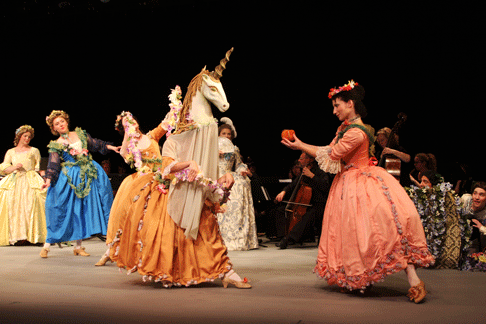 Alexis Silver tempting the Unicorn danced by Valerie Shelton Tabor
Alexis Silver tempting the Unicorn danced by Valerie Shelton Tabor
Sets and costumes are half the battle in this sort of entertainment; at Symphony Space there was no set to speak of, but the company’s costumes (not credited to any particular designer) accomplished a great deal of scene-setting. Zéphyre was preceded by brief dances from several other Rameau works, including enough mythic animals (unicorns, fauns, gnomes) dancing in courtly but appropriate style to fill a whole new HBO supernatural series.
John Yohalem
image=http://www.operatoday.com/Cloris-and-Zephyre-holding-.gif image_description=Rebecca Choate Beasley as Cloris and Ann Monoyios as Zéphyre [Photo by Julie Lemberger] product=yes product_title=Jean-Philippe Rameau: Zéphyre product_by=Zéphyre: Ann Monoyios; Cloris: Rebecca Choate Beasley; Diane: Lianne Coble. The New York Baroque Dance Company, Catherine Turocy artistic director. Concert Royal, directed by James Richman. Symphony Space, September 22. product_id=Above: Rebecca Choate Beasley as Cloris and Ann Monoyios as ZéphyreAll photos by Julie Lemberger
October 19, 2010
Wexford Festival Opera, Ireland
By Andrew Clark [Financial Times, 19 October 2010]
Every artistic decision is a financial decision, and every financial decision an artistic one. The words came from Wexford’s artistic director, David Agler, during a discussion on Monday of his opera festival’s precarious prospects, but they could just as well have been uttered by any other recession-hit impresario. The job of artists is to dream dreams - and then to find the resources to realise them.
October 17, 2010
Haendel: Water Music; Music for The Royal Fireworks
Their popularity and frequent arrangement have given them, I suspect, an awkward familiarity, the kind of familiarity that keeps us from attending to them with attentive and respectful ear. Yet, their familiar ubiquity should not blind us to the fact that they are popular, in part, because they are very good pieces. Jordi Savall’s remastered 1993 recording of the Water Music and Music for the Royal Fireworks is precisely the sort of recording that breaks through the fog of familiarity and reanimates the hearing.
The pedigree of the suites, of course, needs no special pleading. The Water Music’s association with royal entertainment on the Thames is well known through the early Handel biographer, John Mainwaring, who gives us the unsubstantiated and unlikely notion of a reconciliation between Handel and George I via the beauty of the works at hand. The story is a false start, but the royal esteem for the works survives intact. And with thousands of people creating an eighteenth-century traffic jam on London Bridge en route to hear a public rehearsal of the Music for the Royal Fireworks in Vauxhall Gardens in 1749, we can have but little doubt of the public interest in Handel and his celebrative music for the Treaty of Aix-la-Chapelle.
Savall’s splendid period performance offers the opportunity to relish anew the amazing range of pieces in these collections: elegance, exuberance, energy, and regality, all in a captivating procession of musical style. At each turn, the musicians of Le Concert des Nations command such stylistic fluency that, whether a wafting Lentement, a rhapsodic oboe Adagio, or a spirited bassoon gigue, the familiar pieces emerge with a new and very gratifying polish, and our newly awakened ear finds much to respect and enjoy, indeed. To that, as Handel famously and familiarly put it elsewhere, we might say “Hallelujah!”
Steven Plank
image=http://www.operatoday.com/AVSA9860.gif image_description=Haendel. Water Music; Music for The Royal Fireworks product=yes product_title=Haendel. Water Music; Music for The Royal Fireworks product_by=Le Concert des Nations. Jordi Savall, Director product_id=Alia Vox Heritage AVSA 9860 [SACD] price=$20.99 product_url=http://www.arkivmusic.com/classical/Drilldown?name_id1=5023&name_role1=1&comp_id=208&bcorder=15&label_id=166October 16, 2010
Jephtha, New York
That’s a pity, because Jephtha’s musical and dramatic structures indicate that a closer intertwining of staged drama and static oratorio was coming into being: Chorales are fewer and less involved in the action than in the earlier oratorios, and the action includes a remarkable quartet of conflicting points of view at a moment of high tension, almost unprecedented in Handelian drama and pointing the way to Mozart and Rossini. Characters state their feelings in da capo arias, as one expects, but alternate such static reveries with soliloquies in recitative accompanied by full orchestra or the occasional duet. The characteristic emotions and tunes we know from Handel are here, but new expressive tools are brought to their aid. After forty years in the business, the great man hadn’t run out of, or even low on, new ideas.
The story, though Biblical, resembles the Idomeneo legend familiar to us from Mozart’s opera (Bible stories could not be staged in England before the twentieth century): Israel’s General Jephtha has vowed, if successful in battle, to sacrifice the first creature he encounters on his return. To his embarrassment, the creature who emerges to welcome him is his daughter. He squirms, he bargains, he considers alternatives — but a vow’s a vow. However, like Neptune (in Idomeneo’s case), Jehovah lets him off the hook: An angel suggests that Iphis, the general’s daughter, be offered to perpetual virginity as a Jewish nun, in effect, and that an animal be sacrificed instead. In the Bible, actually, relentless Jephtha sacrifices his daughter, but Handel’s version recalls the tale of Abraham’s “sacrifice” of Isaac. In any case, the unhappy ending would have had unpleasant political ramifications in Handel’s day, when the rationalists were dwelling on such tales to discredit religion generally. Handel, devout believer and lifelong optimist, pulls it off convincingly, and few among his usual audience today are likely to spot the change. Only Iphis’s boyfriend remains unhappy.
St. Ignatius Loyola, Manhattan’s Jesuit church, is an edifice in the style of a great Roman basilica, with porphyry columns, faux marble panels, frescos of the saint’s life, death and apotheosis and a rather muddy acoustic: A small chorus and orchestra (always preferable for Handel) booms down the long nave to Park Avenue, but individual voices and instruments are not as clear as one might like and soloists seemed to lose their clarity at one end or another of their range. Conductor Kent Tritle’s rhythms were happily vivid, and the three lengthy acts passed swiftly to the exciting conclusion.
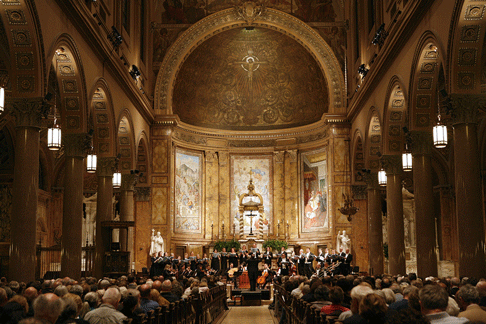 St. Ignatius Loyola
St. Ignatius Loyola
The singers made rather an able than a striking set. Thomas Cooley, in the emotionally awkward title role, sounded too light for the martial persona in the first act but gained strength and bite as the catastrophe of his ineluctable choice came home to him. Charlotte Daw Paulsen has some splendid maternal contralto notes but her voice thinned to a strand above them. Ian Howell, singing Iphis’s boyfriend, a role Handel wrote for a mezzo soprano, is an adept countertenor without the mezzo power or sensuousness one might desire. Kelly Markgraf has a pleasing and agile bass but had very little to do as Jephtha’s brother.
Vocally the occasion would have been professional but little more had not Susanna Phillips sung Iphis, the designated sacrifice, whose arias must present her as a spirited warriors’ cheerleader, a devoted daughter, a fearful suppliant, and a willing martyr by turns. Phillips, who has been garnering lots of attention lately, proved worthy of it: she has an even, flexible voice with a goodly heft to it, shining power in the upper range and no less force and beauty in lower tones. (Handel never wastes part of a voice — he expects his singers to use it all.) Phillips gave a radiant performance, and by the very fact of singing so well throughout her compass disproved any suspicions that St. Ignatius’s acoustics were kinder to certain ranges of sound than others. Her only failing is a certain imprecision in swift ornament — she has, for instance, no trill, and Handel often calls for one. The quality of her soprano is so thrilling and her musicianship so steady that I hope to encounter it often. She will sing Pamina at the Met this winter; she should be adorable in that adorable (and not too ornamental) part.
John Yohalem
image=http://www.operatoday.com/Susanna-Phillips.gif image_description=Susanna Phillips product=yes product_title=G. F. Handel: Jephtha product_by=Jephtha: Thomas Cooley; Iphis: Susanna Phillips; Storgè: Charlotte Daw Paulsen; Hamor: Ian Howell; Zebul: Kelly Markgraf. Chorus and orchestra of the Church of St. Ignatius Loyola, conducted by Kent Tritle. Performance of October 13. product_id=Above: Susanna PhillipsRigoletto at Covent Garden
The pre-performance announcement by ROH’s director, Elaine Padmore, of the sad death of this great soprano added an extra layer of emotional urgency to this revival of David McVicar’s now almost canonical production of Verdi’s Rigoletto.
David McVicar’s eighteenth-century Mantua is a hothouse of Bacchanalian orgies and Machiavellian deceit. Michael Vale’s Olivier-award nominated sets — transparent, spinning edifices, all crumbling stone, shadowy recesses and askew perspectives — powerfully suggest the literal and figurative decay of a city on the verge of moral collapse, and are complemented by the flaming reds and oranges of Tanya McCallin’s raunchy costumes for the opening Scene 1 which evoke Dante’s infernal realms. Nudity and violence, often combined, abound. Out of these fiery depths leaps a black leather-clad Rigoletto - a horned devil, spitting fury and curses. Fearlessly physical, Dmitri Hvorostovsky, usually seen in rather more suave and sophisticated guises, emits a startling viciousness and ferocity, foreshadowing the inhumanity to which the eponymous jester’s desire for all-consuming vengeance will subsequently propel him. Boundless stamina combined with limitless variety — now sweetly tender when recalling his wife, then cruelly bitter as his obsessive rage engulfs him — characterise a remarkable performance. Hvorostovsky is not afraid to push his baritone to its rougher edges, while his ability to spin an endless lyrical line never ceases to amaze and thrill.
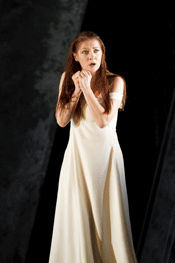 Patrizia Ciofi as Gilda
Patrizia Ciofi as Gilda
The shadow of the late lamented diva placed a heavy mantle on the shoulders
of Patrizia Ciofi as this production’s Gilda. She took a little time to
settle, occasionally sliding up or slipping down to notes at first, and at
times employing an overly wide vibrato which supported her projection but
muddied the intonation. But Ciofi is an experienced Gilda, well-versed in the
idiom, confident in delivery, and she soon found her focus; her pristine tone
captured the near-hysterical ecstasy of the young girl experiencing the pain of
passion for the first time, and she dispatched ‘Caro nome’ with
aplomb, revealing a true coloratura with seamless passagio. Paul
Constable’s imaginative lighting added some exquisite touches to poignant
moments. Thus at the end of Gilda’s first aria, the stage revolved
casting subtle shadows and revealing subdued corners, as Gilda slowly mounts
the crooked stairs to the attic hovel, her voice heartbreakingly waning with
the fading light. Clothed in virginal white against his darker hues,
Ciofi’s duets with Hvorostovsky were impassioned and penetrating, the
latter’s mastery of the uninterrupted, arching melodic curves of
Verdi’s score suggesting the heartfelt intensity of a paternal love which
both protects and suffocates.
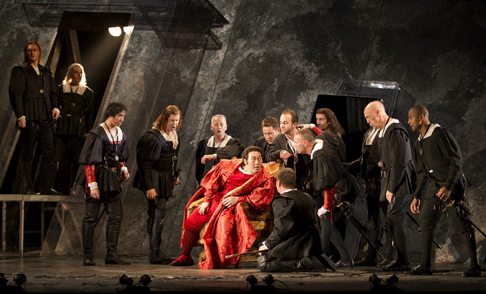 Wookyung Kim as Duke of Mantua
Wookyung Kim as Duke of Mantua
Korean tenor Wookyung Kim made his debut at the ROH in 2007 as the Duke of Mantua, and returned to reprise the role. Despite his musical prowess — unfailingly legato lines and even tone production — theatrically, he does not make for a natural Casanova. His interpretation is a little one-sided, fresh naivety not really matched by the requisite careless, even wicked, wilfulness.
Indeed, many of the cast were veterans of this production, and all held their own well in the company of the leading lights. The big, bold bass of Raymond Aceto emphasised Sparafucile’s sinister and twisted motivations. Mezzo-soprano Daniela Innamorati was a convincingly seductive Maddalena in the renowned quartet, her warm tone complementing the blending voices. Amid the ubiquitous debauchery and vice, it was hard for Michael Druiett as Monterone — who only appears twice in the opera — to make much of a mark as the voice of moral authority, but he was secure. Both of the Jette Parker Young Artists in this production also performed with accomplishment: Polish baritone, Lukas Jakobski, was a solid Ceprano, while the bright baritone of Zhenzhong Zhou as Marullo made a strong impression in a small role.
The young Israeli conductor, Dan Ettinger, making an impressive Covent Garden debut, really kept his foot on the pedal from the first downbeat, racing through the opening scene, injecting a terrifying air of menace, and sustaining the dramatic drive and frisson of risk and recklessness throughout. The opera rushed relentlessly on to its disturbing climax: Hvorostovsky’s terrible exultation over the dead body of his daughter. His perverted elation, in his belief that the dead Duke lies slain in the sack before him, is a disquieting moment of hubris.
McVicar presents a dystopian vision of crooked criminality and raw cruelty. If his vision underplays the balanced contrast between the light and the dark which, I believe, accounts for much of the emotional piquancy of Verdi’s opera, in favour of an unremittingly malevolence, it does so with an admirably precise and sustained focus. A first rate evening.
Claire Seymour
image=http://www.operatoday.com/RIG-2010JP_00584-HVOROSTOVS.gif image_description=Dmitri Hvorostovsky as Rigoletto [Photo by Johan Persson courtesy of Royal Opera] product=yes product_title=Giuseppe Verdi: Rigoletto product_by=Rigoletto: Dmitri Hvorostovsky; Duke of Mantua: Wookyung Kim; Gilda: Patrizia Ciofi; Maddalena: Daniela Innamorati; Sparafucile: Raymond Aceto; Monterone: Michael Druiett: Marullo: ZhengZhong Zhou; Count Ceprano: Lukas Jakobski; Giovanna: Elizabeth Sikora; Matteo Borsa: Iain Paton. Director: David McVicar. Conductor: Dan Ettinger. Set design: Michael Vale.Costume design: Tanya McCallin. Lighting design: Paule Constable. Royal Opera House, Covent Garden, London. Monday 11th October 2010. product_id=Above: Dmitri Hvorostovsky as RigolettoAll photos by Johan Persson courtesy of Royal Opera
October 13, 2010
Verdi’s Macbeth in a New Production at Lyric Opera of Chicago
On these two counts Lyric Opera of Chicago’s new conception of Macbeth scores a significant triumph. Under the stage direction of Barbara Gaines, founder and artistic director of the Chicago Shakespeare Theater, this new production is conceived as alternately expansive and restricting, thus highlighting the ambitions and emotional as well as political collapse of the royal couple’s murderous plans. In the title role Thomas Hampson gives a multi-faceted depiction of this complex character, his acting and singing coalescing into a strong and individual interpretation. All other leading roles in this production are very well cast by international artists making their debuts this season at Lyric Opera: Nadja Michael as Lady Macbeth, Štefan Kocán as Banquo, Leonardo Capalbo as Macduff, Konstantin Stepanov as Malcolm, and Carter Scott as both Lady Banquo and the Lady in Waiting. The Lyric Opera Orchestra is led by Renato Palumbo and Donald Nally directs the generous contributions of the Lyric Opera Chorus.
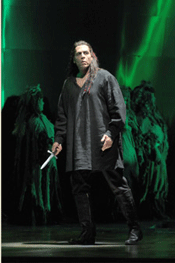 Thomas Hampson as Macbeth
Thomas Hampson as Macbeth
Before the overture begins the stage is sheathed by a cover approximating
armor, at the base of which is depicted a stylized forest with soldiers. The
brief overture under Palumbo’s direction showed sensitive attention to
tempo and orchestral colors with brief pauses and transitions well integrated
into the whole. At its close the stage covering opens at center to reveal the
simulated shooting flames of golden fire surrounded by a large chorus of hags.
Suspended above them and careening through the air are three witches who join
with the other groups below to recount their supernatural activities. At the
sound of drums Macbeth and Banco enter and demand that the witches identify
themselves. In answer they hail Macbeth, in succession, “di Caudor
sire” and “di Scozia re.” As Macbeth, Mr. Hampson declaimed
from the start in full voice while demanding a greeting from the witches. In
the role of his fellow general Banco Mr. Kocán layered his resonant voice with
dramatic effect, his diction showing an equally incisive understanding of
Verdi’s textual import. In their duet as a response to the first of the
witches’ predictions being realized both singers followed an effective
vocal line yet each differentiated the same in technical delivery. Hampson
moved impressively from piano to full dramatic voice, while Kocán used
a striking bel canto approach within a seamless and well projected
vocal range. As the pair departs and the chorus of witches predicts
Macbeth’s return [“Fuggiam, fuggiam!” (“Hasten away,
hasten!”)], the sets retract to show Lady Macbeth simultaneously in their
castle already reading Macbeth’s letter. This fluid transition connects
the two scenes directly, so that the Lady’s reaction gains immediacy upon
Macbeth’s revelation. In her pronouncements after a chilling recitation
of the letter Nadja Michael reveals a dramatically forceful delivery in which
she urges Macbeth to take courage and seize the opportunity of the moment. Ms.
Michael’s approach to this and subsequent scenes relies on several points
of vocal focus which she alternates with expressive transitions in order to
communicate a range of emotions. Her invocation of the spirits of the
underworld [“Ministri infernali”] to lend their evil support is
performed as several voices blending into one with softer downward runs
suggesting her own spiritual descent. During the aria Ms. Michael placed lit
candles about the room in a circle suggesting a further hope to ally herself
with demonic forces. Once Macbeth arrives with Duncan as guest, the couple
comes to agreement on the King’s fate in a mere several lines. In his
delivery of Macbeth’s soliloquy before the King’s chamber
Hampson’s excited emotions ascend to a crescendo as he intones the
self-convincing speech, his voice rising through the words
“assassino” (“murderer”) and culminating with dramatic
top notes on “Immobil terra!” (“Firm-set earth”). Once
the deed is declared done [“Tutto è finito”] Macbeth and the Lady
participate in a nervous exchange during which she takes a dominant role. Here
the voices of Hampson and Michael blended and alternately moved apart to
suggest their complex roles of dependency and revulsion. In the final scene of
this act Macduff and Banco enter to rouse the King and prepare him to journey
further. It is Macduff who discovers the murdered King and decries the vile
deed [“Orrore, orrore”]. Mr. Capalbo in a noteworthy debut sings
the role of Macduff with urgent, bright tones that command attention to his
honest pleas for the King’s memory. As everyone present sings in unison
to demand justice and counsel from God, Macbeth and the Lady join in condemning
the deed they have themselves committed.
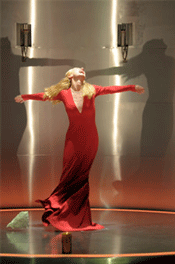 Nadja Michael as Lady Macbeth
Nadja Michael as Lady Macbeth
In Act II the royal couple descends to further iniquity with Lady Macbeth
taking the vocal lead in expressing complicity. Macbeth reminds her of the
predictions relating to Banco and the need to murder him in order to assure a
clear path to the throne. Lady Macbeth agrees in her haunting aria “La
luce langue” (“Light thickens”), which Michael sings with
understated hushed tones, capped by powerful high notes. As the scene changes
the assassins, who will kill Macbeth’s rival, position themselves on a
steep wall in a wooded park and practice their forthcoming attack. Their
pantomime is choreographed by the production team with dance-like movements
befitting the sprightly music composed by Verdi for the start of this scene.
Banco then arrives on the path with his son Fleanzio. Here the father issues
multiple warnings and speaks of his concern for safety and treachery. In his
major solo aria Kocán combined elegant legato phrasing in significant passages
[“sospetto” (“suspicion”)] with a rich tone culminating
in the convincingly delivered dramatic notes of “terror.” His son
is here whisked to safety by one of the suspended flying figures, returned from
Act I, as Banco succumbs to the assassins. The final scene of this act in the
banquet hall is staged with frenetic, drunken movements as King Macbeth is
confronted several times by the ghost of Banco. At the King’s urging the
Lady sings her toast “Si colmi il calice” (“Fill up the
cup”), interrupted repeatedly by Macbeth’s visions. In the faster
passagework of her aria Michael tended to sing sharp, an impression in
character on which she drew rather than giving steady, full voice to all
dramatic moments. The scene closes with the guests dismayed by their new
King’s mental abandon.
In the brief Act III Macbeth visits the witches again, the latter delivering their seemingly impossible predictions for his defeat. In the orchestral introduction Palumbo emphasized skillfully several themes from the earlier overture, hence lending a sonic unity to the individual, collective scenes. Hampson’s impressive confrontation and reaction in his vocal display made use of forte singing that suggested a continued and desperate search. After his address to the recurrent vision of Banco, Hampson modulated his voice into an even, full line of returning courage that Lady Macbeth goads into further deeds of violence. [“Ora di morte e di vendetta” (“Hour of death and of vengeance”).
As Act IV begins the staging is redolent of suffering, calling out for the pity of all who look upon this scene of the “Patria oppressa!” (“Downtrodden county!”). Macduff proceeds from one group to another at the start, as he then laments the murder of his family by Macbeth’s forces. In his moving aria, “Ah, la paterna mano” (“Alas, a father’s hand”) Capalbo shows himself as a true, Verdian lyric tenor, with effortless and polished legato, secure top notes, and a skillful placement of diminuendo. The scene remains one of several highlights in the production. He is immediately joined by Malcolm as they plan to attack the forces of Macbeth. Just as the two depart, Lady Macbeth is seen wandering onto the stage, reminiscent of the technique used for her entrance during Act I. Now she appears soiled, covered in blood, yet still holding a candle. The sleepwalking scene is a true synthesis of Michael’s character interpretation, her voice and acting joining into a specter of madness. In her delusion she attempts to rouse Macbeth, who lays covered with a rag downstage on the right. As he repulses her advances Michael sings with an effective blend of dramatic force and extended piano notes while reliving their deeds of violence. Her chilling conclusion on “il tuo pallor” (“your pallor”) makes use of this technical shift in a final display of madness, capped by a ghostly head note.
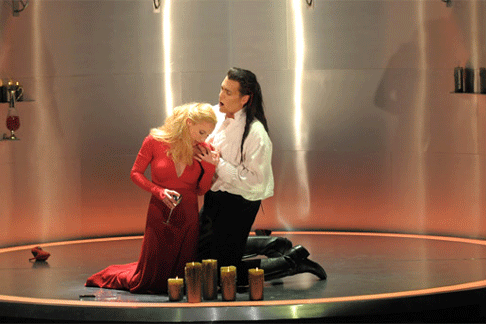 Thomas Hampson as Macbeth and Nadja Michael as Lady Macbeth
Thomas Hampson as Macbeth and Nadja Michael as Lady Macbeth
The final scenes show Macbeth attempting to summon his courage one last time before he hears news of the Queen’s death. Paradoxically, in his final aria “Pietà, rispetto, amore” (“Compassion, honor, love”) Hampson applies an elegance of phrasing and lyrical decoration to give the image of Macbeth, on the point of defeat, still caught up in his self-delusional trust in power. When he hears that he is now alone, he rushes off to do battle against the forces of Malcolm. The final chorus of victory declares that Macduff’s blow to Macbeth has restored trust to Scotland. With this admirable, new production Lyric Opera of Chicago has likewise restored Verdi’s Macbeth to it repertoire of artistic achievements.
Salvatore Calomino
image=http://www.operatoday.com/Macbeth_Chicago_2010_04.gif image_description=Thomas Hampson as Macbeth and Nadja Michael as Lady Macbeth [Photo by Dan Rest courtesy of Lyric Opera of Chicago] product=yes product_title=Giuseppe Verdi: Macbeth product_by=Macbeth: Thomas Hampson; Lady Macbeth: Nadja Michael; Macduff: Leonardo Capalbo; Banquo: Štefan Kocán; Lady in Waiting: Carter Scott; Malcolm: Konstantin Stepanov; Servant/Assassin/Herald/Doctor: Sam Handley; First Apparition: Evan Boyer; Second Apparition: Jennifer Jakob; Third Apparition: Amanda Majeski. Conductor: Renato Palumbo. Director: Barbara Gaines. Set Designer: James Noone. Costume Designer: Virgil C. Johnson. Lighting Designer: Robert Wierzel. Chorus Master: Donald Nally. Choreographer: Harrison McEldowney. product_id=Above: Thomas Hampson as Macbeth and Nadja Michael as Lady MacbethAll photos by Dan Rest courtesy of Lyric Opera of Chicago
Joan Sutherland: My Starter Diva
It is typical of my relationship to the zeitgeist that just as the world succumbed to the joys of the steady back beat, I fell completely in love with voluptuous melody.
I had long loved the tunes of Arthur Sullivan (whose mother was Italian), but bel canto promised a far richer trove. I went to E.J. Korvette’s (remember Korvette’s?) and looked for some likely-looking Verdi. A display offered three new compilation disks (tracks snipped from earlier recordings): Bellini, Handel, Verdi, arias sung by a lady waltzing grandly across the front cover in great swirling swaths of black tulle. I’d never heard of Bellini, associated Handel with chorales. Verdi was the man. The lady’s name was Joan Sutherland. “She’s good; my parents like her,” said my best friend, who was advising me.
Oh, was she good! Oh were the melodies sumptuous (“Ernani, involami”; “Santo di patria”; “Caro nome”; the Bolero from Vespri), and the voice every bit the same, clear as spring water, soaring up and down the scales by clear steps, fast or slow as you like, each tone ravishing, the trills so precise you could distinguish two separate notes, the runs sung just as they were written, the high E-flats in alt brilliant but never shrill. And since it was all in a language I didn’t know, the diction seemed just dandy to me.
Sutherland was the ideal Starter Diva because so much of what she did was technique, on the surface. Once you knew the repertory, you might long for more pathos in a Desdemona, more fire in a raging Luisa Miller, more brooding in a Violetta … but if you were after flawless sound, flawless technique, she was it. I urge tyros not to start with Callas, because the voice’s flaws will irritate you and until you understand the repertory, you won’t understand what she’s doing. Callas did a lot, but much of it was subtle. Sutherland could be subtle, but technically, not dramatically.
I became obsessed as only an adolescent desperate to stave off the sex urge (I knew it was going to be trouble) can be. I bought all her recordings and thirsted for more. The melodies of Alcina and Lucia and Puritani still carry me back to those dizzy, fantastic days; when music was so much more real to me than academics or personal relationships or anything else in my life. In dull high school classes (which was nearly all of them), I would keep myself awake by writing sonnets to Joan. Some of them were acrostics, spelling out her name. All of them were terrible (though when I sent them to her, she charmingly overlooked that fact).
I read her biography, the first one, which made her out to be an unpretentious, unsophisticated, hardworking Australian girl, guided by a clever Svengali husband and a bunch of tough teachers to display her exceptional gifts, fend off terrible health problems, and renew repertory long thought dead. The story was like a Hollywood film, far too good to be true. Later biographies and unauthorized rumors presented a different woman: down to earth, yes, but determined to get to the top if talent and hard work could take her there, very conscious of just who she was and how important to opera, the recording industry and Australia’s self-image, loving a laugh but with no sympathy for the lazy. Ambition and hard work and a firm set of the chin makes more sense than the modest maiden pushed to the forefront. She knew she was remarkable. She knew she wasn’t Lily Pons or Callas, but she was Joan Sutherland. (It is absurd to ask, as mediocre reporters always do, Who is the new Callas? The new Pavarotti? The new Sutherland? The new Horne? The great artists are always unique — therefore, catch them while you can.)
But let’s go back to my first exposure to the Sutherland instrument live and in person. I had written another sonnet and brought a dozen roses. And four albums for signature. But would I have the nerve to go backstage with them? The place: Carnegie Hall, the occasion American Opera Society’s presentation of Haydn’s Orfeo ed Euridice (aka L’anima del filosofo), with Nicolai Gedda as Orfeo, and Sutherland increasing her exposure by copping the bravura aria of a Spirit in Act II. Like Marcel on first seeing the actress Berma, I found it difficult to reconcile my anticipations with the superb but somehow alien occasion. The music was very odd: a chorus of Maenads tore Orfeo to pieces (following the myth, as Gluck does not), but they were Haydn Maenads — imagine a maddened horde of Dresden china shepherdesses. And yes, I got up the nerve to go backstage where I couldn’t think of a thing to say.
A year later, at the Met, in more comprehensible circumstances, a pair of Sonnambulas back to back — but I was not ready to understand Bellini, though many authorities (including her husband) think the simple, naïve Amina is Sutherland’s best characterization. There was a song recital in Newark, with “I Dreamt I Dwelt in Marble Halls” and “Home, Sweet Home” among the encores — the latter drew titters from the hall. Sutherland might really have been happier as a Victorian grande dame, invited to Windsor for the occasional recital.
There was an all-Handel concert at Hunter. In the second half, she came out to sing “Ombre pallide” from Alcina and couldn’t locate the music. Bonynge and the orchestra waited patiently. She turned the pages left, she turned them right. Nervous giggling began among the crowd. The usually bland face was suddenly expressive to a degree, deepening worry, maintaining cool, Aussie housewife “now where did I leave that casserole?” And suddenly, like sun breaking through clouds, relief burst out upon her features and we broke into laughter and applause. She was very communicative — just not in the artificial arena of the theater.
Backstage after that concert (I’d brought a new sonnet and four more albums to be signed — I thought it rude to bring more than four) someone had a recording of Haydn’s Orfeo for her signature. “Oooh, you pirates!” she cried, shaking a finger. But she signed.
A word on her acting: No, she was not a stage animal. As her biographies make clear, she had to force herself to learn to do all that stuff, and she needed careful coaching. Once she had the thing down, though, she had it down — she could do it walking in her sleep — and I mean Lucia or Traviata, not just Amina. But if anything went wrong, she had no idea how to fix it. Either you are the sort who is comfortable on the stage and can ad lib with no trouble, or you are not. It can’t be learned. Sills could improvise, live the role. Sutherland could not. Too, I don’t think her earthy sense of self could quite get the hang of being the loveliest princess in the world, her face dazzling tenors into transports and baritones into skullduggery. She was happier in comedies, making fun of herself, as in La Fille du Regiment — a very Australian trait.
Many’s the time I’ve seen her do something, and thought, “Whatever you do up there, don’t do that!” only to have her — do just that.
There was the Esclarmonde where the director and designer had set her up (she didn’t even have to sing, just stand there) as a Byzantine icon, worshipped by the chorus and Massenet’s incense-like music. But she had to remain veiled (because if a man saw her, she’d lose her magical powers — you know, opera as usual), and the veil was somehow awry. So what? But she couldn’t stop fiddling with the veil. We were all staring (the staging led all our eyes) at her supposedly immobile, dignified, iconic figure, and she couldn’t stop finicking with the goddam veil. All she had to do was not do anything at all. But this did not occur to her.
There was the Trovatore in San Francisco — her first essay at that role, which was not one of her great ones. She had her costumier run up her own costumes, as usual, distrusting house designers. (“What’s wrong with our costume?” wailed a Met flak once. “It’s cheap and vulgar,” said Joan. “Vulgar perhaps, but cheap never!” he replied.) Joan’s costumier apparently thought Trovatore was set in the eighteenth century; in fact, it’s the early fifteenth, and the rest of the costumes reflected this. Too, they were all in blues or browns or a touch of orange. But not Joan: she was in a huge pink farthingale. She did add tremendously to the realism of the second performance (I thought) by remembering to unlock Manrico’s prison before throwing the door wide open. But that was not the moment I best remember from that rather dreary Trovatore. The big moment of shudder that night came during Pavarotti’s “Ah si, ben mio.” The director had him to one side, facing outwards, with Sutherland’s back to us, listening to his every ardent syllable. And she did that. But as she turned towards him, she trod on her long pink underskirt. It was going to be tough to move out of that awkward position, so, imagining that our attention was focused entirely on Luciano’s golden phrases, she took advantage of the quiet to kick the skirt out from under her dress — unaware that, in that lighting and against that brown background, her pink bustled bum was the most eye-catching object in the house, and her every gesture in it was being shoved into our faces.
Then there was her Lakmé in Philadelphia. Joan, playing the lovely daughter of the bloodthirsty Hindu high priest but got up to resemble the Rock of Gibraltar as, I assume, a tribute to the majesty of the British Empire, sang the piss out of the Bell Song and was rewarded with minute after minute of hysteria. On and on it went, longer than the aria. And she was on her knees, and no doubt they were unhappy. At last she looked at us and broke tableau with a gesture: “Oh calm it down, girls,” she might almost have been saying. “It’s just me, you know, and I’m not going to sing it again.” We laughed. She was a pal. It was her moment. Victoria de los Angeles, observing Sutherland on TV, once remarked, “You just look at her and you know she would be such a chum.”
And then there was her final Lucia at the Met — the one captured on video. This is unfortunate, as there was (at nearly sixty) a marked falling off. She lowered the Mad Scene a step, for one thing. For another, where in earlier years (I first saw her sing it in 1970 and 1971), she had run the hundred-yard dash in and out all over the stage, all while tossing off flawless runs and leaps and trills and variations, in 1985 (was it?) she could only manage about twenty yards of dash. I was in standing room for the first two acts, but as the curtain came down on the sextet (remember when they did the sextet properly, with no stupid photographer to mess it up?), a young couple with, no doubt, suburban trains to catch leaped up from seats in Row B on the aisle and raced to the exit. I got there first, and they gave me their tickets. So there I sat for the Mad Scene with my friend Maaike beside me, marveling at how well Joan acted as well as sang a part she had performed over three hundred times at that point.
Then came the moment. She was staring at us, eyes demented, prepared to sweep down and roulade us to death. And her shawl slipped from her shoulders. Out of character, she looked down, hoisted it to one shoulder, then to the other, then back to look at us, ready to sing, in character — demented. Maaike muttered, “Oh God.” Indeed, theatrical tension has seldom been so entirely dispelled.
I said to Maaike later, “You don’t understand. This is what proves Sutherland is a major actress! If Callas or Sills had dropped the shawl, they’d have let the shawl go hang, and we’d never have seen them kick it away. But Sutherland instinctively realizes that to a really madwoman, dropping your shawl is just as significant as stabbing your groom 29 times on the wedding night. They are equally momentous in her eyes! Sutherland has equated them. She has made Lucia real!” No, I didn’t believe that, but I was very proud of concocting it and have used the story many times as an example of how a true opera devotee will defend his diva against all probability and all sanity.
Perhaps the most impressive feat I’ve ever seen on any stage also involved Sutherland. She sang four Rigolettos at the Met in June, 1972; I got to two of them. Ruggiero Raimondi as Sparafucile awed me then and forever by carrying a sack on his shoulder, a sack containing Joan and while singing lowered it gently to the stage it so that Sherill Milnes (not even trying to lift it) could haul it down front, kick it a few times, and out popped Joan, trilling away. At the later performance, Ivo Vinco sang Sparafucile. He had an attendant ruffian with him to carry the sack.
All right enough about her mediocre stage sense. Let’s talk about the voice. It was a cool instrument — another nickname she earned on her Italian debut (La Stupenda is the one everybody’s heard) was “La Callas fredda” — cold Callas. On my personal color scale, which runs from a voluptuous red (Tebaldi) or blood-orange (Leontyne Price) or purple (Caballé) or red-purple (Troyanos) to white-hot (Rysanek) or runny yellow-green (Sills), Sutherland is among the “blue” sopranos — which has nothing to do with “blues” in the pop sense of the term. (Ella Fitzgerald had a blue voice, but Billie Holiday had a blues voice, which is very different.) Diana Damrau is blue. Mirella Freni is blue-ish. Karita Mattila is ice blue. Regine Crespin was deep blue shading to violet. Sutherland was true blue (like the Garter ribbon). There is a coolness here that can take on the passion in the music but does not inject passion where the music lacks it, could possibly use it.
There were two or three Sutherland voices with the passing of time. I call these the Silver voice and the Golden voice and (after 1981) the droopy voice. When Sutherland made her first recordings in the late fifties and early sixties (Emilia di Liverpool, the first recital (with her perfect “O luce di quest’ anima”), the first Lucia and Rigoletto, The Art of the Prima Donna, her voice sounded smaller than it was, bell-like as the canary sopranos of old but truer because more firmly grounded in dramatic soprano technique. (Callas, too, learned her amazing flexibility after dramatic training, and it shows in the guts she could bring to Anna Bolena or Il Pirata. Ditto Caballé, who like the other two ladies thought she was destined for dramatic soprano-dom.) Well, fluttery has its place (Zerbinetta, Philine, Olympia), but I like to feel, to hear, that the glorious façade rests on sturdy foundations.
The silver voice, the airy flights, the easy passagework faded after a vocal crisis around 1962. By1963, when she recorded her first Norma and Traviata, and 1964, when she recorded Command Performance and Alcina, the silver voice was gone forever. In its place was what I call her Golden voice: molten honey caressing the line. She could still do ornaments to make anyone gasp (the first Puritani and Semiramide), but the flavor is different. It is a tribute to her skill (and Bonynge’s coaching) that so little was lost, that her ability to race through the notes was so little affected. But she had to re-learn everything in her repertory, and while it sounded good, even great, it did not sound the same. She could no longer be a girl — she was always a woman.
An old obnoxious opera friend, Stan Cohen, the sort who disparage almost everything and insult you for daring to have a differing opinion, used to say, “You should have heard Sutherland in the sixties! The chances she took! The perfection!” Happily, pirates of those Puritanis and Semiramides and Donna Annas do survive. Security was important to her, and she never took a high note and didn’t make it (if she didn’t think she had it, she’d transpose it). Her days of triumph were incredible. The story goes that after she first sang Norma in the U.S., in Philadelphia, Monsterrat Caballé came backstage to rave about the performance. Joan said, “Ah, but after you sing it, they won’t come to hear me sing it.” Caballé, flabbergasted (and she’s no blushing violet), replied, without thinking, “Oh I could never sing it. I don’t have the high notes.” “You don’t need them!” laughed Joan. “They’re not in the score!” Indeed, she was the first soprano ever to sing “Casta diva” in the original key, Bellini having lowered it for Giuditta Pasta before the premiere.
Such chances indeed: In Traviata, she used to toss off the elaborate Tetrazzini variation to the end of “Sempre libera,” which is not exactly true to the dramatic situation (Violetta is hysterical, yes, but also emotionally exhausted) but sure is an impressive bit of vocalism. She didn’t make a big thing out of it; she just sang it for sheer fun, to give us a memorable thrill.
I heard Sutherland’s Norma at the Met in 1970, twice in the spring and twice in the fall, with Horne three times, Cossotto once. She did it in four acts rather than two, and the production was as ugly as most Norma productions tend to be. The fourth Norma was a surprise, an event. We settled in for the prelims and the Druids’ march (has it ever been more rumpty-tum than in Bonynge’s hands? But nothing can save that silly march) and then Joan singing another perfect “Casta diva,” oh ho-hum. In fact, since that day, I have heard it sung perfectly by only two other sopranos, Montserrat Caballé and my friend Ann Donaldson. Sutherland and Caballé made Norma seem so easy that, losing their traditional wary respect for the role, all sorts of ladies with no business doing so attempted Norma and faced varying levels of opprobrium for it: Rita Hunter, Renata Scotto, Shirley Verrett, Jane Eaglen, even Sills. But only dimly did I guess back then how lucky I was. (Callas fans were livid. A lapel button frequent at the Met: “Sutherland is Chlotilda” — the confidante role Sutherland had sung to Callas years before.)
And then, that fourth “Casta diva,” came a surprise: As she rose to that first D in alt (ah-ah, ah-ah, ah-ah, ah-ah, AH) — she blew the note. Shock rippled through the house. Sutherland blew a note! This had never happened. Every other singer, sure. Don’t stop the presses. Some of them made whole careers out of it. But not Sutherland!
What it felt like was someone climbing a flagpole, only to find the ball at the top has been greased. She went for it — and over the top and down the other side. Except she pulled herself up short and tried again — and went back over the other side, wobbling about, trying to find the secure seat — at the top of a greased flagpole. No one would be surprised if a singer panicked at this point, but Sutherland was all pro, no panic. She held herself steady in that precarious position. And a strange thing happened in the orchestra, where we assumed Bonynge could do nothing but beat time: He did have control, and he exercised it now, and the orchestra abruptly were playing twice as slowly as before — as if reaching out a steadying arm to guide the soprano down the flow of arpeggios to the end of the verse. And this was just the first verse.
Let us imagine her feelings at this point: The voice is not in perfect control and another verse of “Casta diva” must be sung, and every one of the four thousand people present is at seat’s edge and wide awake, not believing what they were hearing, aghast to hear more. You could have heard a pin drop or a bracelet rattle — but no pins dropped and no bracelets rattled in all the house.
And, a little bit slower, a little bit more carefully, she sang the second verse and, as the chorus joined in, ascended the mountain of fioritura to the climactic D. And sang the most flawless verse of “Casta diva” that has ever been sung — since Ponselle anyway — maybe since Malibran (who transposed it). It was a perfect feat of singing, each note a rounded outsize pearl the same size and texture as each other note, the evenness that was the bel canto singer’s ideal in each phrase — to the swift descending chromatic scale without a note smudged that concludes the hymn. Bid set, made and won. If it had been anyone but Joan, you’d almost suspect her of doing it on purpose just to get us to pay closer attention, but she never went in for that kind of swank. (Of Scotto, I’d believe it.) And only complete coolth, complete professionalism could have brought it off.
Bonynge usually tried to suppress applause after arias and hurry on to present the succeeding cabaletta as part of a unity, but that night he laid down his baton and sat back while we roared for quite some time. Only then did Joan, clearly feeling her oats, throw herself into two ornamented verses of the delicious cabaletta. Not exactly introspective on this occasion, but who cared? It was an occasion. We were thrilled to be there.
And we suddenly realized why she insisted on having her husband in the pit: She was scared. She had made a lot of recordings, her fans knew them well. She was beginning to be unsure she could compete with studio perfection. She needed all the support she could get. It is a problem faced by every recorded artist. We used to mutter that Ricky selfishly insisted he be part of her contract package, but I don’t believe this was true: A letter in the Met Archives from the management — evidently of my mind — asked Bonynge if he’d mind his wife singing a performance with another conductor on a date when he was obliged to be out of town. He replied that he’d no objection at all, but he didn’t think she’d do it.
Act II of that famous Norma, by the way, ended with one of those interpolated high notes Sutherland placed in the score, ending (in this case) the tremendously exciting trio Bellini had composed. (Angela Meade sang it in her Caramoor Normas last summer.) I was seated in the top row of the Family Circle, a fathom and a furlong from the stage. The kid next to me shocked me by attending the opera in a see-through shirt (or maybe I just envied him his skinny torso). When that note, solid on its flawless breath control came out at us, building and building and building and then at the peak of our endurance (we were all holding our breaths), abruptly descended to the tonic to end the act, the chest of the kid in the see-through shirt expanded until it nearly burst through, he seemed to be having some sort of seizure, and only when Joan let her breath out did he collapse, spent (in some way or other), into a huddle in his seat. I forgave so responsive a music-lover his bêtise of dress.
The mid-seventies were a difficult time for New York opera-goers. Eternal verities were challenged. Rudolf Bing may have been idiosyncratically out of date (he adored obscure Verdi, but he never took bel canto seriously), but at least he had been in charge. After he left, in 1972, for a dozen years no one seemed to be in charge. Deals were done and undone and many chances missed. Sutherland brought her Fille du Regiment from Covent Garden to the Met with the Pav (and, later, Alfredo Kraus), and it was a triumph — she loved to cut up on stage — and then a gorgeous Puritani in 1976 with a starry cast, the Pav, Milnes and James Morris, to back her up. Puritani is a long night; at the prima she looked frankly exhausted; by the last one, she was having fun and tossing the roses that had been thrown to her back among the audience (after giving one to Pav and one to Ricky to be sure). Then there was the Hoffmann in (yet another) new edition, where her Olympia had big painted pink roses on her cheeks, her Giulietta descended from the top of the stage to the bottom in a suspended gondola against a watery backdrop, and her expiring Antonia was loud enough to wake a sanitarium.
Then, for some reason, she quarreled with the powers running the Met. They asked her to sing Konstanze in Mozart’s Seraglio, and though Mozart was not a great composer for her (though her Donna Anna on record — made in her Silver era, and under Giulini’s careful control — is superb) she assented, on condition that the Met do her a favor and give her The Merry Widow. She had the production already; they’d only have to rent it. It may or may not have been a mistaken idea, but the operetta works in the Met, as Frederica von Stade and Placido Domingo proved some years later. The Met was unwilling to trust her. I’m not sure what the third opera in this package was to have been — perhaps Luisa Miller or Ernani, but I was hoping for Semiramide or Les Huguenots or Lucrezia Borgia — but instead three or four years passed with no Sutherland at all, and this was the more to be regretted because she went through another vocal crisis around 1980. Another soprano of equal success might have retired at this point, but for whatever reasons — she was used to acclaim, a hard taste to renounce — she went on. And it wasn’t the same. There were roles she should not have sung, second recordings that did not match the first ones, a few trainwrecks.
Opera lovers who began to attend in the eighties and were only going by what they heard (as is natural) scowled at Sutherland. She was so unconvincing an actress — a thing that had always been important but was becoming more so in a televised generation. Callas, lately dead, was now deified, and if Sutherland surpassed her in vocal gift, she never pretended to match her in dramatic instinct. She had worshipped Callas, but she never imitated her — and she was right not to try.
Over the years, I heard Sutherland in several concerts and galas and in fourteen complete operas: the Haydn Orfeo, Bellini’s Sonnambula, Norma and Puritani (no one but Joan ever got new productions of all three out of the Met), Donizetti’s Lucia, Maria Stuarda and Anna Bolena, Massenet’s Esclarmonde, Delibes’s Lakmé, Mozart’s Don Giovanni — alas, not the run with Solti conducting in the late sixties but a decidedly inferior group under Bonynge ten years later — Verdi’s Rigoletto, Trovatore and Traviata, and the four heroines in Offenbach’s Tales of Hoffmann.
The later performances were not up to standard: Anna, Lucia, Leonora, Elvira. She had become, as many of the younger fans sneered, “Moany Joanie.” Her pitch tended to sag below the note, although she could usually rise to a brilliant top. I thought the old mezzo training was coming through nicely, and that with retraining and study of a new repertory, she might have a new career. Her lower register was a cello register, Stradivarius-hued. What an Erda or Favorite she might have been! But why should she bother? She was nearing sixty, she was rich, she had a title, she was the living symbol of Australian never-say-die athleticism in her art.
When Tito Capobianco ran Opera San Diego, made a point one year of hiring Sutherland to sing Rosalinda in Fledermaus when he had already persuaded the soon-to-retire Beverly Sills to sing Adele. The ladies, whose fans were at daggers drawn, had never met, and became great friends instantly. (Sutherland used to sing the Czardas in Hungarian, not that anyone could tell.)
A year or two later, when Sills was director of the City Opera, I ran into them strolling, regally tall, arm in arm, through the promenade of the State Theater. The occasion was the City Opera’s first Alcina, the Handel opera first unearthed for Sutherland. The star was Carol Vaness — and if she was nervous in Sutherland’s presence, she gave no sign of it in a magical performance. Sutherland sat prominently in the first seat in the First Tier, applauding everything heartily — but getting an ovation herself at the beginning of Act III. Her recording of the opera (with a breathtaking supporting cast: Berganza, Freni, Sciutti, Alva, Flagello) seems very old-fashioned today, when we have all learned a great deal more about baroque opera, but the rhythms are sprightly and the vocalism sensational. It is an adorable document.
I kick myself for missing some of Joan’s mid-career performances I could have attended — she’d given up Handel (those original Alcinas must have been astonishing), but I could have seen her in Beatrice di Tenda and Lucrezia Borgia (her video recording of this last, though late, is quite fine) and, most tragically of all, Semiramide, which she sang at the Lyric Opera of Chicago when I, who had never been west of Pennsylvania, was too penniless and nervous to risk a trip to so big and bad a city. I had also missed, by a year or so, her concert Semiramide at Carnegie Hall. I’m told she wore a gown of red sequins, shimmering regally, with a white cashmere shawl over her shoulders and bosom in the opening scene. She returned in this getup in the second scene, and as the prelude of her aria, “Bel raggio lusinghier” (“A bright ray of sunshine illuminates my heart”), was played, she let the shawl fall away — revealing that the front of her sequined gown was a glittering sunburst, perfectly synchronized with the text and the explosive showpiece she was about to sing. Let no one doubt she was a diva of the highest order.
I hope her copies of those awful sonnets never turn up.
John Yohalem
image=http://www.operatoday.com/Sutherland_Joan.gif image_description=Joan Sutherland product=yes product_title=Joan Sutherland: My Starter Diva product_by=By John YohalemSalome at the Washington National Opera
The horizon looks brighter these days, thanks to a brand-new production of Richard Strauss’ decadent blockbuster, Salome (1905), based on Oscar Wilde’s infamous play. Staged by a sought-after drama and opera director Francesca Zambello, this production is an impressive experience. The central element of the set is a floor-to-ceiling, transparent plastic curtain that separates the dark courtyard of the proscenium, with the cistern at its center, from the illuminated banquet table at the back of the stage. In her comments about the production, Zambello discusses her vision of Herod’s court being trapped in an endless cheery feast, as imprisoned in its public role as Jokanaan is in his cistern, and much less free. The plastic indeed gives an impression both of artificiality and of being enclosed, wrapped up, vacuum-sealed. Additionally, it provides a grateful surface for the lighting designer Mark McCullough, whose vivid colors flooding the stage in gold, blue, purple, and blood-red glow is one of the most important aspects of the production.
The main attraction of the evening was acclaimed American dramatic soprano Deborah Voigt as Salome. Throughout the performance, Voigt had no trouble defending her reputation as one of today’s definitive interpreters of this fiendishly complex role. I say this despite the fact that the singer’s low register is much less powerful than her high, so some phrases, especially in the chatty opening scenes, tended to get lost in the orchestral fabric, for no live performer of this role can expect to carry its every note equally; the only perfect Salome is a recorded one. What is perhaps most fascinating about a staged production of this opera is watching the lead singer read the title role. Which of the numerous possible variations of Salome’s character, her relationship to her family, and the motivations for her obsession are we going to see? Is this Salome to be condemned or redeemed; is she a victor or a victim?
Voigt’s interpretation seems to follow what one might call a Teresa Stratas model. She plays Salome “young”; vulnerable and strangely innocent, she is like a spoilt, mischievous child longing for a toy, trying to articulate her desires more to herself than to their object. The director’s reading of the story suggests that although Salome is habitually molested not only by her stepfather, but also the soldiers of the palace guard, she is not mature enough to process the experience. She flirts with anyone who has the power of getting her what she wants, but seems not to comprehend her counterparts’ reactions to her presence. In her unguarded moments, she responds with an almost violent repulsion to any male’s physical proximity to her, however innocent. Thus, we begin to understand her immediate fascination with the hidden Jokanaan: she is attracted to his “absence”; to the unreality of his disembodied voice carried powerfully out of the cistern.
Salome is a dark opera; literally dark, as the libretto specifies a nighttime setting, and psychologically dark, the story tailor-made for a twisted Freudian reading. What struck me as unusual and unexpected in Voigt’s interpretation are the moments when she radiates a palpable sense of joy, quiet shimmering contentment. The singer starts her final “Apostrophe to the Head” softly, almost whispering.
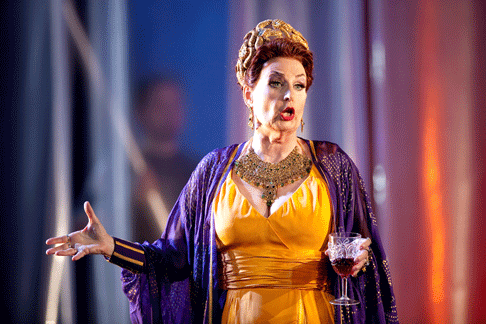 Doris Soffel as Herodias
Doris Soffel as Herodias
She takes her time closing in on Jokanaan’s severed head, savoring the experience of the first kiss (perhaps – or so Voigt would have us believe – it really is her first one). This scene, often a place of unrestrained hysteria, is understated, at times almost demure. Salome’s clothing incorporates a gown of deep red (similar to Maria Ewing’s costume from the Covent Garden production) over a white dress resembling the one Catherine Malfitano wears in the Met staging. Yet, by the end of the scene, Voigt’s Salome is not bathed in blood like Malfitano’s. Rather, only the tips of her fingers are bloody, like a shiny manicure; she then touches her fingers to her cheeks, as if applying rouge to match her pretty dress. This Salome does not embrace the horror of the experience; her world is entirely outside it.
The only disappointing moment of the role was its most anticipated one – the Dance of the Seven Veils. It seems that Zambello and the choreographer, Yael Levitin Saban (or perhaps Voigt herself, depending on who made the ultimate decision about how to stage the scene) could not make up their minds about how risqué they wanted the dance to get. So, the veils came off, but were immediately replaced by other veils (provided by four dancing assistants – all, alas, much younger, thinner, and more flexible than the star attraction). Voigt performed the dance herself rather than being replaced by a double, but her efforts seemed half-hearted, with barely a movement of the hips and much awkward arm waving. Finally, on the ultimate question: “to strip or not to strip” (the question that every Salome watcher wants answered!), the decision was apparently to do both (or neither?): at the end of the dance, Voigt appeared in a thick, unfortunate-looking bodysuit for about a chord and a half, before being covered with the veils again. Overall, it looked like Herod made a bad bargain: this dance was not worth a hair off the prophet’s head.
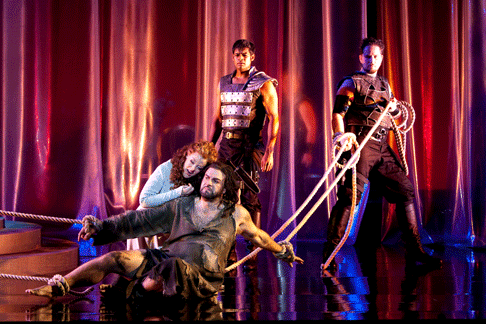 Narraboth (Panikkar) and the Second Soldier (Rhodovi) look on anxiously as Salome (Voigt) tries to entice Jokanaan (Sumegi)
Narraboth (Panikkar) and the Second Soldier (Rhodovi) look on anxiously as Salome (Voigt) tries to entice Jokanaan (Sumegi)
Particularly this prophet, for Australian bass-baritone Daniel Sumegi stole the show as Jokanaan. His deep, thunderous voice and his carpenter physique accentuated by clever body make-up made Salome’s lack of self-control feel entirely plausible. Strauss does not give a Jokanaan performer much to work with: his lines are squarely diatonic, monotonous, and dull. Yet Sumegi (under Zambello’s inspired direction) brought an unexpected complexity to the role by placing Jokanaan into an unusual physical proximity to Salome and thus forcing him to respond, perhaps against his will, to her vital, lustrous sensuality. This Jokanaan is forced to feel for Salome the same passion exhibited by every male character on stage, from Herod to a common soldier. We see him visibly tearing his hands away from her each time he forces himself to reject her. The moment toward the end of the duet when Salome melts into his arms as he is rocking her back and forth, like a child, their bodies bathed in a golden light and their faces lifted upward in ecstasy (both spiritual and sensual) at their impossible union is a masterstroke. Although one does wish that particular golden color were used more sparingly, or perhaps even saved for that climactic moment. As it is, the gold shimmer that accompanies just about every sound uttered from the cistern in the opening scene might be a bit of overkill. It is as if Zambello was trying to counteract the composer’s atheism and his evident dislike of Jokanaan’s character by validating the imprisoned prophet’s every word. It almost makes one sympathize with poor Herodias, who does not believe in miracles and wishes that the annoying man would just be quiet.
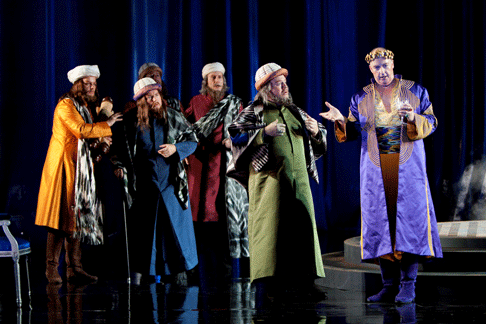 Herod (Berkeley-Steele) explains to the Jews (Weber, Bailey, Rotz, Augustin and Morris) how he thinks Jokanann is a holy man.
Herod (Berkeley-Steele) explains to the Jews (Weber, Bailey, Rotz, Augustin and Morris) how he thinks Jokanann is a holy man.
Speaking of the Queen of Judea, German mezzo-soprano Dorris Soffel, in her WNO debut, was a fabulously unpleasant Herodias – cold, ambitious, greedy, jealous, and proud. Her powerful voice carried easily over the orchestra and over her husband’s shy tenor. She also held her own well in a power struggle with Voigt’s Salome; when Herod says despairingly: “she is her mother’s daughter,” he only confirms what the audience has already perceived. British tenor Richard Berkeley-Steele was undoubtedly the weakest of the soloists, yet he proved an effective Herod – a feeble personality entirely dominated by his women and unable to decide whether he was more terrified of God’s prophet or his own wife. Equally effective in his role was young American tenor Sean Panikkar (Narraboth), whose clear tenor carries both the metal of a soldier and vulnerability of an infatuated youth. Panikkar, who has also made his WNO debut in this production, is a wonderful find; hopefully, we will hear him in Washington again. Cynthia Hanna, on the other hand, was a disappointing Page.
Zambello’s new staging and much of the vocal cast was not all that was new in WNO’s Salome: the orchestra was led by its newly appointed music director, Philippe Auguin, whose selection was announced mere two days before the premiere. Auguin is familiar to the Washington audiences from his acclaimed concert performances of Götterdämmerung last November, and the ensemble appears to have welcomed his presence at the podium. It has palpably reawakened under Auguin’s deft leadership, and acquitted itself creditably in the extremely complex Strauss score. There were still issues of balance: at one point, the timpani were so outrageously loud that they made Voigt’s already difficult job of out-singing a late Romantic orchestra well-nigh impossible. But at least, the musicians were in tune, and the embarrassing lapses in the winds and brass that I often remarked upon in my previous WNO reviews have been mostly avoided. While some moments worked better than others, their performance allowed the audience to be swept away by the feverish intensity of the score, matched almost without exception by the director’s vision.
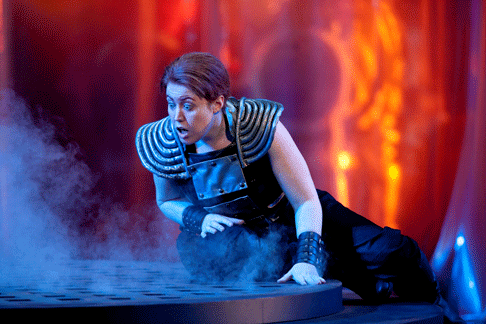 Page of Herodias (Hanna) peers into the cistern.
Page of Herodias (Hanna) peers into the cistern.
The main difficulty in staging Salome, in my opinion, lies in the fact that Richard Strauss conceived it as a true music drama. The production only works if all its elements – the rendition of the score by singers and orchestra, the sets, the costumes, the lighting, the acting and the stage movement – are of equally and consistently high quality. Even by this admittedly impossible standard, I would call WNO’s new Salome a success. Let us hope that the company’s spring line-up of Madama Butterfly, Iphigénie in Tauride, and Don Pasquale proves as memorable.
Olga Haldey
image=http://www.operatoday.com/Voigt_076_cr.-Scott-Suchman.gif image_description=Salome (Voigt) revels in finally getting Jokanaan's head [Photo by Scott Suchman courtesy of Washington National Opera] product=yes product_title=Richard Strauss: Salome product_by=Salome: Deborah Voigt; Herod: Richard Berkeley-Steele: Jokanaan: Daniel Sumegi; Herodias: Doris Soffel; Narraboth: Sean Panikkar; Page: Cynthia Hanna; Slave: Jegyung Yang; First Jew: John Weber; Second Jew: James S. Bailey; Third Jew: Corey Evan Rotz; Fourth Jew: Tim Augustin; Fifth Jew: David B. Morris; First Soldier: Grigory Soloviov; Second Soldier: Christopher Douglas Rhodovi; Cappadocian: Aleksey Bogdanov; First Nazarene: Robert Cantrell; Second Nazarene: Robert Baker. Conductor: Philippe Auguin. Director: Francesca Zambello. Set Designer: Peter J. Davison. Costume Designer: Anita Yavich. Lighting Designer: Mark McCullough. Choreographer: Yael Levitin. Washington National Opera. product_id=Above: Deborah Voigt as Salome (Voigt)All photos by Scott Suchman courtesy of Washington National Opera
October 12, 2010
Promised End — English Touring Opera
His words perhaps recall the aged Lear’s earlier hope that he might one day “Unburdened crawl towards death”. Or, as Edgar interprets, they may evoke the more terrifying image of the Day of Judgement. Whatever they infer, choosing Kent’s words as the title of an opera which — its sub-plots stripped away, its minor (and some major) characters shorn of significance — lasts less 90 minutes but which leaves the audience longing for the eponymous conclusion, is a potentially dangerous move.
It’s not that Alexander Goehr’s new opera has no musical or theatrical merits. Indeed, the first act moves briskly along and, for one unfamiliar with its poetical predecessor, raises a few interesting ideas. But, the second act rapidly loses focus; essentially this ‘personal take’ on Lear has little to say or reveal.
“It’s about old men who get it wrong when they have power and influence — and then get into a mess. That’s the reason I’m doing this opera. […] As an incipient old man myself, that’s what interest me about the story. I mean, I can do Romeo and Juliet now — I’m past that stage.’”
So Goehr declared in a recent interview in The Guardian, explaining his decision to tackle one of Shakespeare’s most complex, profound and disturbing plays, and one which defeated even Verdi and Britten, who abandoned long-held ambitions to compose an opera based on King Lear. Now aged 78, Goehr professes that the impetus to tackle Lear came when, suffering from depression upon retiring (reluctantly) from his Professorship at Cambridge University, he happened to have a dream in which the play was ‘staged as a Japanese Noh play’. The resulting opera mingles Noh stylizations with Elizabethan conceits but the sum of the parts lacks substance and coherence. One is reminded less of the successful cross-cultural integration of Noh practices with the medieval Mystery Plays in Britten’s church parables and rather more of the somewhat laboured device of the Male and Female Chorus in The Rape of Lucretia. Conway’s production — in which the chorus of principals stand (à la Brecht — another layer of cultural reference) white-faced and stock-still, motionlessly addressing the audience, ritually step through boxes of sand, and indulge in stylized dance movements (for example to accompany the blinding of Gloucester) — taps into the Noh clichés but offers little illumination.
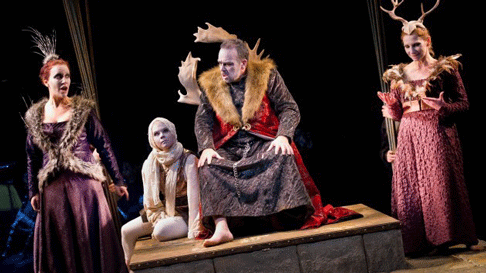
Indeed, the shadow of Britten hangs over this opera in more ways than one. The decision to use Shakespeare’s text verbatim recalls the approach of Britten and Pears when constructing the libretto of A Midsummer Night’s Dream. In this case, the eminent scholar, the late Frank Kermode, fashioned a libretto which Goehr has arranged in ’24 preludes’. But, while reducing the work to a manageable length — excising several (essential?) aspects of the drama and focusing on the central exchange between Lear and Gloucester — this still leaves the problem of how to find an appropriate melodic idiom for Shakespeare’s poetry. Goehr’s rather spiritless arioso simply does not convey the rich depths and meanings embodied in the sounds and rhythms of the spoken play. Moreover, the composer’s re-ordering of various episodes destroys the narrative coherence and makes it near impossible for anyone lacking knowledge of the original play to follow the psychological development.
The singers and players of English Touring Opera do their best. Lisa Markeby, playing both Cordelia and the Fool — a now familiar theatrical device — is appealing, but she is not given the opportunity to develop and express the full extent of her inner goodness. And, while the expressive focus of the opera is supposedly the meeting of the two foolish old men, Lear and Gloucester, now chastened and wiser as they reflect on their short-comings, the musical fabric fails to convey their supposed transformation. Roderick Earle bellows and blusters as an aggressive Lear, his scenes with Nigel Robson (Gloucester) lacking genuine emotional depth and sincerity. As Edgar, Adrian Dwyer is convincing and impressive. Goneril (Jacqueline Varsey) and Regan (Julia Sporsen) are not musically differentiated and have little dramatic role to play.
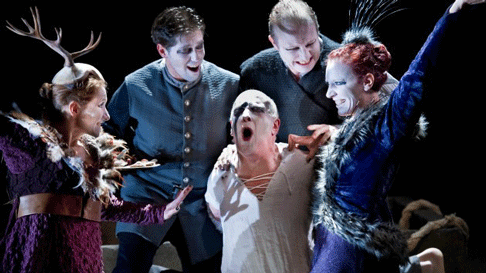
Ryan Wigglesworth draws clear lines and textures from his band, the Aurora Orchestra. Goehr does create some interesting colours, not least through his use of the chamber organ and guitar — which evoke fittingly Elizabethan timbres — but the composite impression is one of episodic, unrelated colourings designed to fill the gaps between scenes.
In his programme note, Goehr asks for the audience’s indulgence: “So it remains only for me to say, that you will not be home too late and ask that by your clapping you show some approval for what has been done here.” This seems to me to be a patronising appeal to an audience that may long for a less superficial musical response to a play that interrogates essential questions of human existence.
Promised End is at the Linbury Studio at the Royal Opera House, London on 11, 14, 16 October and then tours until 26 November. For touring details see www.englishtouringopera.org.uk.
Claire Seymour
image=http://www.operatoday.com/Promised_End_01.gif image_description=Photo by English Touring Opera product=yes product_title=Alexander Goehr: Promised End product_by=Lear: Roderick Earle; Goneril: Jacqueline Varsey; Regan: Julia Sporsen; Cordelia: Lisa Markeby; Gloucester: Nigel Robson; Edgar: Adrian Dwyer; Edmund: Nicholas Garrett; Knight/Servant: Jeffrey Stewart; Servant/Captain: Adam Tunnicliffe. Director: James Conway. Conductor: Ryan Wigglesworth. Designer: Adam Wiltshire. Lighting: Guy Hoare. English Touring Opera. The Aurora Orchestra. Linbury Studio, Royal Opera House, Covent Garden. Saturday 9th October 2010. product_id=All photos courtesy of English Touring OperaOctober 11, 2010
Marriage of Figaro in San Francisco (and Los Angeles)
The September 23 performance teetered on the edge of madness with the overture used as a projectile to ignite the eighteenth century social unrest that is Le nozze di Figaro. The unrest was not only social, it was also musical for the porcelain-like figurines who embodied Mozart’s by now mythical characters. Their struggle, usually successful, to keep apace with the musical force was heroic, with even unexpected fruits — beautiful agogic accents occurring when a voice fell slightly behind the beat.
If Mo. Luisotti unabashedly strives for effect, its motivation is musical and not mere showmanship. The maestro here met his match in the case of his Susanna, Danielle de Niese and his Figaro Luca Pisaroni, the play of tempos with vocal line was even sublime. The exposition of the story in the first scene was a masterpiece.
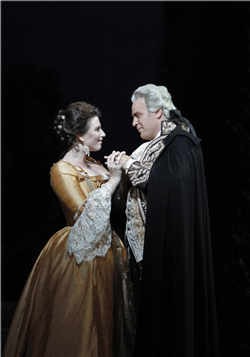 Ellie Dehn as the Countess and Lucas Meachem as the Count
Ellie Dehn as the Countess and Lucas Meachem as the Count
John Copley staged the opera. Mr. Copley is the most musical of directors, merging word and vocal line with movement in perfect concert with storytelling. It is manifest in continuous movement and dramatic flow which was exemplary Copley in the performances of this Susanna and Figaro. Indeed throughout much of the first act and with all of the cast a sense of uneasy perfection prevailed amongst pit, voice and stage.
The maestro’s illumination of musical line and the visual artifice supplied by Mr. Copley created the abundance of detail that resulted in the figurine quality of the cast. Gracefully dominated on September 23 by Mlle. de Niese and Mr. Pisaroni it was otherwise an ensemble cast of gifted singing actors — Michèle Losier as Cherubino, Lucas Meachem as the Count and Ellie Dehn as the Countess, with grand, experienced performances by Catherine Cook as Marcellina, John Del Carlo as Dr. Bartolo and Greg Fedderly as a stylistically exact Basilio.
The sense of exquisite detail that prevailed extended to the smallest roles — a rashly drunk Antonio sung by Bojan Knezevic and the Don Curzio sung by Robert MacNeil.
All this surface artifice played against a vaguely house-like wooden structure that was vaguely indoors/outdoors as needed, and it could also be used for Barber and Falstaff or Turn of the Screw for that matter (best not to mention this to SFO MBA David Gockley). It was built in 1982 for another director and already once visited by Mr. Copley before being taken over by legendary Susanna, Graziella Sciutti turned stage director. Surely it will now go directly from the War Memorial to the dump.
Mo. Luisotti exposed very nimble fingers at the continuo fortepiano, and nimble musicality superimposing a bit of Lohengrin, snatches of Mozart piano sonatas plus a touch of Eine kleine Nachtmusik (and who knows what else) from time to time. Everyone was having so much fun that when things got serious things fell apart. The second part (the third act) brings the big showpiece arias that require big artists to command big theaters. It was beyond the scope of this fine cast who had so brilliantly executed the ensembles of the first part (acts one and two).
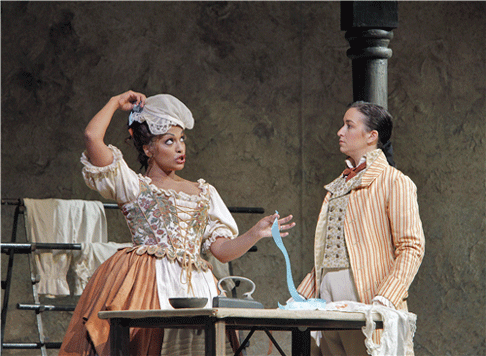 Danielle de Niese as Susanna and Michèle Losier as Cherubino
Danielle de Niese as Susanna and Michèle Losier as Cherubino
To the delight of everyone the maestro and the director exploited the agility of this responsive cast to the degree that when Count Almaviva knelt to beg forgiveness we all laughed because we were so used to being amused by the musical and physical antics. Of course this moment is deadly serious, and after the fact the maestro did try to save the day by imposing a sudden largo. It was too much too late.
After its Ring cycle last spring Los Angeles seemed like the big time, operatically speaking. Its concurrent (to San Francisco) Marriage of Figaro has confused this perception. Seen October 6 three new cast members (Susanna, Marcellina and Barbarina) were being integrated into the cast. This situation alone was sufficient to distort its staging rhythm.
The Marriage of Figaro is central to the repertory of all opera companies. In 2004 L.A. Opera unveiled this Ian Judge production (in its initial years L.A. had relied on the Peter Hall production from Chicago). Now six years later the Judge production still passes as a contemporary statement, needing only a cast and conductor to bring it alive.
Designed by Tim Goodchild (a Brit with extensive theater credentials, like Mr. Judge) it is business like — a back wall of a different saturated color for each scene, a few chandeliers coming and going, and sensibly enough a house on an horizon (like TV’s Dallas) overlooking an extensive dark park illuminated by a huge moon (yes, it is very Halloween though surely this is not its intention).
The costumes, designed by Diedre Clancy, another of our mainstream British cousins, made up in slickness what they may have lacked in inspiration. Clever and surprisingly harmonious was the mix of styles and periods. Not to mention Mr. Judge’s tricky use of a telephone in the Countess’ bedroom and flashlights in the garden in this predominantly period production.
All this high style was not requited by either the conducting or the singing. Placido Domingo was in the pit, by now a very beloved L.A. personage it seems judging from the huge ovation awarded him. In the first part (acts one and two) he imposed tempos that were quite convenient for the singers but lacked the Mozartian impudence that keeps Figaro forever alive.
If the first part of Figaro is about Mozart the second part (acts three and four) is about singers as each are awarded a showpiece aria. Here Domingo was right on with the evening’s stars — Bo Skovhus as the Count and Martina Serafin as the Countess — giving them everything they needed to tear up the stage. And that they did, Mr. Skovhus, though small of voice managed some elegant musicianship rushing back and forth across the stage. Mme. Serafin, of big, very big voice, musically well controlled to be sure was a far more determined Countess than a reflective one (after all la Serafin is usually a Tosca).
These larger scaled performances established an emotional focus for Mozart’s comedy that brought to mind the silly notion that The Marriage of Figaro is the perfect opera. But to subvert any attempt at a perfect realization L.A. Opera succumbed to the too prevalent practice of sending boys in to do men’s work, i.e. expecting talented young singers from an apprentice artist program to embody important Mozartian personalities, and otherwise entrusting character roles to unseasoned artists.
Rebekah Camm gave a fine performance as Susanna, though she does not look like a typical Susanna, and as well she was stepping into a part already staged for another singer (Marlis Petersen sang the first three performances). Daniel Okulitch fulfilled the basic needs of the Count’s major factotum without imparting grand personality and Renata Pokupic made a convincingly adolescent Cherubino.
On October 10 San Francisco Opera introduced four new singers into the last three of its nine performances of Le Nozze — Kostas Smoriginas as Figaro, Heidi Stober as Susanna, Trevor Scheunemann as Almaviva and Dale Travis as Bartolo.
For messieurs Scheunemann and Travis the transition was seamless, both artists blending into the ensemble and upholding its precision. Mr. Smoriginas and Mlle. Stober introduced their own particular tonalities. Both are very warm performers with strong voices, who found themselves at odds with the maestro in the opening scene. A compromise seemed to be reached soon enough resulting in convincingly human performances from these two artists that took the Copley production to another level.
In the end we still did laugh when the Count knelt to beg the Countess’ forgiveness, but in this performance Mo. Luisotti grasped the depth of meaning in this gesture, and infused a warmth and understanding into Mozart’s music that exponentially complicated the situations of the four sets of lovers lined across the stage. This unexpected realization spread slowly through the audience as the last ensemble unfolded, leaving us again smitten by this astonishing work of art.
Michael Milenski
Los Angeles Cast:
Figaro: Daniel Okulitch; Susanna: Rebekah Camm; Count Almaviva: Bo Skovhus; Countess Almaviva: Martina Serafin; Cherubino: Renata Pokupic; Marcellina: Tracy Cox; Doctor Bartolo: Alessandro Guerzoni; Don Basilio: Christopher Gillett; Antonio: Phiilip Cokorinos. Conductor: Plácido Domingo. Director: Ian Judge. Scenery Designer: Tim Goodchild. Costume Designer: Deirdre Clancy. Lighting Designer: Mark Doubleday. Choreographer: Sergio Trujillo
image=http://www.operatoday.com/Nozze_SFO_2010_01.gif
image_description=Danielle de Niese as Susanna and Luca Pisaroni as Figaro [Photo by Cory Weaver courtesy of San Francisco Opera]
product=yes
product_title=W. A. Mozart: Marriage of Figaro
product_by=Figaro: Luca Pisaroni (9/21 - 10 - 5) / Kostas Smoriginas (10/10 - 10/22); Susanna: Danielle de Niese (9/21 - 10 - 5) / Heidi Stober (10/10 - 10/22); Countess Almaviva: Ellie Dehn; Cherubino: Michèle Losier; Count Almaviva: Lucas Meachem (9/21 - 10 - 5) / Trevor Scheunemann (10/10 - 10/22); Marcellina: Catherine Cook; Don Basilio: Greg Fedderly; Doctor Bartolo: John Del Carlo (9/21 - 10 - 5) / Dale Travis (10/10 - 10/22); Don Curzio: Robert MacNeil; Barbarina: Sara Gartland. Conductor: Nicola Luisotti. Director: John Copley. Lighting Designer: Christopher Maravich
product_id=Above: Danielle de Niese as Susanna and Luca Pisaroni as Figaro
All photos by Cory Weaver courtesy of San Francisco Opera
The Other ‘Marriage of Figaro’
Fortunately, Bampton Classical Opera’s presentation of a ‘rival’ The Marriage of Figaro, by the little-known Portuguese composer, Marcos Portugal (1762-1830), was not interrupted by raucous complaints by die-hard Mozartians. Given its UK première in the Deanery Gardens at Bampton in July this year, this is believed to be the first production of this witty and effervescent opera since its première during the Venetian Carnival season of 1800.
Gaetano Rossi’s libretto essentially preserves Da Ponte’s familiar plot and structure, a fact which is not surprising given that at this time it was common for libretti to circulate independently of their accompanying scores. Gilly French’s and Jeremy Gray’s translation was typically witty and droll, some self-conscious rhymes (fractious/anxious) and slick one-liners adding to the air of frivolity and recklessness.
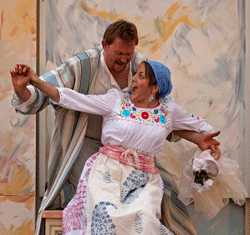 Nicholas Merryweather as Figaro and Emily Rowley Jones as Susanna
Nicholas Merryweather as Figaro and Emily Rowley Jones as Susanna
The plot may be immediately recognisable but the characters wear different musical costumes. The young cast were uniformly accomplished and committed; theatrically convincing and consistent, they really entered the spirit of piece, indulging its light-weight humour but also intimating its darker currents. There was a spontaneity and freshness about the on-stage choreography: thus, the ‘parade’ of characters during the overture, which might have seemed contrived, in fact captured a naturalist ‘busyness’ and sense of domestic intrigue. We were given a series of miniature cameos — a sort of cinematic role call — immediately and economically capturing each character’s essential temperament: Figaro’s confident ingenuity, Susanna’s cleverness, Bartolo’s grumpiness and the Countess’s quiet gravity.
Performing his second Bampton Figaro (he appeared as Paisiello’s barber in 2005), Nicholas Merryweather stood out: clear, firm and relaxed of tone, his diction was superb (no mean feat in this venue) and he exhibited a musical and dramatic confidence and ease which surely indicate great successes to come. In his programme notes, David Cranmer explains that, even if Portugal had been familiar with Mozart’s score, it would not have served as a good musical model, for his concise arias — with their energetic accompaniments — would not have provided sufficient opportunity for the singers to show off their virtuosity. Portugal’s first Susanna was Teresa Strinasacchi, evidently a soprano of first-rate technique and expansive range; but Emily Rowley Jones had no difficulty dispatching the demands of Susanna’s sparkling coloratura. Her intonation was unfailing true and her tone engaging.
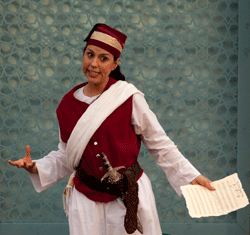 Joana Seara as Cherubino
Joana Seara as Cherubino
I first saw this production at Bampton Deanery Gardens, in July, a picturesque outdoor venue which was perfectly placed to capture the ambience of seductive conspiracy, and I was a little worried how it would transfer to the confined space at St John’s, with its theatrical restrictions and limitations. Interestingly, the result was in fact a tighter sense of theatrical timing and movement. Moreover, some of the characters seemed positively to benefit from the more intimate stage space — John-Colyn Gyeantey’s Count, in particular, presenting a much more focused reading of the role. The rather blundering buffoon-like figure from Bampton was here replaced by an angrier, more severe Count, of greater musical and dramatic stature. Previously, I had found his tone rather unyielding, but now he discovered a weight and compass which greatly enlarged the scope of the part and enhanced the dramatic tension.
The role of the Countess seems to have been constrained by the technical limitations of the first interpreter, Rosa Canzoni; and this is a shame as it would have been nice to have heard more of Lisa Wilson’s sweet, composed tone, which blended so beautifully with Rowley Jones in their Act 2 duet.
A gamine Joana Seara pouted and cringed as the frustrated, gauche Cherubino, but while her upper register dazzled, I sensed a slight hard-edge to her tone, particularly in Act 1. Robert Winslade Anderson bellowed warmly as the vivacious, mischievous music-master; Basilio’s drunken karaoke to the pleasures of women was riotously delivered, eliciting the snide put-down, ‘His music’s worse than Mozart …’ from a contemptuous Figaro. Mark Saberton’s Bartolo and Cara Curran’s Marcellina completed the gifted cast of principals; and Edmund Connolly (Antonio) and Caroline Kennedy (his daughter, Cecchina), delivered these minor roles in charming and accomplished fashion.
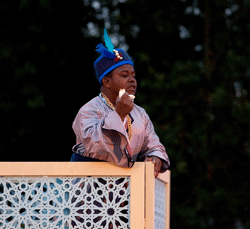 John-Colyn Gyeantey as Count Almaviva
John-Colyn Gyeantey as Count Almaviva
The sets were devised by Jeremy Gray, Mike Wareham and Anthony Hall, and the lighting design deserves especial mention, with its striking contrasts of bright complementary shades — deep blue suggesting the seductive light of the moon against a rich Seville orange evoking the balmy warmth of both the climate and burgeoning passions; emerald green intimating the cool composure of the Countess juxtaposed against deep purple suggestive of erotic ‘Turkish delights’.
The orchestral players were positioned behind the Moorish screens which effectively portrayed Almaviva’s Andalucian palace, but despite this placement, the ensemble between stage and ‘pit’ was surprisingly good; only occasionally did one or two of the singers slightly anticipate — which was surprising as Robin Newton, conducting the lucid, bright London Mozart Players, urged the action along at a brisk pace, whirling us through the first act and establishing an exciting dramatic momentum. Indeed effectively he revealed the dynamic quality of some of Portugal’s ensembles, particularly at the end of Act 1 and during the chaotic shenanigans of the Act 2 sextet.
Leaving the church, one patron was heard to remark, ‘I really hadn’t expected the music to be so good’. In fact, he should not have been surprised: Bampton Classical Opera are committed to reviving works of genuine musical and dramatic value. Their courageous repertoire is meticulously researched and selected, and thoughtfully and inventively staged.
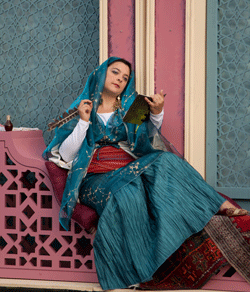 Lisa Wilson as Countess Rosina
Lisa Wilson as Countess Rosina
Bampton have give us Paisiello’s Barber and Gazzaniga’s Don Giovanni (1997 and 2004). What’s to come? A neglected Così? Portugal’s Figaro is unlikely to replace Mozart’s barber in the opera-going public’s affection, but his joyful opera is definitely worth hearing. It may lack the intensity of Mozart’s complex dramatic ensembles but its chain of charming arias and duets reveals rich musical resources and engaging invention. It is not merely a ‘curiosity’ but a work of considerable operatic merit — and it’s a pity that not more of the British opera press were here to enjoy it.
Bampton Classical Opera perform Thomas Arne’s The Judgement of Paris and extracts from Alfred at Wotton House, Buckinghamshire and The Holywell Music Room in November 2010. Gluck’s Il parnasso confuso will receive its UK première at the Purcell Room, London in June 2011; and at the Buxton Festival 2011 the company will present Cimarosa’s L’Italiana in Londra.
Claire Seymour
image=http://www.operatoday.com/Marcos_Portugal.gif image_description=Marcos Portugal. Anonymous miniature dating c.1790-1795 [Source: Marcos Portugal] product=yes product_title=Marcos Portugal: The Marriage of Figaro product_by=Figaro: Nicholas Merryweather; Susanna: Emily Rowley Jones; Count Almaviva: John-Colyn Gyeantey; Countess Almaviva: Lisa Wilson; Cherubino: Joana Seara; Dr Bartolo: Mark Saberton; Marcellina: Cara Curron; Don Basilio: Robert Winslade Anderson; Antonio: Edmund Connolly; Cecchina: Caroline Kennedy. Conductor: Robin Newton. Director: Jeremy Gray. Bampton Classical Opera with the London Mozart Players. St John’s Smith Square. Thursday 7th October 2010. product_id=Above: Marcos Portugal. Anonymous miniature dating c.1790-1795 [Source: Marcos Portugal]All photos by Anthony Hall courtesy of Bampton Opera
Dame Joan Sutherland, Diva Who Sang Mad Lucia, Dies in Switzerland at 83
By Manuela Hoelterhoff [Bloomberg.com, 11 October 2010]
Joan Sutherland, a large-boned, helmet-haired, high-singing Australian soprano with a perfect trill died at age 83 in Switzerland, her refuge after decades of singing unhinged maidens, enraged priestesses, and happy-go- lucky waifs.
Plácido Domingo, Gustavo Dudamel together for the first time
By David Ng [LA Times, 11 October 2010]
As the sun went down Sunday evening, two of the biggest stars in the classical music world shone bright to an adoring audience of fans who gathered to bask in their radiance. Plácido Domingo and Gustavo Dudamel have been next-door neighbors on Grand Avenue for more than a year, but on Sunday they shared the stage for the first time.
Promised End, Linbury Theatre, London
By Richard Fairman [Financial Times, 11 October 2010]
The tragedy of King Lear casts a long and dark shadow. Few composers have successfully turned Shakespeare’s play into an opera: it was one of Verdi’s most treasured projects, but he never brought it to fruition, and Aribert Reimann’s Lear, widely performed at the end of the 1970s not least thanks to Dietrich Fischer-Dieskau’s championing of the title role, is less visible now.
October 10, 2010
Anonymous 4: The Cherry Tree
However, from a musical standpoint, the rich repertory of fifteenth-century English carols requires that we look much further back to uncover the historical roots of much of our modern Yuletide singing. And this collection by the superb vocal quartet, “Anonymous 4,” who now approach a quarter century of inspired music-making, makes uncovering those roots a particularly congenial task.
The fifteenth-century English carol was diverse in its subject matter: the expected Christmas texts co-exist with carols commemorating the Passion of Jesus, for instance, or the military victory at Agincourt. But it is the tie to Christmas that has endured. This idea of continuity helps to shape Anonymous 4’s program, as they place Anglo-American folk hymns and early American tunes in counterpoint with the early English carols, a programmatic touch that allows the ear a measure of “intertextuality”—hearing one thing with at least a contextual reference to another. It is a dynamic approach whose variety helps to keep the ear sharp, the mind open to new connections, and also one that draws on the expansion of Anonymous 4’s repertory in recent years. Though best known for their work in late medieval music, with the recording of “American Angels” (HMU 907326 [2004]) and “Gloryland” (HMU 907400 [2006]), they added traditional American music to their musical array, and The Cherry Tree handily bears that fruit.
The fifteenth-century ensemble carols combine refrains and more thinly scored verses in a fluid rhythmic style, sparked by the lilt of cross rhythms and graced with the new consonant sounds of Renaissance harmony. The singing here is free and vibrant, but with a compelling edge to the sound that keeps things well in focus. The middle-English pronunciation contributes much to the color of the sound, as well. The Anglo-American music adopts a different sound, marked by the ornamental “scooped” inflections of traditional singing, inflections that Marsha Genensky renders with particular naturalness and command in her solo version of the “The Cherry Tree Carol.” As the period pronunciation adds such distinction to the early carols, one might wonder if a richer early-American palette might have been used to similarly good effect here. Certainly the singers were mindful of the issue: the American songs are pronounced with a discernible looseness that is surely intentional, as are the lengthened “r’s” and the occasionally richer diphthongs. But in the end, a less conservative approach might have offered a more colorful effect.
Each of the four singers has a solo track, and the opportunity to hear the four individually is one to savor. Ruth Cunningham’s wonderfully contoured notes, Jacqueline Horner-Kwiatek’s exquisite control and warm tone, Susan Hellauer’s intimate clarity of sound, and Marsha Genensky’s impressive command of idiom remind that although the ensemble is perhaps an entity greater than the sum of its component parts, those component parts are stunning in their range of gift. In this particular case, a Christmas gift that we should not wait to unwrap.
Steven Plank
image=http://www.operatoday.com/HMU_503544.png image_description=The Cherry Tree: Songs, Carols & Ballads for Christmas product=yes product_title=The Cherry Tree: Songs, Carols & Ballads for Christmas product_by=Anonymous 4 product_id=Harmonia Mundi HMU 807453 [SACD] price=$14.99 product_url=http://www.arkivmusic.com/classical/album.jsp?album_id=503544Rossini’s Otello at Rossini in Wildbad Festival, 2008
In explaining the relative obscurity of Rossini’s version of Shakespeare Moorish tragedy, Kern contradicts himself more than once, often within a couple lines: “It is still performed widely in the opera-houses of today” is soon followed by “Revivals of Otello in the modern era, the first of which took place as late as 1954, have not been so numerous as might have been expected.”
Exactly whose expectations that may be, other than the writer’s, remains unclear. Even if one proposed the tragic loss of Verdi and Boito’s masterpiece from the canon, Rossini and librettist Francesco Maria Berio di Salsa’s version would probably be no more frequently staged today than, say, Zelmira or Semiramide (even Kern admits that in the years just before Verdi's Otello, Rossini’s version had already become a rarity). The style and tropes of Rossini’s “serious” operas simply haven’t aged well, and whereas patches of indifferent music don’t really hurt the comedies much, the lack of dramatic tension in the serious operas can make for some sad musical longueurs.
The problem in the first two acts in particular is that the rigorous demands of opera construction at the time mean that the story advances oh so slowly, as each character is introduced and has his or her own number. By act three, however, Rossini is at his best, and the loveliness of Desdemona’s final scene really does rival that of Verdi’s. Jessica Pratt takes this role and exhibits a warm, sweet voice of real quality. Among a large group of high-lying tenors, Michael Spyres in the title role stands out with a richer, more baritonal quality. His scenes with Jago, another tenor, don’t have the fierceness of those between Verdi's Otello and Iago, however. There is no Cassio in this fairly different telling of the story; Rodrigo has a significant part, and Filippo Adami — yes, another tenor — has a pointed, tart voice perfect for the role.
This is a live recording, from the 2008 Rossini in Wildbad Festival. Don’t worry about the defects of many live recordings — stage noise is minimal, and voices are well-captured in a natural mix with the orchestra. Antonino Fogliani leads the Virtuosi Brunensis forces, and they produce a warm, propulsive account, although not always with perfect intonation.
Intrepid shoppers may be able to find the studio version of this opera from a couple decades back, with Jose Carreras. For anyone else interested in this rarity, this version should suffice. The cast may not be familiar, but they are fresh and dedicated to their roles. And then there’s the Naxos price. No libretto is included; the essay joins a detailed synopsis and artist biographies, in English and German.
Chris Mullins
image=http://www.operatoday.com/Naxos_8.660275-76.gif
image_description=Gioachino Rossini: Otello
product=yes
product_title=Gioachino Rossini: Otello
product_by=Otello: Michael Spyres; Desdemona: Jessica Pratt; Jago: Giorgio Trucco; Rodrigo: Filippo Adami. Virtuosi Brunensis. Conductor: Antonino Fogliani.
product_id=8.660275-76 [2CDs]
price=$16.99
product_url=http://www.arkivmusic.com/classical/Drilldown?name_id1=10388&name_role1=1&comp_id=247207&genre=33&bcorder=195&label_id=19
Oxford Lieder Festival 2010
At Oxford Lieder, you can can experience what Schubertiades may have been like. In Oxford, most concerts take place in the Holywell Music Room, built in 1740, the oldest dedicated public recital space in the world. The building seats only about 100 people. Seats are arranged on three sides, the platform extending into the room Interaction between performers and listeners is intense, much more direct than in an ordinary concert hall.
Moreover, the atmosphere is as intimate as the Schubertiades would have been. Oxford Lieder feels like “family”, since it’s so nurturing and supportive. People come together here because they’re united in their love of the genre and want it to thrive. An intimate genre like Lieder can’t — and perhaps shouldn’t — generate mass sales. Funding is backed entirely by private and trust contributions.
The opening recital on 15th October features Wolfgang Holzmair with Julius Drake, performing Schumann. Indeed, all through the festival there will be Schumann recitals and events, including “Lunch with Schumann” — refreshment for the soul!
A measure of how far the festival has come is that it has been able to co-commission Ned Rorem to write a song “My Love is a Fever”. The Prince Consort, who specialize in Rorem will give the premiere on 21st October, at which a second co-commission, a setting of Rilke by pianist Stephen Hough will also be unveiled. The Prince Consort, whose members include Jacques Imbrailo, have been associated with Oxford Lieder almost from the start.
Oxford Lieder programmes blend well known with unusual repertoire. This year part-songs figure prominently and Schubert settings for guitar (Christoph Denoth and Nathalie Chalkley). Katarina Karnéus and Julius Drake perform Grieg, Sibelius and Ture Rangström There’ll be an evening of Polish song with Maciek O’Shea and Festival Director Sholto Kynoch. Hugo Wolf’s complete Mörike setting will be heard over two days. Among the singers this year are : James Gilchrist, Anna Grevelius, Sophie Daneman, Stephan Loges, Felicity Palmer, Sophie and Mary Bevan, and Jonathan Lemalu. Oxford Lieder has a reputation for spotting new talent early on, and many of its “discoveries” return loyally.
Ian Partridge leads this year’s main Masterclass programme, but this year there are three, the others, led by Stephan Loges and Henry Herford, encourage non-professionals to enjoy the experience of singing. There are schools events and even an open air Brahms and Schumann concert. Oxford Lieder is much more than an annual festival — it’s aims are long term and benefit the wider community.
For more information, please visit the Oxford Lieder site.
Anne Ozorio
image=http://www.operatoday.com/Holywell_Music_Room.png image_description=Holywell Music Room in Oxford, England [Source: Wikipedia] product=yes product_title=Oxford Lieder Festival 2010 product_by= product_id=Above: Holywell Music Room in Oxford, England [Source: Wikipedia]Schumann: The Complete Symphonies, Mahler Edition
Based on performances give between 2006 and 2007, specifically: Symphony no. 1 (13-16 February 2007); Symphony no. 2 (30 August to 9 September 2006); Symphony no. 3 (30 May to 2 June 2007; and Symphony no. 4 (26-28 October 2006). As such, the four symphonies offer a unified reading of the scores in the versions Mahler retouched, and which David Matthews describes in the liner notes included with this recording. Leaving aside for the moment some of the critical stances on Schumann’s orchestration, the present recording is valuable in conveying the scoring that Mahler used and in doing so suggesting some aspects of the later composer’s approach to these works. While revised the orchestration of these works, he did not revise them so drastically as to create new arrangements of the scores. Rather, he revised the brass and woodwind parts, as well as added indications for effects, like stopped horns, etc.; his efforts included adjusting dynamic markings, and other details that allowed him to interpret these symphonies from the podium. The result is a Mahlerian approach to these works, with various timbres and balances calling to mind sonorities Mahler himself would use. In this sense it requires a conductor familiar with both composers to bring these scores to life, and the esteemed Mahlerian Riccardo Chailly has done some impressive work in these performances.
The content of the pieces is wholly Schumann’s, but the orchestral touches reflect subtleties that Mahler wanted to bring out. As much as Mahler’s revisions clarify some passages, they also suggest the way he would approach the orchestra and, in a larger sense, the stance a conductor from the late nineteenth century would offer on these scores from the middle of the century. Some of the details reflect a reliance on woodwinds and brass that was not used or, in some cases, not possible during Schumann’s lifetime. In this sense, these scores are Schumann realized for a new generation, when the orchestral sound shifted from its reliance on the strings as the core sound to a more diversified timbral palette. A telling point for this is the first movement of Schumann’s Third Symphony “Rhenish,” in which the horns and woodwinds differ from the conventional way this piece is played. Mahler’s orchestral dialect articulates Schumann’s text well, and this movement is a fine example of the value of this recording.
Those familiar with the traditional scoring of the Second Symphony may find some palpable differences in Mahler’s scoring of that work, especially in the final movement. As moving as this Symphony is, it takes on different colors with the revision, which bears rehearing with some of the traditional recordings of the piece in the extant discogtraphy. A fine point of comparison is the venerable recording by George Szell, or even the more recent set of Schumann’s symphonies that Eliahu Inbal recorded. In this new recording of Mahler’s revision, it is also possible to hear Chailly’s perspective on these works, a factor which is yet another benefit of this set.
As to these performances, Chailly demonstrates well his concepts of Schumann’s symphonies and also his sense of style with Mahler’s music. With slow introductions, as with the first movement of the First Symphony (“Spring”), the contrast in tempo may seem drastic at first, but it works well as the energetic theme of the first section moves forward and contributes to the convey the emotion suggested in the score. In rendering the scoring of this piece Chailly brings a sense of lightness that fits the character of the music. Elsewhere, as in the slow movement of Schumann’s Second Symphony, the structure of the music emerges readily and persuasively. Likewise, the Third Symphony (“Rhenish”) works well, in this fresh and dynamic reading of the piece which is evident from the start. The solemnity suggested in the fourth movement (marked “Feierlich”) is in earnest, and never a caricature. In these movements and the others Chailly balances nicely the music of Schumann with the editorial stance of Mahler, while never allowing the pieces to become studied.
This set of Schumann’s symphonies has much to recommend on the part of both composers. Not merely a curiosity or a novelty, the revisions that Mahler himself believed were important are certainly given such credence in this set of authoritative readings by Chailly. Moreover, the playing by the Gewandhaus Orchestra is engaging throughout, with a supple, inviting sound that brings the score to life. The two-disc set is a convenient vehicle for this intriguing release.
James L. Zychowicz
image=http://www.operatoday.com/Decca_2106214.png
image_description=Robert Schumann: The Complete Symphonies (Mahler Edition)
product=yes
product_title=Robert Schumann: The Complete Symphonies (Mahler Edition)
product_by=Leipzig Gewandhaus Orchestra, Riccardo Chailly, conductor.
product_id=Decca 478 0037 [2CDs]
price=$17.99
product_url=http://www.arkivmusic.com/classical/Drilldown?name_id1=10915&name_role1=1&name_id2=56182&name_role2=3&name_id3=62168&name_role3=4&bcorder=431&comp_id=2722
Technicolour Radamisto at ENO
Images of Asia proliferate polygamously — Mughal India, Tokugawa Japan, and Chinese restaurant chic, tumbled randomly together. The text, of course, mentions Armenia. Visual indigestion, if you’re culturally aware. But to Handel and his audiences, specifics didn’t matter. Radamisto is a morality tale which transcends time and place.
Tiridate (Ryan McKinny) lusts for Zenobia (Christine Rice) who’s happily married to Radamisto (Lawrence Zazza). To win her he’ll drop his wife Polissena (Sophie Bevan) and usurp Farasmane’s kingdom (Henry Waddington). But Zenobia’s having nothing of it. She’d rather die than be unfaithful. Subplots and complications (they’re all family, for example) are decorative embellishments. The basic message is surprisingly simple: love overcomes all.
This fundamental chastity pervades the whole opera. Structurally, it’s very tight. In neat succession, set piece arias follow one another, allowing each singer to display his or her vocal virtuosity.Simplicity of form, allowing inventive elaboration without blurring the basic line. Much like the set designs. Despite being floridly over the top, these designs are much more minimal than appear at first.
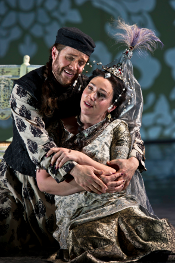 Christine Rice as Zenobia and Lawrence Zazzo as Radamisto
Christine Rice as Zenobia and Lawrence Zazzo as Radamisto
Lawrence Zazzo’s Radamisto is superb. His tessitura isn’t forced but
flows well, carefully modulated and well-judged, important in a role which
stresses integrity. The extended rhapsody on honour is particularly striking,
decorations extending each word, yet flowing naturally, without affectation.
You marvel at the inventiveness, but also meditate on meaning. Honour does
matter, Radamisto keeps saying as he and Zenobia amply demonstrate. These
aren’t just “words”, dwelling on them serves a moral as well as artistic
purpose.
The contrast between Radamisto and Tiridate is enhanced counterbalancing Zazzo’s countertenor with Ryan McKinny’s bass-baritone. In baroque, low voices often signify villains, but McKinny doesn’t overdo the inherent power in his voice. Instead he relies on subtle expression, using agile legato. In any case, refinement enhances the role. Tiridate holds a sword poised to kill Radamisto, but the long, lyrical elaboration deflects the menace, Reality, in Handel, is deeper than it seems on the surface.
Christine Rice is exquisitely dignified and gracious. In Carmen, she seemed inhibited, and even as Ariadne in Birtwistle’s The Minotaur she didn’t access the kinkier aspects of the role. As Zenobia, however, she’s ideal. Her patrician reserve perfectly fits the role, so she can create Zenobia’s compelling beauty with her voice. Sophie Bevan’s Polissena and Henry Waddington’s Farasmane impressed too. Ailish Tynan’s Tigrane reached notes higher than might be expected.
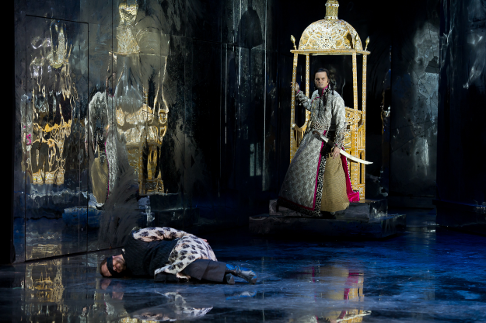 Scene from Radamisto
Scene from Radamisto
So what was my biggest misgiving about this production? David Alden depicts Tigrane as a grotesque, a camp cross between Sidney Greenstreet and King Farouk, but for no conceivable purpose. Is he trying to inject comic humour? Perhaps it works in a grubby sort of way but it jars with the noble import of this opera. The whole point, for Handel, was to edify. The idea of morality trouncing tyranny was inherently racy in a time when absolute monarchy still held sway. Besides, Tigrane is arguably a hero since it’s he who selflessly resolves matters. This portrayal is misogynistic and homophobic, completely pointless. Admittedly it was part of the 2008 Santa Fe premiere but it’s still deeply offensive and should be dropped.
What Alden lacks in sensitivity, Laurence Cummings made up for with the orchestra, who played with brio under his direction.
Anne Ozorio
image=http://www.operatoday.com/Radamisto_Sophie_Bevan_Ryan_McKinny_credit_Clive_Barda.png image_description=Ryan McKinny Tiridate and Sophie Bevan as Polissena [Photo by Clive Barda courtesy of English National Opera] product=yes product_title=George Frederick Handel: Radamisto product_by=Radamisto: Lawrence Zazzo; Zenobia: Christine Rice; Tiridate: Ryan McKinny; Polissena: Sophie Bevan; Farasmane: Henry Waddington; Tigrane: Ailish Tynan. Lawrence Cummings: conductor. Orchestra of the English National Opera. David Alden; Director; Gideon Davey: Designer. Rick Fisher: Lighting. English National Opera, the Coliseum, London. 7th October 2010. product_id=Above: Ryan McKinny Tiridate and Sophie Bevan as PolissenaAll photos by Clive Barda courtesy of English National Opera
October 9, 2010
Washington National Opera's edgy new 'Salome'
By Terry Ponick [Washington Times, 9 October 2010]
WASHINGTON — The Washington National Opera (WNO) debuted its intriguing new Francesca Zambello-led production of Richard Strauss’ Salome this past Thursday evening at the Kennedy Center’s Opera House. Like the company’s previous production, Verdi’s Un ballo in maschera, WNO’s Salome, starring famed soprano Deborah Voigt, was as notable for the high quality of its singing as it was for the astoundingly cheap look of its single, budget set.
October 8, 2010
Bieito's Muted 'Carmen' Brings a Fresh Vision
By J. S. Marcus [WSJ, 8 October 2010]
BARCELONA—If you love classical music, then you love Georges Bizet's "Carmen." A flop when it premiered in Paris in 1875, the opera quickly installed itself as one of the most popular in the repertory. With its unabashed depiction of Seville low-life, and top-heavy with irresistible hits like the "Toreador Song," the opera was seen as a perfect fusion of the realistic and the hummable. After more than a century as an opera-house workhorse, the music may be as lovable as ever, but actual productions aren't always very likable. Enter Spanish director Calixto Bieito.
El Gato con Botas: Gotham Chamber Opera
And quiver with emotion and vibrato when they sing on the ground? The title character of Xavier Montsalvatge’s El Gato con Botas (Puss in Boots) does just that, in the delicious production Gotham Chamber Opera has put together at the New Victory Theater just off Times Square, under the direction of Moisés Kaufman, with the Tectonic Theater Project creating the marionettes and other special effects. You hardly notice the singers at times, good as they are; the Cat (and, later, the Ogre), singing in the manner of Avenue Q, occupy all your attention.
On the evidence of this score, Xavier Montsalvatge, a Catalan modernist, was more national than modern. El Gato con Botas, delicately played by piano, strings, a few almost incidental woodwinds, is tuneful, angular, swift-moving, with a Spanish rhythmic pulse. There is much witty scene-painting and dancing, and the harmonies are attractive and piquant without falling into cliché. The piece has character, but its scenic demands no doubt give opera companies pause. There’s a lively cat who dresses very well—sword, cape, plume, boots and, in an underwater ballet in this production, snorkel. There’s a rescue from the river. There’s an Ogre who transforms himself into a lion, a parrot, and a rat. (El Gato has evidently attended Das Rheingold to pick up fairy tale stratagems—or else Wagner had read his Perrault.) There’s a rabbit hunt, and lots of rabbits.
None of the magic gives the production team at the New Victory any difficulty—scene-changing interlude music just provides more opportunities for madcap special effects, and transformations are what the game is all about. There is some kowtowing to the idea that it’s a kids’ show, and several matinees in English translation are part of the run (I preferred to attend one of the performances in the original Spanish), but the kids ae just a cover story. The sophistication of the humor, the charm of the musical presentation, the dizzy delights of the occasion are much too good to waste on kids, however much they are sure to love it.
Gotham has provided multiple casts. On opening night, Ginger Costa-Jackson “voiced” El Gato, standing self-effacingly aside as the scrawny marionette leaped to capture notes high in the air. Nadine Sierra sang a dulcet princess; Craig Verm a heroically befuddled miller/marquis with a pleasant growl to alarm any cat to heroic deeds; Kyle Pfortmiller made a smug monarch, his head atop a tiny, strutting body; and Kevin Burdette was unusually serene for an Ogre whose body starts in disassembled body parts, before he comes together to threaten our feline hero. (You know the kids are going to love singing, twirling, headless body parts.)
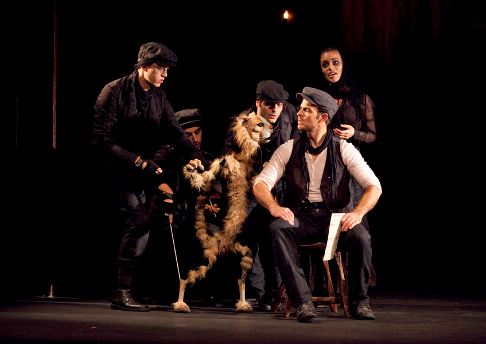 Jonothan Lyons; Aaron Schroeder and Stefano Brancato (puppeteers); Craig Verm (Miller vocalist) and Ginger Costa-Jackson (Cat vocalist)
Jonothan Lyons; Aaron Schroeder and Stefano Brancato (puppeteers); Craig Verm (Miller vocalist) and Ginger Costa-Jackson (Cat vocalist)
Where has this delicious little score with its spoof-ballets and arias been hiding all these years? I guess it’s been waiting, like a princess in a tower, for a company creative enough to set it free.
John Yohalem
image=http://www.operatoday.com/El_Gato_Gotham.png image_description=The Ogre [Photo by Richard Termine] product=yes product_title=Xavier Montsalvatge: El Gato con Botas product_by=Cat: Ginger Costa-Jackson; Princess: Nadine Sierra; Miller: Craig Verm; King: Kyle Pfortmiller; Ogre: Kevin Burdette. Production by Moisés Kaufman and Tectonic Theater Project; Gotham Chamber Opera, conducted by Neal Goren. Performance of October 1. product_id=Above: The OgreAll photos by Richard Termine
Das Rheingold, Metropolitan Opera
It is impossible to watch certain scenes of this Das Rheingold without having one’s heart in one’s mouth, and that owes nothing to the vocalism (on the whole pretty good), much less the orchestral playing (a familiar quantity). This set is complicated and dangerous, and no matter how precisely they set the computer programs and check the body harnesses—something will go wrong someday.
And you know? If the music-making continues on this level, and the portrayal of Wagner’s story does too, it will be worth it. Death comes to all; it might as well be a glorious death in full view of a paying audience, just like Ancient Rome in pagan fantasy. At least so long as no major singer is concussed in the accident, it will be worth it. The shenanigans involve plenty of stunt-doubles, and admirable as their work is, this is music-drama: Prosaic throats are expendable.
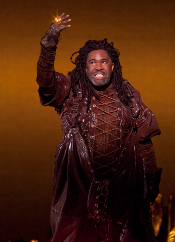 Eric Owens as Alberich
Eric Owens as Alberich
These were my first thoughts at the Met’s new Das Rheingold
last Thursday, in those rare moments when I could catch my breath to think of
other things. Lepage’s staging is busy—things are happening every
moment, in the mobile sets and intricate lights when not among the characters.
The singers, too, are obliged to hurl themselves about, emoting, slithering,
doing magic tricks. The fierce heat of these unpleasant people (who are not
people at all, but archetypal figures) makes itself felt, as if this were some
through-composed Clifford Odets drama of too many generations cramped in some
New York apartment, snarling and grudging and hacking at each other. Perhaps
the family will calm down when they move into their grand new digs. That seems
to be the plot.
The stars of Lepage’s show are a row of aluminum planks that, aided by wildly creative lighting, portray a flat floor, a rippling river, a cavernous ceiling, a raked rampart, a vertical redoubt, a staircase through the sky. This is the most versatile floor since Jackson Pollock tripped over a few cans of paint and hung the result on his gallery wall. It could probably sing creditably. (Alas, it does squeak at times. Pay no attention—pretend it’s somebody’s cell phone.)
Stunt doubles are used to create many of the effects, and this is obvious if you think about it: First of all, no singer could slide down the steep rake of the stage in a credible imitation of body-surfing the air stream, and then pop up singing as Freia, Froh and Donner do in scene 2. Then, at the end of scene 4, we find ourselves (in the audience) apparently suspended in mid-air over the rainbow bridge, a rippling multi-spectrum light-show, up which the gods (but it’s their doubles; as the Fricka is only about one-third as broad as Stephanie Blythe) march slowly, held by guy wires from above. Got that? We are perpendicular to the stage action, which defies gravity. And when the gods have at last ascended (or crossed the bridge) to Valhalla, the “bridge” is raised like a drawbridge to become the gate in the stone wall of the fortress of the gods. It is the most exciting version of this climactic event that I’ve seen on any stage other than mind’s eye.
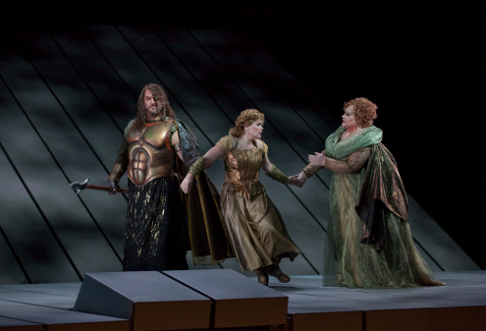 Bryn Terfel as Wotan, Stephanie Blythe as Fricka and Wendy Bryn Harmer as Freia
Bryn Terfel as Wotan, Stephanie Blythe as Fricka and Wendy Bryn Harmer as Freia
This finale makes up for several things that do not work: the ransom of Freia (here a hammock in which she is far from concealed by a bunch of golden bric-a-brac), the offhand murder of Fasolt, the awkward upside-down shenanigans of the aerial Rhinemaidens. In contrast, the Dragon and the Frog are quite fine, Wotan and Loge’s stroll across the sky to Nibelheim is heart-in-the-throat stuff, and the apparition of Erda is effective. I found it the most successful new production to grace the Met during the tenure of Peter Gelb, and am eager to behold the rest of Lepage’s Ring.
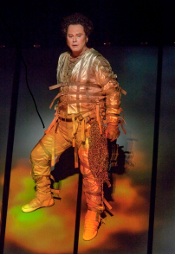 Richard Croft as Loge
Richard Croft as Loge
But a problem with this dizzying staging—for this Wagnerian—is
that the technological wizardry has gone to the director’s head. He shows
a predilection for “MTV” opera direction—for new events at
each new chord, every syllable, every new motif. We cannot relax into
Wagner’s stately rhythms; there is too much action. This is opera as
five-minute video or even a videogame (which seems to be the inspiration for
the superhero-styled costumes). After five minutes of it, one feels energized.
After an hour or two, the eyes are glazed, the attention worn thin. Can’t
we just listen to them sing for a while?
The singing for this Rheingold was of an impressive caliber. True, nearly all of it is performed from the stage apron, and is therefore likelier to fill the house than the same voices would do from deeper within the proscenium. But there’s no place for singers in the proscenium, because Lepage’s planks are floating in mid-air or something. The vocal standouts on Opening Night, as heard on the radio, were Stephanie Blythe’s authoritative Fricka and Richard Croft’s sensuous Loge.
In the house on the second night, though both singers produced sound superbly, and Croft won an ovation for his ability to sing much of his part while walking backwards up walls, both forfeited a degree of intimacy in the enormous space. Blythe has Fricka’s changeable moods down, from kittenish hypocrite to vigorous shrew and for my money she has owned the part since she first sang it in Seattle; I am eager to see how she develops in it. But Croft, better known for his superb Handel performances and the golden Gandhi he sang in Satyagraha, though he brought astonishing power to this essay in Wagnerism, sang this most ironic and human of Rheingold’s roles with an unvaried and uninteresting solidity. Where were those subtle shadings of double-meaning that we heard on the radio? Perhaps walking backwards up walls undermined the singer’s focus on vocal acting.
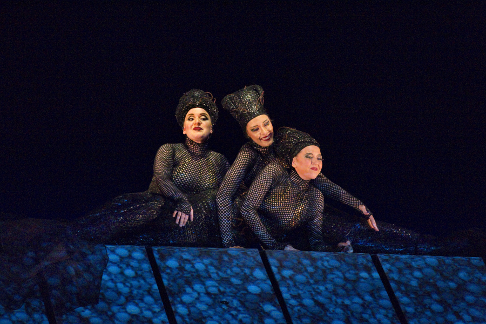 Lisette Oropesa, Jennifer Johnson and Tamara Mumford as the Rhinemaidens
Lisette Oropesa, Jennifer Johnson and Tamara Mumford as the Rhinemaidens
Bryn Terfel’s Wotan has been fondly anticipated and he looked good, piggy heroic, but I found him vocally underpowered. I missed the regal ease and bel canto polish of James Morris’s king of the gods, but this was a well-acted, carefully devised performance. Wotan may simply be too much for Terfel: In the final scenes, his throat dried and pitch failed him. He may figure out how to last through an entire Rheingold, but his showing made one fear for his Walküre.
A pleasant surprise was the Freia of Wendy Bryn Harmer, new to me, whose bright, clear, metallic soprano expressed the character’s hysteria without ever becoming shrill: a Brunnhilde-in-waiting, I’d say, and not bad looking in a short skirt either. Too, the staging calls for Freia to hop up on walls and race up and down hills, which she handled with aplomb. Patricia Bardon made agreeable sounds as Erda if not quite plumbing the primordial depths. I liked Tamara Mumford’s healthy vibrato as Flosshilde, but otherwise the Rhinemaidens sounded undistinguished, a fact one might not notice while they swing over vertiginous parapets in constricting costumes.
Eric Owens, who sang the destructive Nekrotzar in Le Grand Macabre last June, showed signs of frustration as yet another nefarious plot to conquer the world met comeuppance. Indeed, one has seldom seen so unpleasant an Alberich in Nibelheim, rather justifying the gods’ ill-treatment of him. Vocally, he was gruffly exciting—a smooth Alberich would be inappropriate—and the wild demands of the staging did not, in this case, undermine vocal acting: his curses were chilling; one felt the misanthrope’s internalized hatred of the persecuting world and his persecuting self. Indeed, I overheard those who would have liked to have him singing Wotan and Terfel Alberich, but I’m not sure the timbres quite overlap.
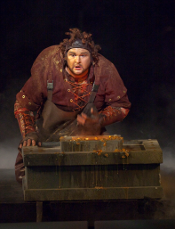 Gerhard Siegel as Mime
Gerhard Siegel as Mime
Gerhard Siegel made a winning, whining Mime, Franz-Josef Selig a
distinguished Fasolt and Hans-Peter König a thrilling Fafnir, making one eager
to hear him as König Marke and Gurnemanz in the not-too-distant future. Adam
Diegel and Dwayne Croft sang Froh and Donner honorably, but Croft needs to time
that hammer blow with more precision.
James Levine’s return to health put him in charge of the orchestra, and though the prevailing tempi were on the slow side and there were moments of bombast that could have done with a subtler touch—as I grow older I find myself preferring a cleaner, brisker sort of Wagner—this was the well-known Levine style with no falling-off, and the Met audience lapped it up. Gaunter and grayer than before, he is still beloved, not least by the orchestra he transformed into a wonder of the operatic world.
John Yohalem
image=http://www.operatoday.com/Terfel_Wotan.png image_description=Bryn Terfel as Wotan [Photo: Ken Howard/Metropolitan Opera] product=yes product_title=Richard Wagner: Das Rheingold product_by=Wotan: Bryn Terfel; Fricka: Stephanie Blythe; Freia: Wendy Bryn Harmer; Loge: Richard Croft; Erda: Patricia Bardon; Alberich: Eric Owens; Mime: Gerhard Siegel; Fafnir: Hans-Peter König; Fasolt: Franz-Josef Selig; Rhinemaidens: Lisette Oropesa; Jennifer Johnson; Tamara Mumford. Production by Robert Lepage. Metropolitan Opera Orchestra conducted by James Levine. Performance of September 30. product_id=Above: Bryn Terfel as Wotanbr/>All photos by Ken Howard/Metropolitan Opera
October 7, 2010
Bizet Les Pêcheurs de Perles - Royal Opera House
What was striking in this performance of Les Pêcheurs de Perles (Pearl Fishers) at the Royal Opera House was how delicate much of Bizet’s writing really is. It doesn’t jump up and grab you like the tunes from Carmen. Bizet knew little about India or Indian music but in his imagination, the exoticism signaled refinement. A petit Trianon East, perhaps, charming, but as authentic as 18th century “oriental” wallpaper. Since we nowadays know more of the reality, which affects our response to Bizet’s watercolours.
Dispense with the “orientalism” and think of Les Pêcheurs de Perles as French fantasy, and the opera falls into perspective. Kings and Priests dominate because peasants are superstitious, and think Holy Virgins will protect them. When the chorus sings of Brahma they could as easily be singing of Jesus. Getting away from literal images allows the music to make sense on its own terms.
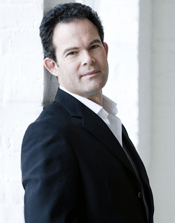 Gerald Finley
Gerald Finley
Antonio Pappano was wise to let this music breathe. Over-expansive gestures are best left to the histrionic narrative. Bizet imagines India in delicate, refined string textures, flute trills and gently beaten cymbals. Crescendi build up like swells in the ocean, diminuendos evoking refinement and submission. Lovely bell-like miniatures throughout evoking an idea of the East as perfumed and flower strewn as a church in France on a holy day. There’s more drama in this music than the opera is given credit for. Pappano elucidates what’s there, without pushing it past its limits. The delicacy of the playing let themes, such as those from the “big number”, resurface elusively throughout the opera, sometimes so subtle they can be overpowered by being made too obvious..
The Royal Opera House orchestra deserve more appreciation than they get, so it was good to see them on stage rather than hidden in the pit. Seeing the bare structure of the stage was instructive, too, a reminder of just how much art goes into making the fantasy of opera.
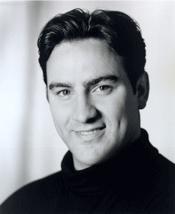 John Osborne
John Osborne
Leila is a part almost tailor-made for Nicola Cabell. She’s exquisite, and swathed in sapphire satin creates a character even before she sings. Pretty singing too., but the role, despite its charm doesn’t lend itself to great displays of passion. John Osborne’s Nadir was assertive and lucidly clear in the true French manner. His aria “Je crois entendre encore”, was beautifully shaped and balanced, the orchestra poised around it nicely, so it did feel “caché sous les palmiers.”
The duet “Au fond du temple saint” was very well realized by Osborne and Gerald Finley. Finley was by far the biggest name in the ensemble, however good Osborne, Cabell and Raymond Aceto’s Nourabad could be. More darkness would work better with Zurga, who is a very troubled man indeed, but Finley’s singing is so well modulated that he creates authenticity without much apparent effort.
Anne Ozorio
image=http://www.operatoday.com/Nicole_Cabell.gif
image_description=Nicole Cabell
product=yes
product_title=Georges Bizet: Les Pêcheurs de Perles
product_by=Zurga: Gerald Finley; Nadir: John Osborne; Leila: Nicole Cabell; Nourabad: Raymond Aceto. Chorus of the Royal Opera House (Director: Renato Balsadonna). Orchestra of the Royal Opera House. Conductor: Antonio Pappano. Royal Opera House, London, 4th October 2010.
product_id=Above: Nicole Cabell
Macbeth, Lyric Opera of Chicago
By George Loomis [Financial Times, 7 October 2010]
For its opening production of the season, Lyric Opera of Chicago followed the oddly fashionable trend of engaging a theatre director with no prior experience in opera. But Barbara Gaines has learnt a thing or two in nearly 25 years at the helm of Chicago Shakespeare Theater and stages Verdi’s Macbeth with few, if any, of the hallmarks of a novice.
Frenchman named music director of Washington National Opera
[AFP, 7 October 2010]
WASHINGTON — Experienced opera and symphony conductor Philippe Auguin has been named music director of the Washington National Opera, the group said in a statement Wednesday.
October 6, 2010
Gustav Mahler: Symphony no. 5
Mahler himself worked with Willem Mengelberg, whose annotated score contains markings that stem from conversations with the composition. This is the source for the information about the familiar Adagietto being a love letter to the composer’s wife Alma, and other details about the piece. That stated, the association of Mahler’s Fifth Symphony is borne out in various recordings during the century since the premiere of what is, perhaps, one of Mahler’s best-known symphonies.
This recording gives a fine sense of the textured sound of the Concertgebouw, with its uniformly strong sections and cohesive sound. This is readily apparent in the Scherzo, which is probably Mariss Jansons’ most successful movement in this recording. Here Jansons manages to navigate well between the shifting timbres of the score, which intersect the various sections of this multi-layered movement. The driving rhythms of the concluding sections underscore the dynamic changes which, in turn, reveal other changes in scoring. At times Jansons’s tempos are somewhat slower than some conductors choose, and this is useful in the Scherzo, where it allows the details become easily audible, particularly in the latter part of the movement. One of the pleasures of this recording is the clarity of the woodwind textures, not only in the Scherzo, but elsewhere. The figuration of the woodwinds in the second movement is effective, especially in the passages that Jansons takes at a somewhat slow tempo.
Likewise, the harp in the Adagietto helps to reinforce the chord changes in the strings and conveys a sense of a strummed aubade. Here, though, the rich textures of the lower strings are not strong enough to balance the treble sounds, which tend to dominate this movement. This is nonetheless a solid performance of this famous movement. It is never self-indulgent, but flows nicely to allow the vocal qualities of the structural model of the movement, Mahler’s Rückert setting “Ich bin der Welt abhanden gekomment” (“I am lost to the world”) to guide the interpretation.
In general, Jansons offers a reading of the Fifth that lacks some of the frenetic qualities that other interpreters sometimes bring to the work. Jansons lingers at time, and while he does not fail to bring the works to satisfying conclusions, it is never at the expense of sacrificing clarity or allowing figuration to become sound effects. In this sense, the pacing offers something that lends itself to the strengths of the Concertgebouw in presenting a uniformly solid sound and allowing it to blend nicely in this reading of Mahler’s score.
This kind of approach makes it possible to appreciate the interpretation of the Rondo-Finale, which is not as driven to reach the ending, as much as it revels in the means of getting to that point. Just as the chorale at the climax of the second movement ends rings nicely in this recording, Jansons sustains that effect in the last movement. The orchestral sonorities match the melodic and motive content to good effect. This is a thoughtful interpretation of this familiar work, which bears attention for the ways in which it offers a distinctive sense of Mahler’s Fifth Symphony, even with the interpretive distance implicit in the recording.
James L. Zychowicz
image=http://www.operatoday.com/RCO08007.gif
image_description=RCO Live CD08007
product=yes
product_title=Gustav Mahler: Symphony no. 5
product_by=Royal Concertgebouw Orchestra, Mariss Jansons, Chief Conductor.
product_id=RCO Live CD08007 [SACD]
price=$21.99
product_url=http://www.arkivmusic.com/classical/Drilldown?name_id1=7537&name_role1=1&comp_id=1803&bcorder=15&label_id=4759